#long distance travel? train plane or bus. short distance travel? train foot or bus
Text
Cars should be banned. No more cars allowed. We can walk, bike, bus, plane or train everywhere we need. No more cars.
#i almost got hit this morning by some fuckwad while i was walking home from the coffee shop#it was his turn to go ajd it looked like we were going same direction cuz he didnt have a blinker on#so i waited a second and he didnt move and didnt have a blinker so i started crossing#and when i was halfway through the intersection he fucking booked it and then stopped feet from me??#i shouted 'what the fuck are you doing?' and he said 'im sorry!' and i shouted 'go fuck yourself!' and he said 'im fucking sorry!'#so it was bad all around#and this is the third time ive almost been hit in like nine months. because people do not pay attention#theres too much distracted driving and bad driving and its all too dangerous so the only people driving should be buses#and i mean that so seriously#long distance travel? train plane or bus. short distance travel? train foot or bus#i hate cars so so much#if i had a genie wish it would legitimately be to get rid of cars
2 notes
·
View notes
Text
Day 1: Kia Ora and Welcome to Auckland!
Date of Reference: Sunday, 6/10/18 New Zealand (even though it was the middle of the afternoon on Saturday 6/9/18 US Central Time when I landed. Moving forward, I will use dates and times from the perspective of the local New Zealand time to keep things easier for me to keep track of. Isn’t time weird? Thanks celestial body movement and relativity!)
15 hours passed. I awoke to the gradual light that filtered its way from the front of the plane to the back. As I peered out the window, I continued to see darkness. All was calm. Then, the slight chime of the intercom filled the room like a soft alarm. It was the steward. “Kia Ora and good morning.” Kia Ora is a phrase New Zealand English has adopted from Maori culture (the Maori were the people that lived on the islands we now know as New Zealand long before European Colonization). Its literal translation is “be well/healthy”. The warmth of this phrase is infectious, and is a recognizable symbol of the warmth of my reception into the country, even if it was in the midst of the winter season at the time. I appreciated this change of temperature, however. Memphis had previously hit 89 degrees Fahrenheit each day. Being in a place that would maybe hit 60 degrees Fahrenheit at its highest was refreshing, to say the least.
As the plane touched down in Auckland, I disembarked down a ladder and onto the tarmac. After this, a courtesy shuttle pulled up next to the plane to transport me to customs. This happened to be similar to my connecting flight from Tokyo Haneda Airport to Akita, Japan. After the short 3 minute ride, I swiftly picked up my bag and got in line for customs. The most pressing questions I was asked was whether or not I had any food, animal goods, or outdoor equipment I would like to declare upon arrival. I mentioned that I had a pair of leather hiking boots. The customs official, while completely friendly and polite throughout our conversation, informed me that I must go through an additional biosecurity screening. I would soon learn firsthand that New Zealand takes biosecurity VERY seriously. I suppose this would make sense, as New Zealand, a small island nation, is often visited by foreign travelers for its pristine outdoor environments and activities.
Biosecurity took over an hour to get through, simply due to the number of international visitors arriving from various planes at the same time. Well… this, and the fact that there were only 2 customs officials manning the biosecurity tables/scanners initially. In retrospect, I’ll give the New Zealand Ministry of Primary Industries the benefit of the doubt. It was 6AM on a Sunday, after all. My training as an Industrial Engineer leaves me somewhat sensitive to situations like this, which can be frustrating at times. The line was long because of the disproportionate level of staff members to total queue length. This realization, coupled with the long flight, tried my patience. In spite of this, I maintained composure and worked to ensure I remained respectful and replied to the various instructions being received. Effectively, all I was really required to do at biosecurity was walk up to a 7-foot long metal table, open up my checked luggage, pull out my boots, and allow the customs officer to inspect the bottoms of my boots. Thankfully, they were still relatively clean (I can’t remember the last time I took a hike! This needs to change…). Had they been filthy, customs would have cleaned the boots before having me repack the bag. The only thing left to do was place the bag on the conveyor belt x-ray security machine and I was cleared to leave.

Auckland Airport resides in a southern subdivision of Auckland-proper. I was recommended to purchase a roundtrip ticket on the Skybus to get to the condo reserved downtown. After about 10 minutes of searching for the kiosk that sold SkyBus tickets, I managed to purchase a ticket and get on the bus. I was going to meet my girlfriend, Helen, and her family at the Airbnb condo from here, about a 26 km (a little over 16 miles) one way, which translates to roughly an hour of total travel time. As I got off the bus, I was standing in the midst of downtown Auckland near the bay. I could feel the gentle sea breeze chill my face as I followed some saved images from google maps to direct me to my destination. I am very glad I thought to do this while I was stateside. The airport only gave 45 minutes of complimentary wi-fi, and while the Skybus advertised free Wi-Fi, I was not permitted to access it as the cell number I had at the time could not receive texts originating from New Zealand according to the login authentication.
As I stumbled through some side streets, I came across a tall tower. The quiet of early morning vanished, and I heard someone shout “Chris!” from above. Helen’s mom happened to spot me walking up the street and flagged me down. I had arrived! I was actually surprised I managed to find familiar faces without access to the internet. This experience definitely reinforced the best practice of always having a backup plan for directional guidance. After rendezvousing with the Stritzels, I managed to drop off my bags, have breakfast, and then quickly turn around to the day’s main activity: visiting Waiheke Island.

As I mentioned earlier, downtown is quite close to the port, which has several ferries departing to the nearby islands. We quickly walked from the condo to the port, purchased tickets from Fullers for one of their ferries bound for Waiheke Island, and we were off in a flash. The map earlier in this post actually shows Waiheke. It is northeast of the downtown area and takes roughly 45 minutes to sail there. Waiheke is well known across New Zealand for its beautiful nature trails, award-winning olive oil, and picturesque wineries, all of which I was able to experience in one day.




We started the morning on the island with a hike. The original intention was to go to Whakanewha Regional Park. Though the hike we actually did included some wonderful trails that circled a lake wrapped by dense forests, we later learned that we were adjacent to the park while not technically being in it. To get to the forest, we disembarked from the ferry at the Fuller port located on the western part of the island. Then a bus pulled up and shuttled us more towards the center of the island. A breath of fresh air and some walking was welcome after previously being scrunched up in a metal tube for hours on end, followed by all the movement afforded me by the combined transit just mentioned. Though some would say we might have gotten a little turned around, I agree more with the popular adage: “Those who wander are not lost.” Admittedly, I think I was still ecstatic to be in a new place seeing flora and fauna I’d never seen before. Thin thatch filled evergreens blanketed the space as you can see, peppered with vibrant flowers, allowing the trail to feel like a whimsical meandering adventure!

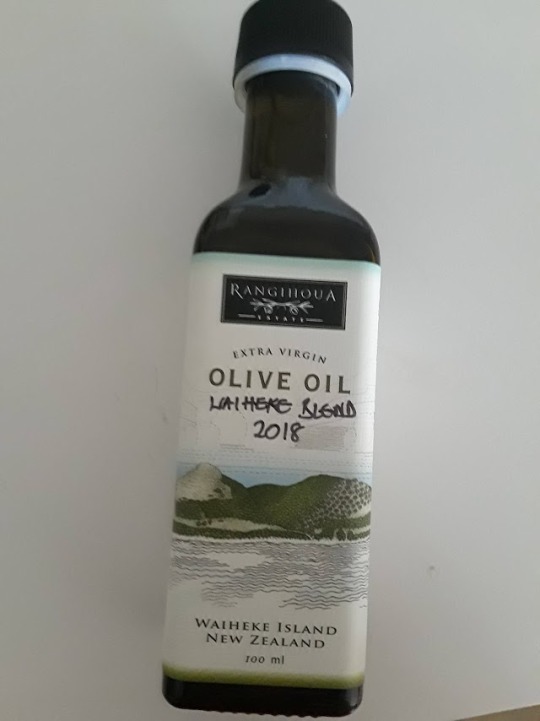
The trailhead emptied us out close to Rangihoua Estate. As I would come to learn, Rangihoua grows olives to create high-quality olive products, including some delicious olive oils. While visiting the estate, the proprietor offered us free olive oil tastings. As the proprietor explained each type of oil available to sample, she also spoke more about the thought process that goes into developing olive oil. One of the facts that stood out was that only a few nations in the world have the right climate necessary to grow the olives necessary to craft rich oils such as these. Of those nations, Italy, New Zealand, and the United States (Texas) made the list. The estate is so intentional in its mastery of the craft, in fact, that their blends are award-winning. The Waiheke Blend (pictured above) actually won a gold medal at the Royal Easter Show in Sydney, Australia. Rangihoua was also featured in the world renowned 2017 Flos Olei Italian Guide to the World’s Best Extra Virgin Olive Oil. If you’d like to find out more about the estate, feel free to follow this link:
https://www.rangihoua.co.nz/
It was getting to be around noon, and with the growl of the stomach came the search for lunch. The proprietor recommended we go to nearby Batch Vineyard. What I did not realize was how long the approximate 2 km hike would feel, especially since it was all uphill. The views at the end of the hike, however, were breathtaking…

Helen’s family decided to take in the views briefly before departing back towards the Waiheke port. They had already reserved a slot for a wine tasting downtown and had just enough time to still travel to where they needed to be. Helen and I decided to stay and enjoy lunch while taking in the views. The restaurant is actually directly behind the vantage point of the above scenic overlook. Our view from our table was spectacular to say the very least. While the food was decent, being able to sit down and take in the 360-degree views from atop Waiheke Island made this moment truly special. It may be difficult to see, but Auckland is visible in the distance around this area… (see below)

After lunch, the bus picked us up to return to Waiheke port. I was certainly tired from all the walking and exploring that just took place, and was a bit relieved to begin returning to the condo. The bus slowly meandered down the hill and around various curves. After a few stops, we made it back to port. I managed to snag a coffee while we waited for the ferry. Caffeine was welcome to help stave the allure of sleep. It was beneficial for me to stay awake to get myself better adjusted to the local time as soon as possible.

The ferry back to Auckland was peaceful. It was interesting to watch the various islands roll by my window. I found it interesting that there was a lone tree sitting in the middle of a field. It kept my attention until I lost sight of it. The gentle roll of the waves nearly soothed me to sleep. Good thing the caffeine kept me awake! We met back with the rest of Helen’s family at the condo and decided to have sushi at a nearby conveyor belt shop. This brought back warm memories of the many times Helen and I devoured a whole school of fish at Kappa Sushi in Akita (definitely not exaggerating here!) Feel free to read my earlier posts during my study abroad in Japan to see and hear more about conveyor belt sushi restaurants and other interesting Japanese things.
Well, that’s all for now folks! Day 1 was filled to the brim with fond memories and served as an excellent springboard into the rest of that wonderful week spent in New Zealand. Stay tuned for more posts soon!
1 note
·
View note
Text
Revisiting Pura Vida
for access to more photos and videos, visit: https://kyliebreenphotography.com/2020/05/01/revisiting-pura-vida/
Over two years ago I left the country for the first time in my life. I have always had a sense of wanderlust, known as a strong urge to travel. In April of 2018, I signed up for a mission trip to Costa Rica through my high school. Little did I know that my experience abroad would shape me completely (read more here). After experiencing the beauty and peace that I found everywhere in Costa Rica, I knew I would have to return to the place that holds such a special place in my heart.
This January I was fortunate enough to return to Costa Rica through pure luck. My father won a free vacation through his work and he was able to pick from a list of destinations. On that list was a trip for two to Costa Rica. After some serious convincing and a lot of procrastination on my family’s part on deciding where to go, we decided that my dad and I would go to Costa Rica (thanks Mom & Bro!).
My dad and I are the travelers of the family (considering my mom dislikes planes) because my dad has lots of experience traveling for work and I want to see the world. We planned our trip for two weeks, one week with the Caravan tour that he won and one week adventuring on our own. Caravan is a touring service that offers tours in several destinations at an affordable price. You can see the route we decided to take in the map below.

In January it is Costa Rica’s dry season which lasts from mid-November to May. The dry season typically consists of sunny, hot, and windy days. The Caribbean side, however, basically has its own weather pattern and is still rainy even during the dry season. The difference between the Carribean and Pacific side are vastly different which I will explain later in this blog.
GETTING READY
PACKING
I am definitely an overpacker when it comes to travel and the thought of a two-week long trip made me nervous. I started out by making a very long list of things I needed to bring and narrowed it down from there. Here are some key items that you should bring to Costa Rica:
Hats & Sunscreen: you must protect your skin from the blazing sun.
A Camera or GoPro: Costa Rica is absolutely stunning and you will want to capture the wildlife and landscapes, but remember that anything can be lost or sadly stolen when traveling so be extra cautious when brining valuables. I brought my camera and laptop and everything was fine, but on my prior trip I was advised to only pack what I needed. Don’t forget to pack your camera batteries, chargers, and memory cards.
Portable Charger: You never know when your phone will run out of juice so make sure to bring a portable charger so you’re always on the grid!
Bug Spray: There will be several hikes that will introduce you to some unwanted bug bites, so in order to avoid them make sure to pack some spray.
Water Bottles: The tap water in Costa Rica is mostly not safe to drink, so bring water bottles and fill them with fresh water from the grocery store instead. During our trip Caravan provided us with bottled water each day, but on our own we bought gallons of water and filled up our bottles before we left for the day. It is so important to stay hydrated when you are working up a sweat.
Comfortable Clothing: Keep in mind that comfort should come before fashion, especially in such hot weather. There are a series of activities that I did that required a change of clothes, so make sure to pack efficiently. We were able to use a laundromat during the trip so we did not have to pack as much! Make sure to pack hiking shoes, sandals, and water shoes because you will need them.
Toiletries: In many places we stayed, the hotel did not provide shampoo, conditioner, etc. so make sure to bring some of your own or check with where you are staying.
Journal: This may seem silly, but if you are someone like me and you have a bad memory, keeping a daily log of your activities will allow you to revisit your trip at any time.
¿HABLAS ESPAÑOL?
Costa Rica is primarily a Spanish-speaking country so it is a good idea to download a translating app onto your phone. A lot of Costa Ricans speak English as the country depends on tourism for their economy, but don’t expect everyone to. And it’s fun to learn a new language when it is everywhere around you! Go out of your comfort zone and try to ask questions in Spanish.
DATA PLAN
Many data plan providers have an international plan that you can sign up for, but a cheaper option is to buy a new SIM card while you are in Costa Rica. My dad is a tech wizard and he can explain this way better than me, but buying a SIM card is a more affordable option than paying a provider day-to-day. My dad bought one right outside the airport when we landed (it was a little sketchy), and it didn’t work very well so I would recommend talking to your data provider instead. My provider had a special plan for $10 a day and I only used it for 3/4 days when I needed to check in with the world. For the most part I was able to get away with using our hotel’s WiFi.
MONEY
Every Costa Rican shop I went to, whether it was an artisan shop or a restaurant, accepts U.S. dollars as well, but it is not a bad idea to exchange some of those dollars for colones. Most places, especially in San José accept both Visa and Mastercard credit cards, but once outside of the city there are a few small, family-owned businesses that only accept cash.
TRANSPORTATION
We were on our own for the first few days we were in Costa Rica, so we needed a rental car. We used the rental service Adobe rent a car which was very reliable and they even picked us up from the airport and drove us to our car. During our Caravan tour, we were provided transportation everywhere and we had our own bus (shoutout to our bus driver Chega for doing an amazing job).

THE ADVENTURE
TURRIALBA BED & BREAKFAST
After a long day full of travel, we finally arrived at Turrialba Bed & Breakfast, a comfortable, family-owned hotel located in the heart of Turrialba, two hours outside of San José. There are 11 rooms avaliable that are all different sizes. This bed & breakfast is not a typical, luxurious hotel, but it was an excellent way to observe the lives of many locals in Costa Rica. Every morning, one of the staff members would make us breakfast which included pineapples, papayas, rice and beans, juice, toast, and eggs. There is a gorgeous outside patio with many hammocks, a jacuzzi, and several fish tanks that add to a welcoming and relaxing atmosphere. Additionally, there is beautiful rooftop seating with an incredible view of the mountain range surrounding the city. The family was primarily Spanish-speaking, so make sure to know some basic spanish (like if you want fried eggs you should know huevos fritos)!

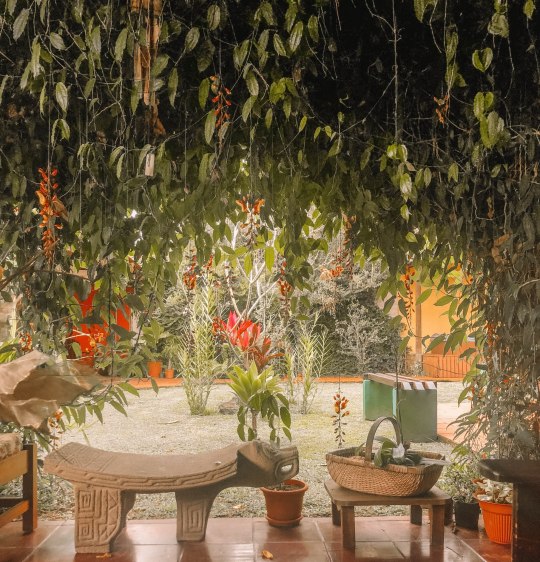

Within walking distance of the hotel is a beautiful park with a gazebo that the locals love, and restaurants that will not disappoint your taste buds. During my stay, I dined at More Than Words which is right around the corner from the hotel where we enjoyed a delicious pizza and salad.
We stayed at this B&B for two nights and had an amazing time experiencing Costa Rica outside of the populated city.
RIVER RAFTING
After an early morning breakfast at the B&B, we made our way to Tico’s River Adventures. Their base is located in Turrialba only about 10 minutes away from our hotel, and they even offered to pick us up and drop us off! Make sure to pack a change of clothes with you and be aware that you will have the opportunity to swim near the end of the trip, so wear clothes you don’t mind getting dirty/wet. Tico’s website suggests bringing:
swimsuit/shorts (no jeans)
sunscreen or visor
strap to secure glasses
tennis shoes or sandals with ankle straps (no flip flops)
light rain jacket for rainy days
cotton T-shirts for sunny days
A day trip is from 8:30 a.m. to 3:00 p.m., so be prepared for a long day! Tico’s is the first rafting company to get to the river giving them a competitive avantage over other companies. From Tico’s base, participants are picked up at various destinations on the way to the Pacuare River where the rafting takes place. Be aware that you are all squeezed together in a van depending on how many people are going on the trip. The ride took around an hour to an hour and a half total, and near the end of the drive were some very rocky and steep roads. Between the water and the drive, this trip is not for anyone who has motion sickness.

That being said, the long drive was 100% worth it and rafting was one of the biggest highlights of the trip. The Pacuare River is one of the top five most beautiful ratable rivers of the world according to National Geographic Magazine. Flavio was our guide and we were in a six person raft. Flavio spoke fluent English and had worked in California for a long period of time, and he made our rafting journey comfortable, educational, and hilarious. There are bathrooms located at the start of the river, but after that you will not see another bathroom for around two hours. For equipment we wore a lifejacket and helmet to ensure our safety during the trip. We started the rafting by going over basic instructions on how to paddle forwards and backwards which was easy to learn. There were rapids from difficulty levels one to four (none were too difficult in my opinion), and the rafting started out fairly easy. Along the river are two stunning waterfalls, small villages of the indigenous people of Costa Rica, and several rapids.
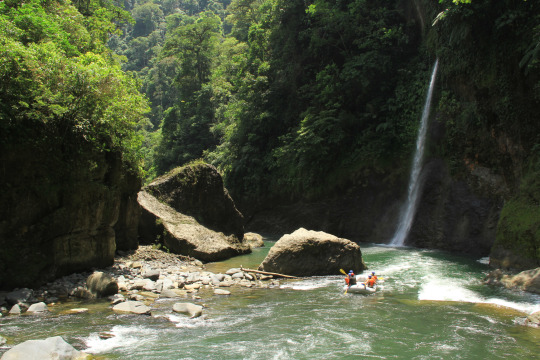
There are foot straps within the raft for stability, and falling out of the raft is not a problem as the guides are well trained. I only *almost* fell out of the raft once when Flavio decided to do a 360° turn while going down a rapid. I nearly flew off the side but I was thankfully saved by my dad.
At a calm section of the tour, we were able to get out of the raft and swim. It was one of the most calm and relaxing moments of my entire life. I floated on my back and heard the sounds of wildlife from birds chirping to howling monkeys in the distance. The rainforest trees towered above me on either side, and the water’s current swept me through the warm yet refreshing river.
We drifted towards a set of smooth rocks where we docked the rafts and the guides made us a delicious lunch. We were able to build our own tortillas and for dessert there was fresh pineapple.
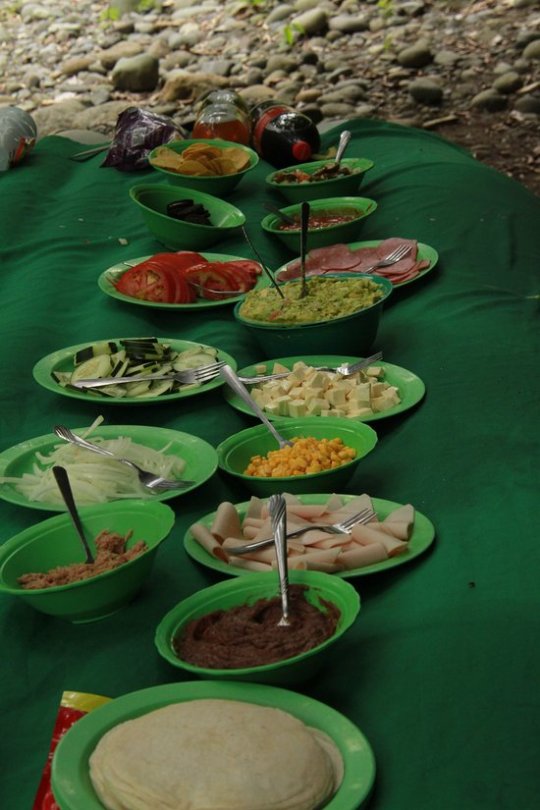
After lunch, we continued for a while longer down the river until we reached the end of the rapids. We docked the boat and ended at a small restauraunt where we had the option to buy drinks or use the restroom facilities. Throughout the rafting journey, there is a photographer who kayaks ahead to take photos, and they are offered at the end of the trip for those who want to buy them. Overall, I would highly reccommend river rafting to anyone adventurous enough to try!
SAN JOSÉ
While we were at the B&B, someone who was staying there highly recommended the Mercado Central in San José. We had our final breakfast in Turrialba and drove to San José to find the market, but sadly we found it to be closed on Sundays. We paid a small amount to park in a fenced-in lot and we decided to walk around San José even if we didn’t get to go to the market. We decided to try and find Museo del Oro Precolombino (The Pre-Columbian Gold Museum) after doing some research. On our way to the museum we walked through Central Avenue Boulevard which was lined with shops and fast food restarants. Families, couples, and individuals crowded the walking areas with one hand holding an ice cream cone and another grasping a shopping bag. There were vendors along the sides of the path that were selling handmade bracelets, keychains, and more.
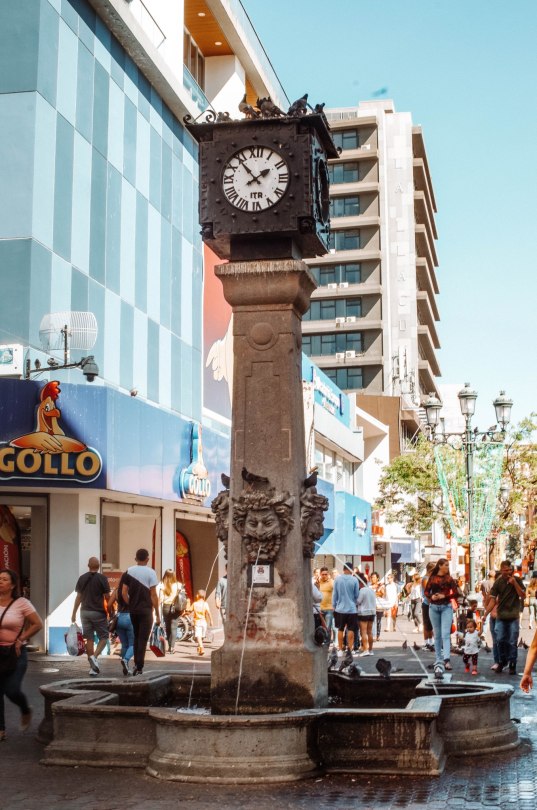
On our way to the museum we found ourselves pretty hungry for lunch so we stopped at the National Theater of Costa Rica (Teatro Nacional Costa Rica) for some delicious food. The interior of the theater was stunning and had several statues just inside the enterance. There was a small cafe located within the theater that served brunch. The cafe was very high-end with paintings and sculptures that decorated the interior. Waiters and waitresses were dressed in black and white and the overall feel of the cafe was prestigious. My father had more than one latte they were so delicious, and I enjoyed my meal as well. We got a window seat which was perfect for people-watching and enjoying the warm breeze.

After our lunch we asked directions to the museum and found right next door to the theater (you have to go down some stairs to find it). The museum was massive and had 3 different floors, one for a history of Costa Rican money, another for artwork, and the third for the gold. There were interactive stations, a fascinating video on the indigenous people of Costa Rica, and hundreds of beautiful artifacts. There was an entry fee that was a little pricey, but with the amount of history and art you got to see, it was worth it.

After our adventures in San José we headed to meet our Caravan tour at the airport where everyone was arriving.
CARAVAN TOUR
When traveling, I fear limitations and impetuosity so I did not expect to have the greatest experience with a guided tour. I like to venture off the formed paths and explore on my own with my camera in my hand – free from time constraints and noisy crowds. Nature has always resonated with me and calmed me down so I was afraid I wouldn’t have the same experience on this tour as I did when exploring Costa Rica on my own.
My fears were silly. This tour was incredible and because of it I was able to see some of the most stunning spots of Costa Rica. Martha Seeyle was our amazing guide and she made the experience so much better by teaching us about the culture and history of Costa Rica. There were some long bus rides, but Martha always had something new up her sleeve to teach us.
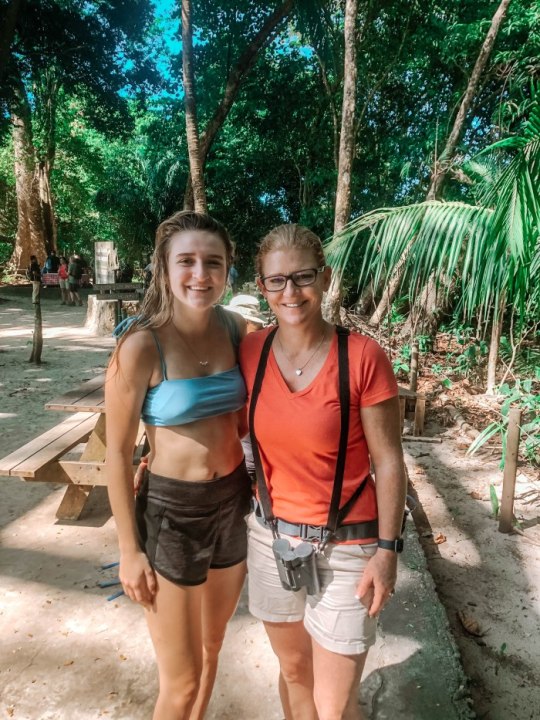
After settling in at Hotel Barceló in San Jose, we prepared for our first day of activities: a trip to a coffee farm.
COFFEE TOUR & BUTTERFLY FARM: ALAJUELA
If you are not an early riser, this trip may not be for you! We woke up at 7:00 a.m. and grabbed a buffet style breakfast at the hotel (which was very yummy). After breakfast we departed for Alajuela, but on the way we stopped at an artisan souvenir shop and saw the world’s largest ox cart! We got a mini tour of where they make the wheels of ox carts and saw some artisans in action. They provided some fruit and a lemonade-tasting drink (that apparently wasn’t lemonade) for us to snack on. We were given time to shop around the store and use the restrooms, and then we were off to the Doka Coffee Plantation.
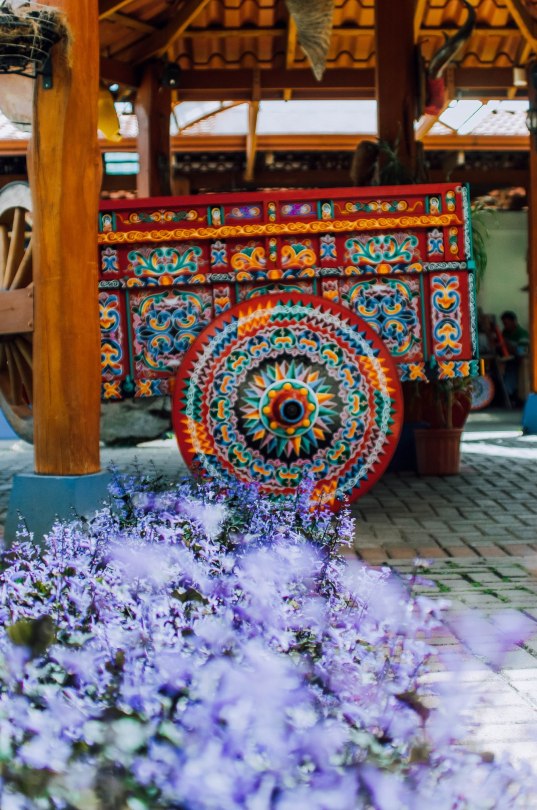
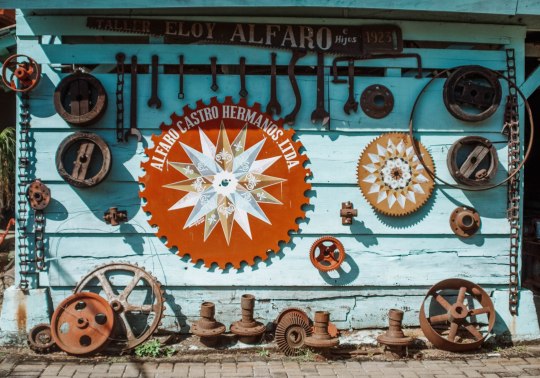
Once we arrived we ate a buffet-style lunch in an open area full of seating, and we were the only group there. After we finished eating we were given the opportunity to explore the grounds which had a butterfly garden! There were two levels to the garden and plenty of open space for the butterflies to fly around.


Our guide for the coffee tour was very knowledgable, but in my opinion I found the tour to be a bit bland at times considering I have no interest in coffee. Our guide took us through the step-by-step process of collecting coffee beans from picking them to roasting them and we even watched a short video about the plantation before we started our tour.

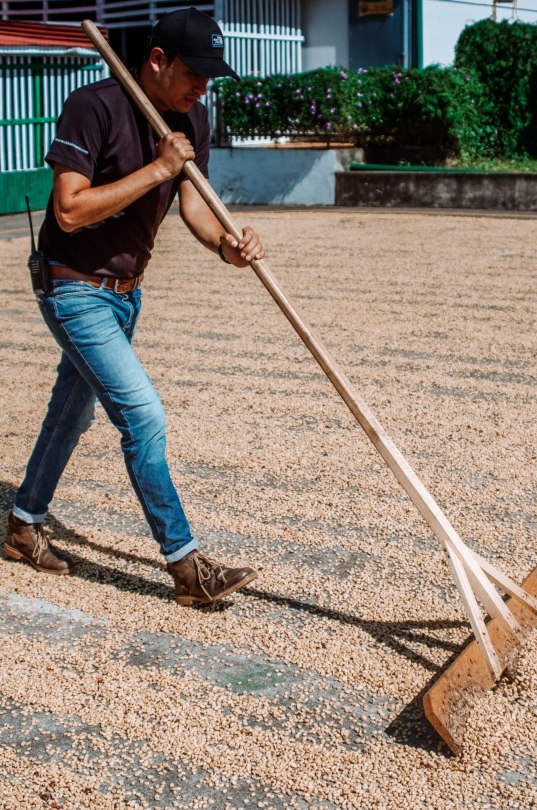
One pretty great part though was that we got to sample some chocolate and vanilla covered beans (if you couldn’t tell I have a sweet tooth). We were also given the opportunity to buy the bags of beans directly from the plantation which was pretty neat after just watching the step-by- step process.
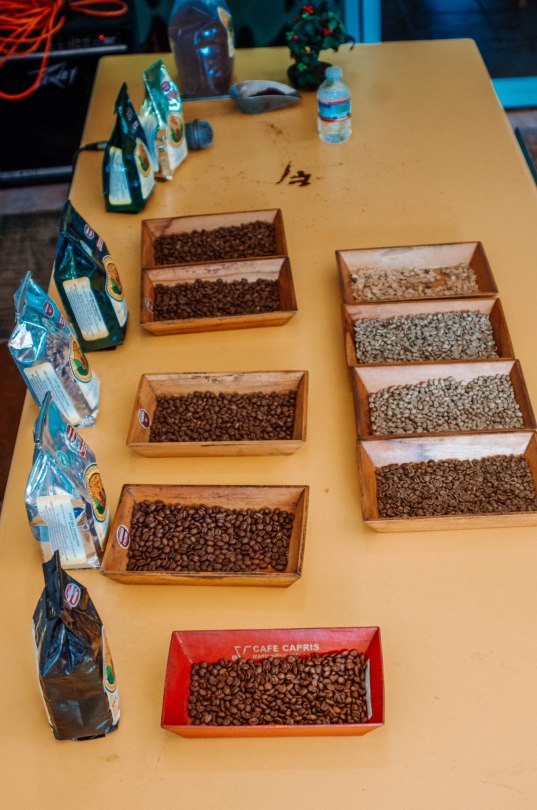
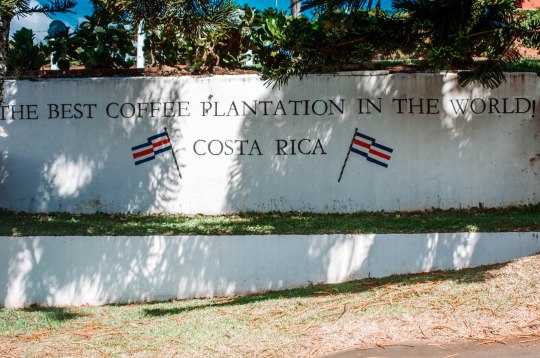
I think that a lot of people on the tour enjoyed the plantation, but because I am not a coffee drinker and I prefer activities with a little more action, this was my least favorite activity while on the trip (it only goes up from here!).
We arrived back at our hotel around 3:30 which gave us plenty of time to do some exploring around the hotel and get some rest before dinner. We walked to a local market to pick up some snacks because we had already run out of the ones we brought, and had a relaxing evening. Hotel Barceló was one of the nicest hotels we stayed at with functional wifi, great food, and comfortable and spacious rooms. The only issue is that they played the same exact song on repeat for every single meal to the point where it became a running joke and we could all hum along to it.
RESCATE ANIMAL ZOOAVE: FORTUNA
We left the hotel at 8:00 a.m. after enjoying another buffet-style breakfast at the hotel and in no time we arrived at the Rescate Animal Zooave, a wildlife rescue center located in Fortuna. The center is home to 800 animals that are not able to be released into the wild due to injury or becoming desensitized to humans. We watched a short video about the history and mission of the center and we were encouraged to donate to help the animals in the end for surgeries or for new equipment. I took over a thousand photos alone at the center of all the stunning birds, iguanas that roamed free, crocodiles, monkeys, and more. We didn’t even get to see all of the animals the park was so big, and we had a pretty funny encounter with one of the monkeys. We had another buffet-style lunch (we got used to it) at the center which was very yummy, but we ran out of time to try and see the rest of the park. All of the animals seemed to be treated very well and the establishment was clean and welcoming which made me feel really good.
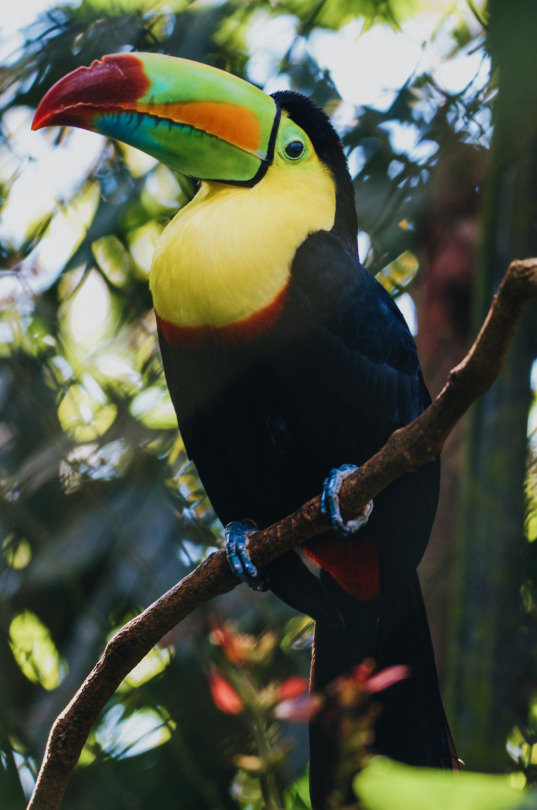
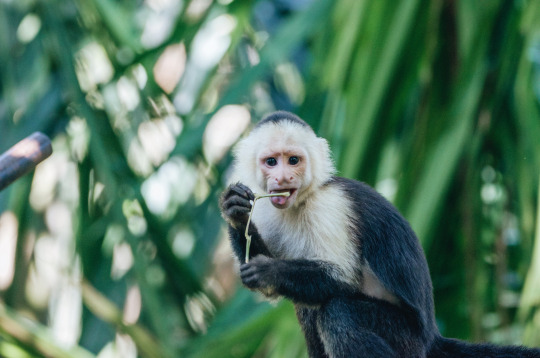
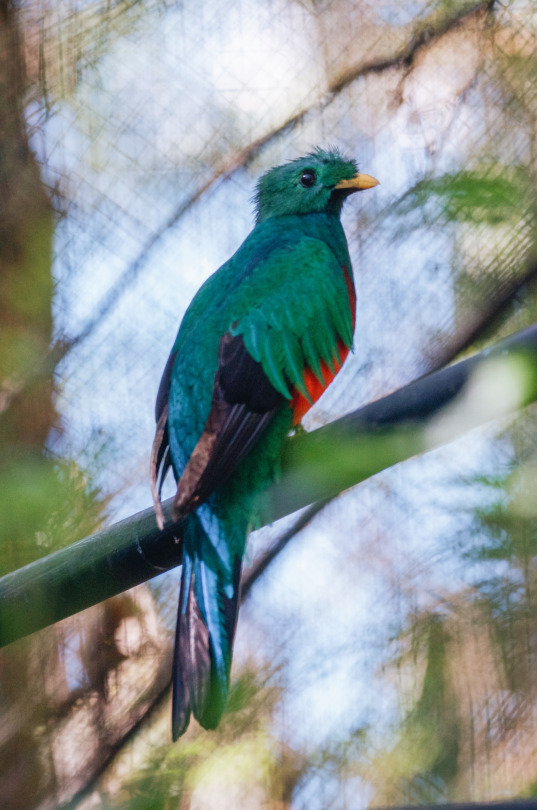
We headed to our next hotel, Magic Mountain Hotel located in Fortuna. To break up the drive, we stopped at a stunning park where we grabbed ice cream and walked around. There were two adorable, stray (we think) dogs in the park that were very friendly and hung out with us while we ate our ice cream.
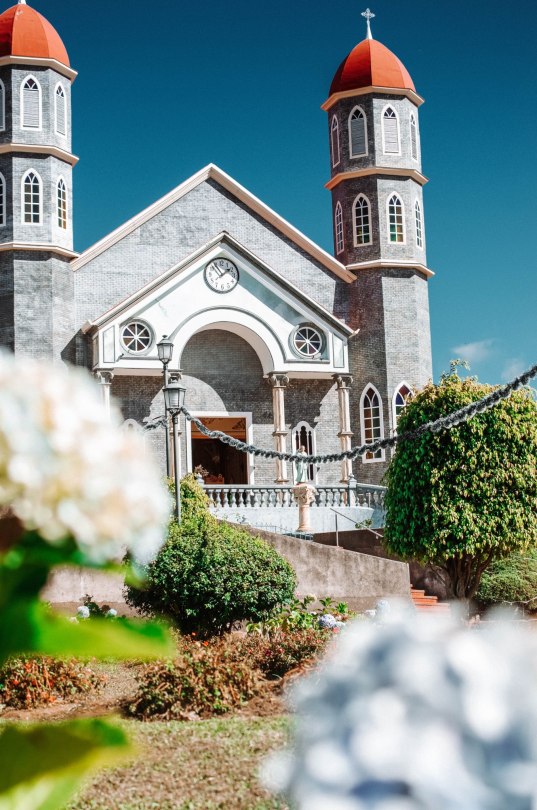

The great thing about this tour was that Martha always made sure we broke up the longer drives which gave us a chance to grab some food, stretch our legs, and use the restroom. I believe the longest we were in the bus at one time was 2-3 hours.
We arrived at the hotel around 4:00 and instead of eating dinner at the hotel, my dad and I decided to take a 20 minute walk (2km) into town to grab some local dinner. Before deciding on a place to eat, we explored the local shops and bought a few postcards to send out to our family in California.
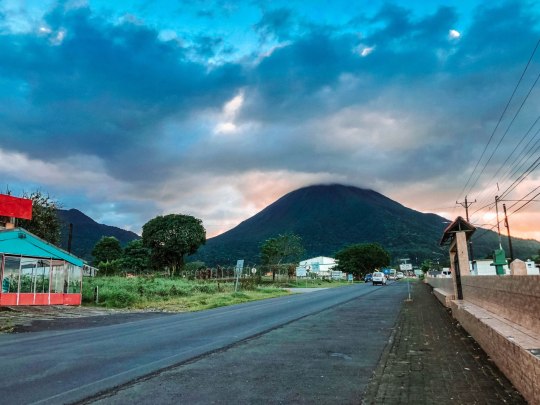
We ended up at a place called Lava Lounge which had delicious food and not to mention one of the best smoothies I have ever had. The lounge had nice seating that looked out onto the street and an artisan was crafting at the enterance for entertainment. The menu was very extensive and a relief after having too many buffet-style meals (see the menu here). I ordered a Santa Fe wrap and a strawberry banana smoothie which were both very filling. I am a dog lover and the lounge had various advertisements about the importance of adopting or volunteering at shelters which made my heart happy. You could even buy a digital food item and the proceeds would go to the dogs.

Walking back to the hotel was a little sketchier considering there were limited sidewalks and it was dark outside, but it was totally worth the yummy meal. The Magic Mountain hotel had a great view of the volcano (when it wasn’t cloudy), a pool, and very comfortable rooms with air conditioning. The WiFi, however, did not work very well and we were only a few steps away from the lobby which was a little frustrating.
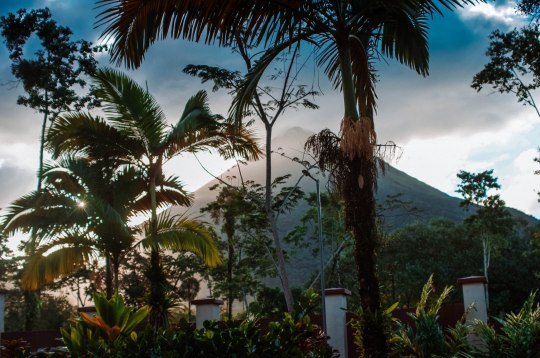
CAÑO NERO HOT SPRINGS: RIO FRIO
We departed the hotel at 8:00 after eating breakfast and drove north until we reached the Rio Frio river. We stopped at a small restaurant and then we proceeded to take a short walk to the river where we boarded a boat. We saw so many fascinating animals from monkeys to lizards. We travelled so far north that we were able to cross the border of Nicaragua!

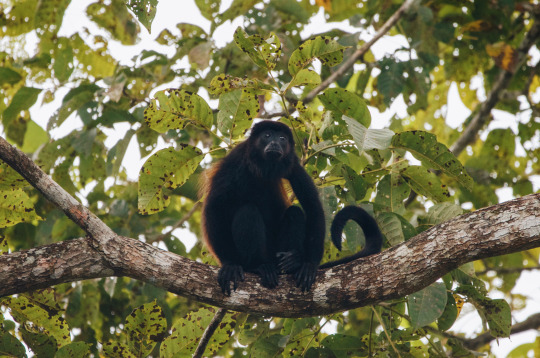
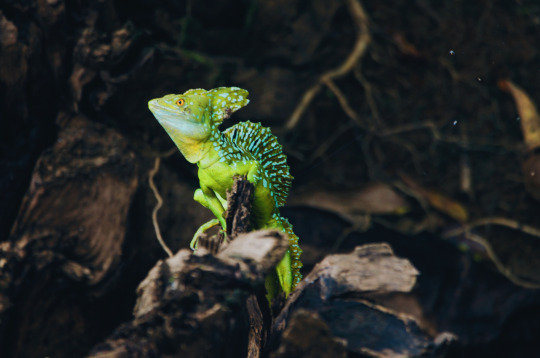
The boat cruise was only an hour long, but afterwards I was known as the “camera lady” because of my massive lens and how I ran around the boat trying to get as many photos as possible – I was definitely in my element.
After our tour we ate lunch at the restaurant we parked at and then headed back to the hotel. Miraculously, on our way there Chega, our bus driver, spotted a three-toed sloth and a two-toed sloth in the same tree! We pulled over and took a look at the sloths which was very rare to see.

Our next destination was the Baldi Hot Springs which was not exactly as natural as I expected. We were given the option to opt out of this activity, but my dad and I wanted to fill our day. I was expecting a few pools that were completely natural and warmed by the volcano, but I was surprised to find more of a man-made waterpark. There were bars, food, lounge chairs, slides, and lockers for your belongings. Rather than the sanctuary I was thinking of, it was more comparible to a waterpark.
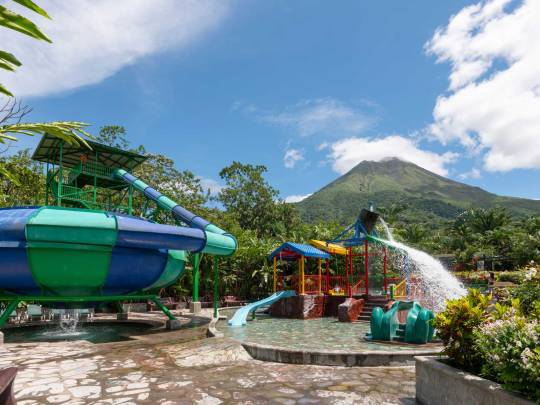
The food and drinks were incredibly expensive (one smoothie was $16) which was disappointing. On the positive side the water was incredibly relaxing and there were separate pools with different temperatures including a cool-down zone.

Because of my initial expectations I was disappointed with the hot springs, but it was nice to sit down and relax in some warm water after a busy day.
HANGING BRIDGES: ARENAL
We had a very early morning and woke up at 5:45 a.m. and had breakfast at the hotel at 6:00. Our next destination was the Mistico Arenal Hanging Bridges Park, and to my surprise I had actually been to this park on my last trip! During this trip we were able to see some monkeys, but we didn’t see much other wildlife. The hanging bridges were so cool and the sounds of the forest surrounded us at all times. The walk was around 3.2km, but there was also a shorter version (1.9km) for individuals who didn’t want to walk as far.


Near the end of the walk is a natural waterfall that serves as a great photo spot. Additionally, the entrance of the park has a perfect view of the Arenal volcano, and I was able to recreate a picture from my last trip!
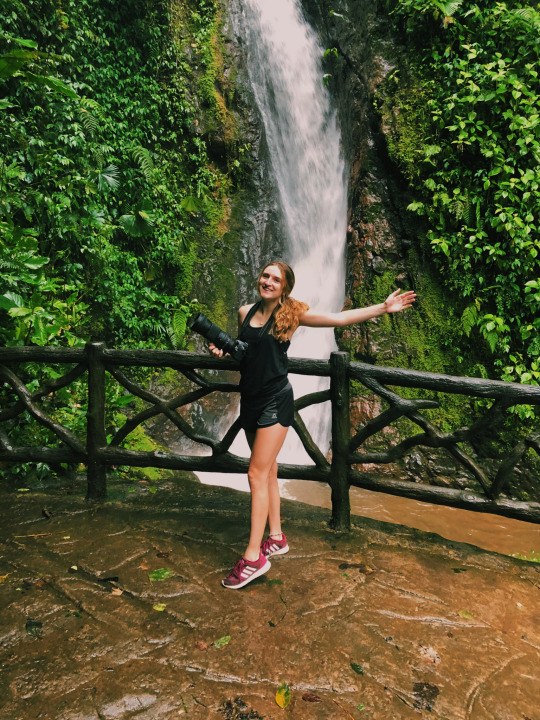
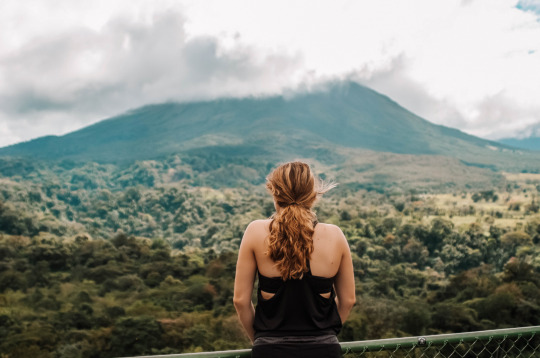
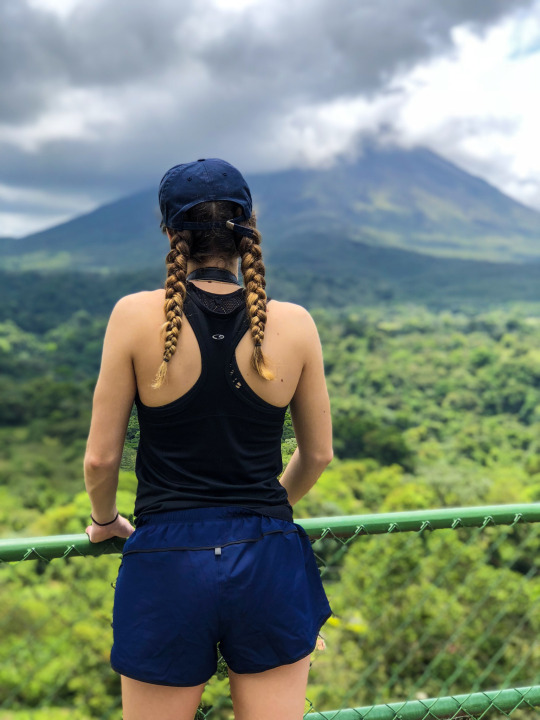
I love the hanging bridges because you become one with nature, and there were barely any crowds so it was incredibly peaceful. After our walk we went headed to our next hotel and stopped for lunch and at another souvenir shop in order to break up the drive (we spent most of the day driving). We even drove by the hotel that I stayed at during my last trip (a.k.a. my favorite place in the world).

^^^Hotel Los Héroes – Read more about my last Costa Rica trip here.
We eventually arrived at the Marriott Resort just in time for sunset. After settling into our rooms, we walked down to the ocean (the resort is located on the beach) and took some amazing pictures of the landscape.

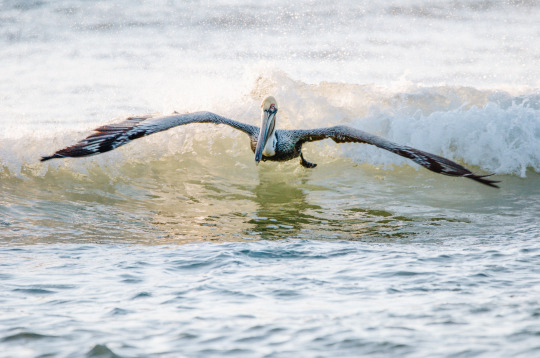
JW MARRIOTT BEACH RESORT: GUANACASTE
We had the entire day dedicated to this resort, so we got to wake up whenever we wanted. In an effort to not waste the day away sleeping, we woke up at 8:30 and got breakfast. There was a separate restaurant just for our tour and we had access to it during a certain time frame. When I walked into the buffet, my jaw DROPPED. I have never seen so many pastries, fruits, cereals, eggs, and more in one place. I quickly filled my plate and as much as I wanted to go back for seconds, I was way too full.

We had the entire day to ourselves, so we decided to go for a hike located on the hotel’s grounds. We didn’t see anyone else during the hike, so it was just us and the birds. I got to take pictures of some beautiful birds, but I saw even more wildlife. While we were walking we were shocked to hear some movement above us, and we looked up to see a pack of howler monkeys! They were so calm and didn’t move for quite some time so we were able to observe them closely. One of the monkeys was carrying a baby and I was able to take one of my all-time favorite photos.


After our hike we decided to cool off at the hotel’s infinity pool which overlooked the ocean. I ordered a strawberry banana smoothie (they became my obsession on this trip) and took some time to relax under the sun. After swimming in the pool, we told ourselves we had to jump into the ocean ( I didn’t get to on my last trip), so we ran into the waves for a surprisingly very refreshing swim. The water was a perfect temperature and the sand was so smooth – the best swimming conditions in my opinion.
While we were on the way to the hotel, Martha mentioned that there were horses only a short distance from the entrance so we decided to go pay them a visit. Our timing was impeccable as the sun was setting, so a beautiful, golden light backlit all of the horses. They came right up to the fence and let us pet them, and one even started to eat my dad’s shirt (it was very amusing). We spent a lot of time with them until it was dark and then we decided to grab dinner and hit the hay.
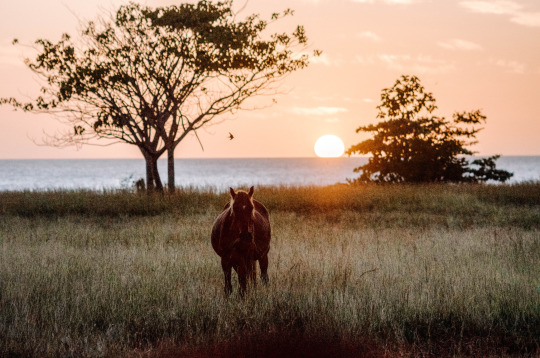
Our entire group basically had to be pulled away from this resort because between the food and the amenities it was the best hotel we had been at so far.

BIRD WATCHING CRUISE: TARCOLES RIVER
We woke up at 5:50 a.m. and grabbed our last, best breakfast. My dad and I “stole” extra bananas and apples from the buffet and ran to the horses with the spare time we had before we boarded the bus. We fed the horses both apples and bananas (they preferred the apples) which made for a pretty magical morning.
We sadly departed from the Marriott and headed to Tarcoles River, but on the way we stopped at a small, Monteverde restaurant for restrooms and ice cream (yes, I ate ice cream before lunch – it was delicious and only $2). We continued on the road again and stopped at a different restaurant for a buffet-style lunch. We had the choice between steak and chicken with some rice and a few other sides. The restaurant was completely open-concept with a cool breeze coming in on all sides. We even saw some iguanas crawling around outside!
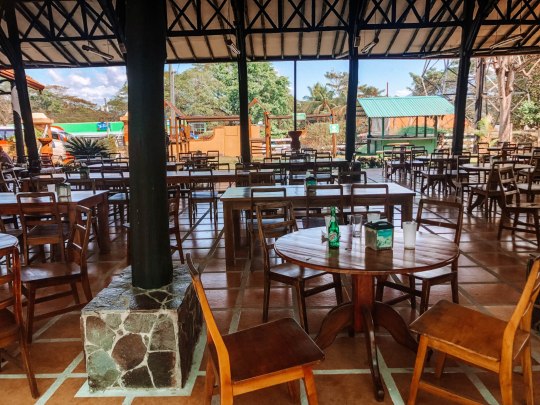
We continued to drive to the river, and when we got there, a boat was waiting for us. This river is known for its crocodiles, so don’t fall overboard! On the cruise we saw birds, iguanas, crocodiles, and more. The directors of the boat tour were able to identify the crocodiles by name based on what they looked like and where they were hanging out which was pretty neat.


The boat tour flew by (it was around an hour long) and we headed out for our next hotel once again. Hotel San Bada had a stunning rooftop view of Manuel Antionio National Park on one side, and the sunset on the beach on the other.
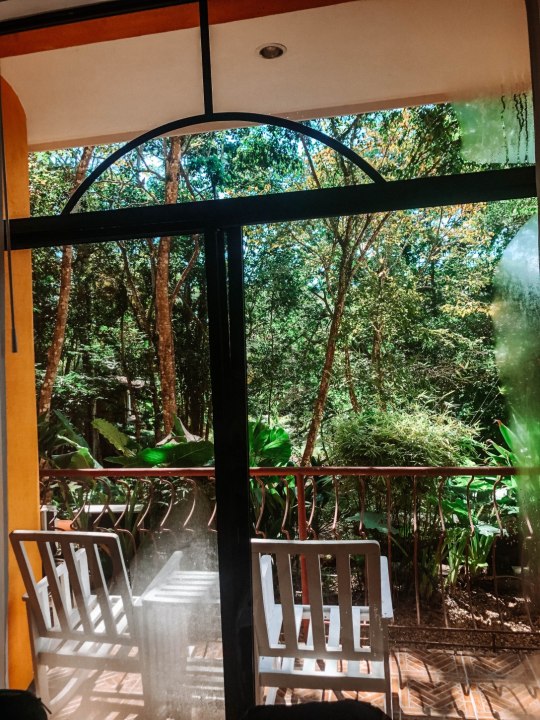
When we arrived we enjoyed another buffet-style dinner and then we went to the roof for “cocktail hour” and the sunset. I brought my camera and managed to see some Squirrel Monkeys climbing through the trees which was so cool because they are difficult to find!
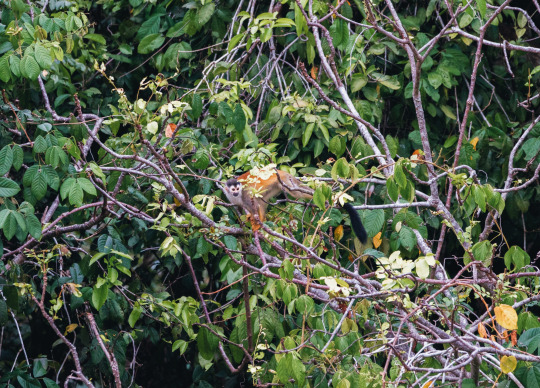
The sunset was absolutely breathtaking and it was paired with some people who were parasailing which made the photos even more exciting.
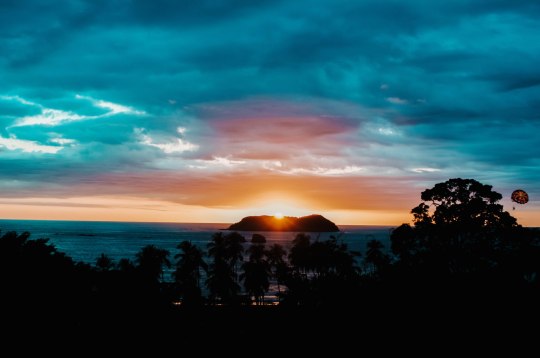
Before our big day in Manuel Antonio National Park, our Caravan group watched a short video about the history of the park and learned about the trails that we could take. We were told to bring hiking shoes, a change of clothes, a towel, and a bathing suit in order to be able to do everything at the park. Martha said we could sleep in until whenever, but if you want the best experience of the park, you should go right when it opens at 7:00 a.m.
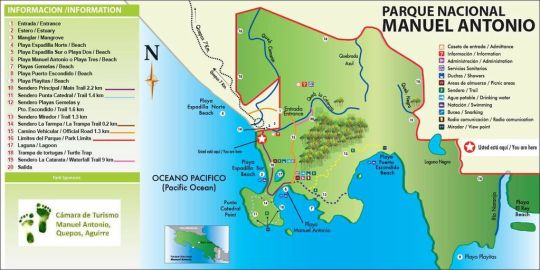
MANUEL ANTONIO NATIONAL PARK
We woke up at 6:00 a.m. and ate breakfast at the hotel. We found our group at the entrance of the hotel which is conveniently located a few steps away from the park’s entrance. We chose to take the long route through the park with lots of stairs and lookout spots (I would say this hike was difficult, but an 80 year old woman with our group did it with no problems). During our hike we saw monkeys, agouti, sloths, and some birds. There was a group of Capuchin monkeys that came right up to us (they were so close that I couldn’t even take photos with my lens). In hopes of finding more birds (specifically toucans because they are my favorite), we climbed a lookout tower, but we had no luck.
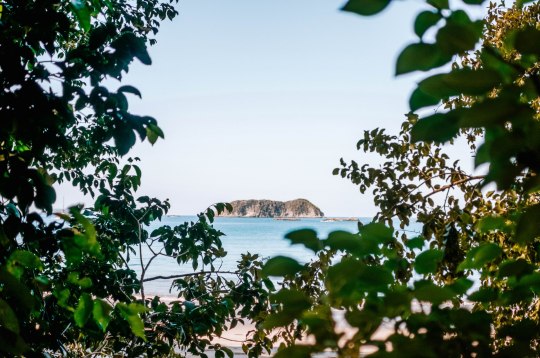
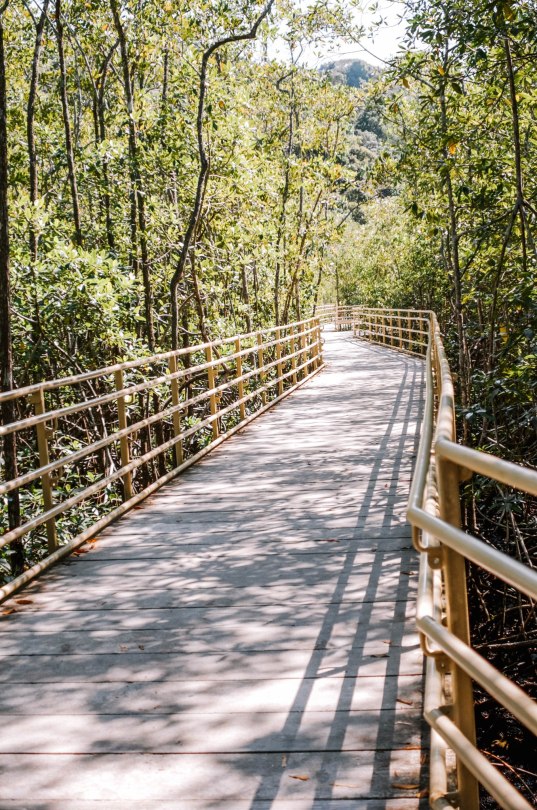

After our hike we took a quick dip in the water which was a perfect temperature! The park filled up quickly and it seemed like most people went for the water and not for the hikes.

We left the park at 11:30 a.m. to grab lunch at the hotel, and said goodbye to our Caravan group as we were beginning our individual trip. I was the youngest one on the trip and the tour was definitely more orientated for an older crowd, but we made some memories with a lot of the people on the trip so it was a heartwarming goodbye.
INDIVIDUAL EXCURSION
We stayed at San Bada for a little longer to plan out our day on our own, and at 1:00 we taxied to our next hotel which was only around 15 minutes away. Peace of Paradise was a very cute apartment-style hotel which had a balcony with a sliding screen door.
We later found out why the door was sliding – monkeys had figured out how to open regular push/pull doors and had raided the kitchens for food! I went to take a nap, but I was incredibly surprised when my dad opened my door and told me there were monkeys at the door. I completely thought he was joking, so I dismissed it until he told me to grab my camera (then I knew it was real). I sprung out of bed to find a group of monkeys raiding the neighbors house for sandwiches and eggs. They were so close I was able to use my phone to take photos, and their visit was definitely a highlight of my trip.

After that excitement, we decided to explore the town so we went to a grocery store and picked up some snacks for the next few days. At 6:30 p.m. we decided to find a place for dinner and walked through town to see what our options were. We ended up at Victoria’s – a gourmet Italian place which had absolutely delicious food. I got fettuccine alfredo with chicken and I wish that I could have finished it it was so good. The customer service was the best we’ve ever had, and we were waited on by several people. One waiter, Manny, is a photographer and showed us his photos and shared his Instagram with us – I still follow him! We had a lovely evening at the restaurant and I highly recommend it to anyone in the Manuel Antonio area.

DAY 1: TRAVELING TO DRAKE BAY
We woke up at 6:15 a.m. and packed up to leave Peace of Paradise, and one of the employees asked to take our photo in front of the sign for the hotel (they do this for every guest and compile the images on Facebook).

We spent most of the day traveling from Manuel Antonio to the Osa Peninsula where we would be staying in Drake Bay for three nights. We took a small van from the San Bada hotel to Sierpe which was a scenic two-hour ride with palm trees lining both sides of the street.
We arrived at a small restaurant that sits right where the boats to Drake Bay depart and spent two hours there waiting for our boat to be ready. I had some scrambled eggs and a strawberry banana smoothie (what else is new) and worked on some photo editing to kill some time (there was stable WiFi).
Eventually, we loaded the boats which were very crowded (around 30 people), and we had to put our lifejackets on (all of the luggage was stored in the cabin of the boat). The first half of the boat ride was very calm, but it became pretty bumpy when we reached the ocean. In order to dismount the boat, you had to get out into knee-high water and walk to shore because the boats could not go all the way so make sure to wear some sandals. The crew will take care of your luggage for you and will carry it over their heads to shore.
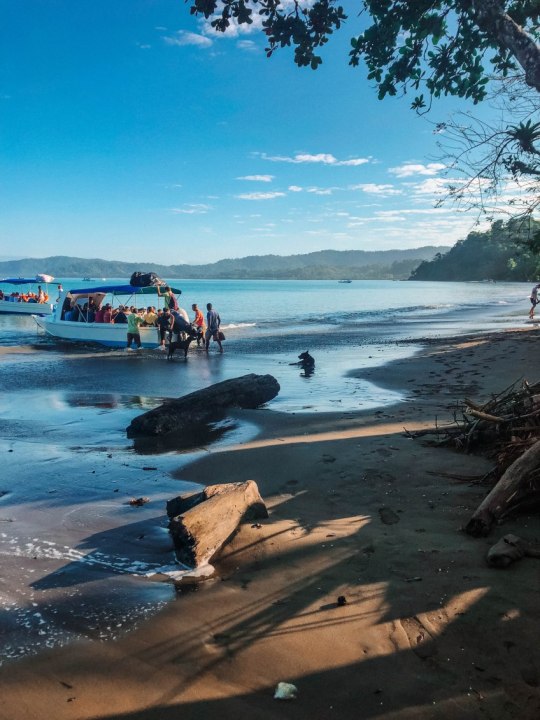
Hotel employees of Cabinas Murillo, the hotel we were planning to stay in, met us on the beach and carried our luggage to a pick up truck. We got inside the truck and they drove us a quick two-minute ride to the hotel. Almost immediately you could feel the heat difference on the Osa Peninsula. Unfortunately this hotel had no A/C (although it had two fans), so the heat easily made its way inside the room. The only way I could cool off was by sitting completely still or taking a cold shower. Sure, the hotel itself wasn’t 5 stars, but the view from our balcony was breathtaking and the price was very affordable. We spent some time cooling down by sitting on our balcony watching birds of all different colors and sizes fly around us. We decided to stay in Drake Bay for a few days because of our love for birding (specifically bird photography in my case), and the Osa Peninsula is renouned for its unique birds.


After finally cooling down, we grabbed lunch at a local place where I got a piece of pizza (I missed pizza) and yet another smoothie. The town in Drake Bay is incredibly cozy, small, and you will see a lot of locals. There are two markets in town that have any food you’ll need during your stay, serveral restaurants, a church, and some tourist-y stores. For dinner we went to a place called La Choza which had some of the best shrimp and rice we have ever eaten. We ended up having this almost every single night for dinner while in Drake Bay because of how delicious it was. The restaurant was always very busy and was a popular destination for many locals.
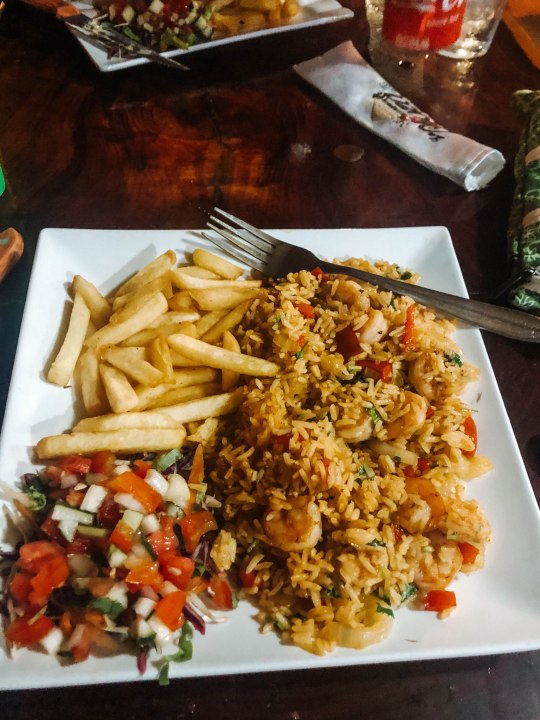
DAY 2: EXPLORING DRAKE BAY
Because our sleep schedules were trained for early mornings we ended up waking up at 6:30 a.m. and grabbed breakfast at one of the local restaurants. I can’t remember the name of the restaurant, but I remember that they had a variety of pastries and a complete breakfast menu. We walked through the town and down to the beach where we ran into some four – legged friends who followed us on our walk through the bay.
We booked a birding tour online the day before (we didn’t exactly expect a response as most people book tours months in advance) and hadn’t heard anything from the company, so we spent some time looking to get in contact with the tour guide. After about an hour of searching, we recieved a phone call that we could do the tour the next day instead. If you are looking to do any type of activity or tour, I would recommend booking in advance to ensure that you’ll have a spot.
With our new free time, we walked some more through the bay (it’s very small), spent time scouting some birds from our balcony, and got ready for an early morning.
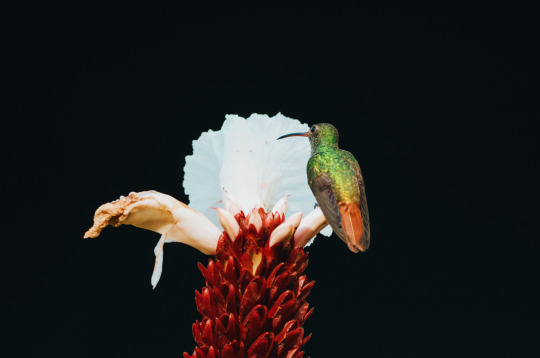

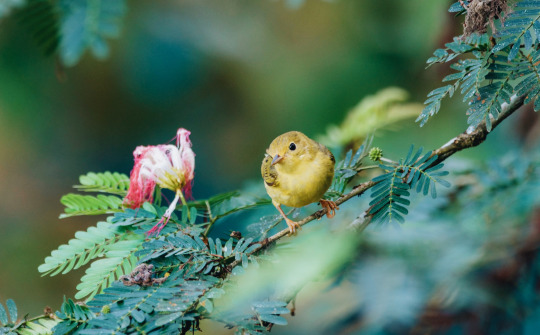

DAY 3: BIRDING TOUR
We woke up at 5:00 a.m. (our earliest morning yet) and got ready for our tour with Drake Bay Birdwatching. We packed binoculars, camera gear, water, and a change of shoes. Walter, our tour guide, picked us up at 6:10 a.m. and he explained that we would make a few different stops to see the most diversity.
Our first stop was at an open field lined by trees where we saw hummingbirds, chachalachas, and more. We spent around an hour at the field and even heard some rare birds as well. Walter was incredibly educated on the subject and got so excited when he saw a bird that it made you very excited too. His passion was clear and he was dedicated to helping me get the photos I envisioned.

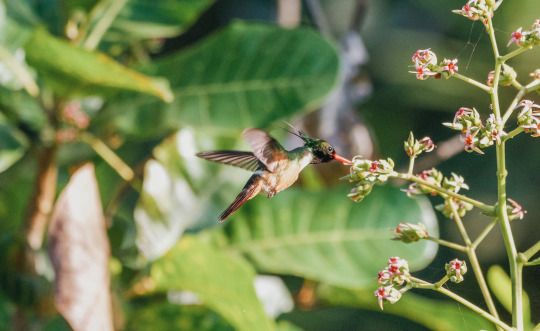

Our next photo spot was Los Planes which is part of Corcovado National Park, but is more quiet and remote. While we were hiking through Los Planes, we did not see anyone else. In the forest we saw a variety of wildlife including lizards, insects, racers, monkeys, and of course – birds. We trekked through the forest for around 2 hours and stopped at several spots along the way when we heard bird calls or when we saw something moving. There was even a (very rare) chance that we could encounter a jaguar which was exciting and chilling.



After carrying around a 7-pound camera around in the humid forest, I felt a little lightheaded; it could also be the fact that I didn’t eat anything before our tour. Make sure you either eat before a long day of hiking, or you bring a snack along the way to avoid any overexhaustion.
Walter provided us with a snack of watermelon, bananas, and lemonade after Los Planes which were all very fresh. We made a quick stop on our way back to drake bay center to try and see a king vulture, and we did! You couldn’t see it with a bare eye and my 600mm lens barely picked it up, but I managed to get the photo below.

Walter drove us to a restaurant located right near our hotel where we had a scrumptious lunch (appetizers too) that were all included with the tour. Walter offered to drive us back to the hotel, but we opted to walk instead. I was exhausted by the time the tour was done and I ended up napping for a few hours before we grabbed dinner at La Choza again. I would recommend this tour to anyone who is patient and has a passion for wildlife, and if you can have Walter as your guide, his excitement, talent for spotting the wildlife, and his overall knowledge made the tour great. A few weeks after our tour Walter sent us a copy of all of the birds that we observed (heard and saw) during our trip (see photo below).

DAY 4: TRAVELING TO SAN JOSÉ
We woke up at 6:30 a.m. to catch our boat ride back to Sierpe, and from there we took a taxi to Adobe Car Rental in Uvita. We had to stop at a bank on the way because we ran out of colones in Drake Bay because there are no ATMs (make sure you load up on cash before you go to the bay!).
We were a few hours early for our rental car, so we ate brunch at Marino Ballena which was located across the street. I easily spent a lot of time at this restaurant because of the great food, customer service, and WiFi. The owner was from New Jersey and was very friendly and even provided me with the WiFi information (which was a blessing after not having it for a few days). I ate the “American breakfast” with some orange juice which hit the spot! Our car was ready at 12:30 p.m. (a little early!) so we were able to head out to our next hotel. The car ride to the hotel had some great views of the central valley.
Marriott Courtyard in Alajuela was kind of luxurious compared to Cabinas Murillo (but hey – you get what you pay for!). It was nice to finally have a night with A/C tucked under the covers.
DAY 5: HEADING HOME
After two, long weeks away from home we were both ready to travel back to Massachusetts (home sweet home). We woke up at 8:00 a.m. and had a very relaxing morning at the Marriott. We went downstairs for breakfast and similar to the JW Marriott in Guanacaste, the buffet was full of scrumptious choices. We had some time to kill before our flight, so we visited the Botanical Orchid Garden in Alajuela for one last adventure.
The garden was unfortunately underwhelming, but it may have been the time of year we went. There were some birds on display, a pretty pond, a unique bamboo trail, and greenhouses full of different types of vegetation. We spent some time taking some photos at the garden and listening to the thundering of massive bamboo hitting each other in the wind before we went on our way to the car rental place to drop off our car.
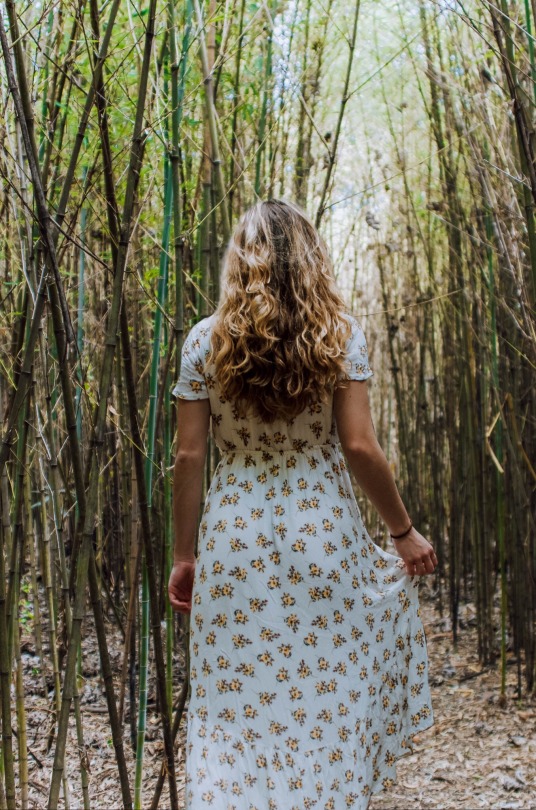

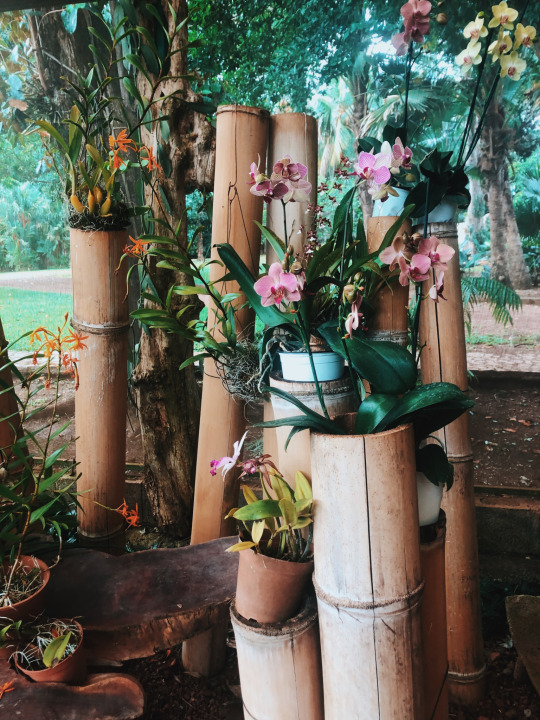
We got a ride to the airport from the car rental place and we began the journey home. We took two connecting flights to Boston from San José and after a day of travel we got home at 2 a.m..
AN UNFORGETTABLE EXPERIENCE
I know I haven’t travelled much yet, but my experiences in Costa Rica have been some that I wouldn’t change for anything, and this magical place will hold a special place in my heart forever. I’ve seen a lot of Costa Rica, but I haven’t seen it all, so I want to go back and finish my journey one day. The wildlife, people, and landscapes, are all reasons to visit this country. In Costa Rica, I was able to exercise all of my passions, expand my appreciation for nature, and try things outside of my comfort zone (leaving home for two-weeks was certainly a start).
Trust me, you are going to want to visit this stunning country in order to discover the laid-back nature of living with Pura Vida (Pure Life).
0 notes
Text
China Itinerary: How to Spend 2 Weeks in China
When planning a trip to China, there are probably a handful of destinations you’re dying to check off your bucket list in just 2 weeks in China. Maybe you want to explore the colorful Buddhist temples, lotus-filled ponds, and adorable baby pandas chewing on bamboo stalks. Or perhaps you imagine walking through the bustling metropolis of towering skyscrapers and modern high rises.
Or maybe you simply crave the aromatic taste of traditional Chinese foods like pan-fried dumplings and crispy Peking duck.
And the truth is, you can do all these things with just 2 weeks in China. Although two weeks will barely scratch the surface, there is still so much to do. As one of the oldest and fasting growing civilizations in the world, China is teeming with adventures for every type of traveler.

Due to the recent coronavirus outbreak in China, we at TravelFreak do not recommend traveling to China at this time. The U.S. Department of State has issued a statement warning against all travel to Hubei Province and restricting travel elsewhere in China.

How to Get Around China
Generally speaking, air travel is the fastest way to get around the country. Because cities and distances can be far apart, you can save a lot of time and energy by flying. The only downside is that domestic flights can be expensive, especially if booked last minute.
And while domestic flights can be faster and more convenient, traveling by bullet train is another popular method of transportation in China. Bullet trains usually run between most major tourist cities and provide a fast, comfortable way to travel long distances.
If you’re on a budget, traveling by standard railway is a cost-efficient way to go. However, local trains are often uncomfortable and extremely slow. The journey takes twice as long compared to bullet trains, which means you could be stuck in the same seat for over 24 hours.
Tickets for both types of trains can be booked the day of, but since they can quickly sell out, it’s recommended to purchase seats 20-30 days in advance.
The cheapest and most common transportation method is by bus. However, taking the bus is only practical if you are traveling to a city that’s not served by an airport or train station. Poor road conditions and unbearable traffic can make the bus journey extremely stressful.
A Sleeper bus is also available for long distance China trips, but bed space is often narrow and crowded. And while most bus coaches have bathrooms on-board, we can’t attest that they’ll be clean or even in service.
For a wide selection of train, bus and flight tickets during your China itinerary, we recommend booking directly with 12go.asia.
China Itinerary: See the Best of China in 2 Weeks
With 22 different provinces and dozens of beautiful cities, China is one of the largest countries in the world. And even if you plan an action-packed China trip, a few days in China simply won’t do it justice.
But as a first (or second) time visitor, 2 weeks in China is a reasonable amount of time to get an overview of the entire country. And if you have more time to spare, you can always stay a few days longer in each city to gain a richer understanding of the area. It’s more rewarding to spend your trip soaking in the culture rather than seeing it from the inside of a bus or plane!
Day 1 – 4: Visit Historical and Cultural Landmarks in Beijing

The Great Wall, Mutianyu, Beijing, China
China’s capital is a bustling city overflowing with 3,000 years of culture and history. Home to some of China’s most iconic landmarks, Beijing is slowly revolutionizing itself to become an international world leader.
And around every corner, you can see how Beijing manages to blend both ancient histories with modern culture together.
Climb the Great Wall of China
No trip to the capital city would be complete without trekking the Great Wall of China, one of the seven wonders of the world. Winding through 5,500 miles of rugged mountains, the Great Wall of China is a rare glimpse into one of China’s most fascinating pieces of architecture.
A word of advice: Skip the Badaling section and head straight for Mutianyu or Jinshanling. While these spots are further away, they’re more authentic and way less crowded than the commercial, tourist trap of Badaling. That’s why you should definitely go during your China itinerary.
Explore the Forbidden City
The Forbidden City was once home to ruling Imperial emperors of both the Ming and Qing Dynasties. And although you won’t find any royal families wandering around today, the Forbidden City remains the largest palace complex in the entire world.
But with over 900 buildings and almost 9,000 individual rooms, you can’t explore everything within the Forbidden City. However, you shouldn’t miss a tour of the Hall of Supreme Harmony, the Palace of Heavenly Purity, and the Imperial Gardens.
If you’re not entirely exhausted, we recommend a short walk up to the neighboring Jingshan Park. From the top, you’ll be rewarded with panoramic views over the Forbidden City.
Relax at the Summer Palace
The Summer Palace is a beautiful park and easy day trip getaway from the bustle and congestion of the city. Built as a summer escape for the Imperial family, this park boasts a variety of Buddhist temples, landscape gardens and tree-lined lakes.
The park grounds are centered around Kunming Lake, the perfect destination for a picnic lunch or relaxing boat ride. Make sure to tour Longevity Hill, a scenic viewpoint with colorful pavilions and grand halls.
Where to Stay in Beijing
Although the capital is one of the more expensive places to stay in China, you can still find accommodation for every type of budget during your China itinerary.
Just like in most major cities, there are large, international chains in Beijing. These places have amenities such as swimming pools, restaurants with western breakfast and business centers.
But if you’re looking to step outside your comfort zone, you can spend a few days in one of the traditional hutongs. Hutongs are one-story residential buildings have been converted to inns. For an authentic, Beijing experience, hutongs are a unique accommodation experience right in the city.
Luxury Hotels: Hotel Eclat Beijing
, Legendale Hotel Wangfujing Beijing
, Shangri-La Hotel Beijing
, InterContinental Beijing Sanlitun
Boutique Hotels: Beijing Pudi Hotel
, Beijing Double Happiness Hotel
, Michael’s House Beijing
, Sofu Hotel
Mid-Range Hotels: Ming Courtyard
, Jade Hotel
, Capital Hotel
, Kelly’s Courtyard Hotel
Hostels: Peking International Youth Hostel
, Chinese Box Courtyard Hostel
, The Great Wall Box House
, Leo Hostel
How to Get from Beijing to Xi’an
The easiest (and most comfortable) way to reach Xi’an from Beijing is by bullet train. The train leaves from Beijing West Station and takes only 4.5 – 6 hours in total. Speeding through the country at 186 mph, you’ll have the opportunity to see other picturesque villages like Zhengzhou, Luoyang and Huashan from your window.
Taking a two-hour flight from Beijing to Xi’an is also possible. But with the check-in and security, it ends up taking the same amount of time as the high-speed train.
If you’re on a budget, then taking the sleeper train to Xi’an is a great option. You can choose between shared bunks or a separate compartment throughout your China itinerary. But best of all, you’ll save the cost accommodation when opting for this 12-hour train ride!
Check out routes and prices using the form below.
Day 4 – 6: Explore the Imperial Capital of Xi’an

On the famous Xi’an wall in China
Few places in China are as culturally diverse as Xi’an. As the starting point on the Silk Road, Xi’an became an influential city home to emperors, warriors, merchants, and artists. But besides the Silk Road, most of the city’s history can be seen through its distinct architecture, making Xi’an a must stop destination in China for a few days.
Admire the Terracotta Warriors
When in Xi’an, you must tour the tomb of the terracotta warriors. Over 8,000 life-size soldiers and horses were buried more than 2,000 decades ago to protect Qin Shi Huang, the first emperor of China, in the afterlife.
And while there are still thousands of soldiers left to excavate, the terracotta army is a rare journey into the world of Ancient China.
What’s more impressive is each warrior has a different face. The level of detail on the armor, footwear, hairstyles and facial expressions is nothing short of remarkable. No two soldiers are the same, which you’ll see during your China itinerary tour!
Eat Your Heart Out in the Muslim Quarter
Although there’s no shortage of mouth-watering snacks in China, Xi’an’s Muslim Quarter is a food lover’s paradise. The sheer number of snack food stalls along the silk road can be overwhelming at first.
Here, you can find everything from beef skewers, dumplings, noodle bowls, spicy sandwiches, and local pastries. Try the Yangrou Paomo, a typical Xi’an stew made from lamb and served steaming hot with chunks of unleavened bread.
And while you’ll have an endless supply of traditional Xi’an foods at your fingertips, don’t expect any pork. After all, you are in a Muslim neighborhood!
Cycle Along the Ancient City Wall
For some of the best, panoramic views of Xi’an, stand atop the imperial 40-foot city walls that surround the city center. Built-in 1370 as a defense fortification system, the city walls were also constructed with a moat, drawbridges, steel gates and watchtowers.
Walking along the city wall is possible, but the best way to get around with a bike tour. It takes roughly two hours to cycle the perimeter of the city. Your reward: sweeping views of both modern day and ancient Xi-an from every angle.
Conquer Mt. Huashan
You won’t read about this in your travel guide! If you want to check a dangerous albeit thrilling adventure off your bucket list during your China itinerary, then hike Mt. Huashan, one of China’s most treacherous mountains. Located a few hours outside Xi’an, Mt. Huashan is famous for breathtaking views, granite peaks, and of course, it’s adrenaline-filled plank walk.
With only a thin harness chaining you to safety, you can scale the side of the 2,000-foot cliff by shuffling across a 1-foot wide, wooden plank. And while we can’t guarantee you won’t have a panic attack, we can vouch for the exceptional scenic views.
Where to Stay in Xi’an
Hotels in Xi’an are more affordable than other big cities in China, such as Beijing or Shanghai. For this reason, you should have no problem finding a clean, decent place to stay for a few days.
For first time visitors to this silk road city, consider staying within the city walls. Not only are you within walking distance to most major attractions, but you can also easily take a public bus to the terracotta warriors or other outlying neighborhoods.
And when it comes to different types of accommodation, Xi’an is home to a wide variety of hostels, hotels, and luxury resorts for every budget.
Luxury Hotels: Sofitel Legend People’s Grand Hotel Xi’an
, Shangri-la Hotel Xi’an
, Gran Melia Xi’an Hotel
Boutique Hotels: Eastern House Boutique Hotel
, Xi’an 52 Hezi Hotel
, Time Tunnel Designer Hotel
, Simple Palace
Mid-Range Hotels: Grand Park Xi’an
, CitiGO Hotel Gaoxin Xi’an
, Ramada by Wyndham Xi’an Bell Tower
, Xi’an Grand Soluxe International Hotel
Hostels: Xi’an 7 Sages Belltower Boutique Youth Hostel
, Han Tang Inn Hostel
, Han Tang House
, Shuyuan International Party Hostel
How to Get from Xi’an to Guilin
For transport, you have two realistic options to get from Xi’an to Guilin. The fastest way is to take a two-hour flight south to Guilin Liangjiang International Airport, which is roughly 20 miles outside the city center. If you’re short on time, then flying from Xi’an is the best option.
The other, more time-consuming option is to take a bullet train. It runs only during the day and takes around 11 hours to reach the city.
Check out your options using the form below.
Day 6 – 8: Be One With Nature in Guilin

If you want to tour rolling hills, steep mountains, and tranquil lakes, then make sure to add this ancient city in the south to your China itinerary. Famous for its dramatic landscapes, Guilin is lightyears away from the hectic crowds of China’s bigger cities. It’s the perfect place to relax and explore China’s scenic and breathtaking countryside.
Admire the Buddhist Sun and Moon Pagodas
Situated in the heart of this spectacular city are the two Buddhist Sun and Moon Pagodas. The Sun Pagoda is built from copper and glows a bright, warm gold when illuminated at night. The smaller but equally impressive Moon Pagoda is made from marble and shines a bright white color.
The two Buddhist pagodas are connected by an underground tunnel that runs under Shan Lake. Although you can ride to the top of the pagodas, the best view is from the banks of the lake at night! This is a must-do tour to add to your China itinerary.
Be Dazzled Inside Reed Flute Cave
The Reed Flute Cave is one of China’s most spectacular natural phenomenons. As you take a tour underground, you’ll uncover dark caverns and rugged limestone formations that have existed over the last 180 million years!
But most impressively, the giant stalactites and stalagmites are illuminated by thousands of colorful, neon lights. This sparkling attraction brings the cave to life, and shows the beauty of the natural formations from a unique perspective!
Walk Along the Longsheng Rice Terraces
Cascading down the sides of sloping hills, the bright green, terraced rice paddies are one of Guilin’s natural gems. And with miles of tiered terraces, you’ll understand why people often refer to it as the country’s Dragon’s Backbone.
To fully explore everything the Longsheng Rice Terraces has to offer, consider taking a tour from Dazhai to Ping’an (or vice versa). It takes around 4 or 5 hours and winds you through the rice paddies and small, rural villages.
It’s important to note that the terraces are several hours outside the city center, so be prepared to take a full day trip.
Where to Stay in Guilin
Most of the attractions are outside the city, and you can easily find somewhere away from the hustle and bustle. However, staying in the city puts you in the center of restaurants and bars. Either way, try and snag a room with a view of the natural surroundings!
There are also plenty of international and western brand chains. And while these options are more expensive than smaller, local hotels, the price is still affordable compared to other cities in this China itinerary.
Luxury Hotels: The Wing Hotel Guilin
, Guilin Bravo Hotel
, Sheraton Guilin Hotel, The White House Hotel Guilin
Boutique Hotels: Joli Vue Boutique Hotel Guilin
, Aroma Tea House
, Sky Garden Inn
, Elephant Truck Hill Hotel
Mid-Range Hotels: Lijiang Waterfall Hotel
, Guilin Bravo Hotel Grand Wing
, Guilin Lakeside Inn
, Guilin Oasis Inn
Hostels: Guilin Central Wada Hostel
, Sky Palace Hostel
, This Old Place International Youth Hostel, Ming Palace International Hostel
How to Get from Guilin to Yangshuo
Due to their close proximity, you’ll have a variety of options to get to Yangshuo. A private car or taxi may be the most expensive option, but it can get you door to door in under 90 minutes.
A public bus can also shuttle you between both cities. The bus ride also takes under 90 minutes, and leave from the airport, bus station, or railway station.
However, we recommend taking the bullet train from to Yangshuo for this China itinerary. It’s roughly the same price as the bus and gets you into Yangshuo in just 25 minutes. Keep in mind that the train station is 20 miles outside the city center, which means you’ll have to take a taxi to your hotel.
Day 8 – 10: Soak in the Countryside in Yangshuo
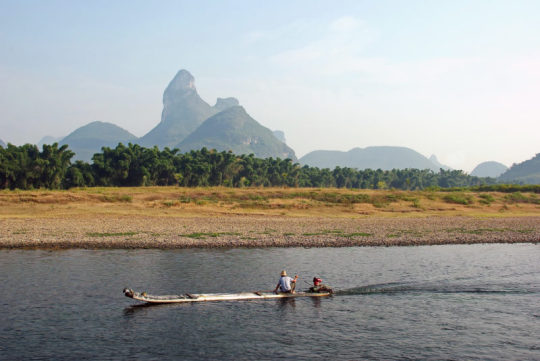
This small and charming town will be one of the most beautiful spots on your itinerary. But despite its rural location, it’s remained a popular tourist destination for visitors since the 80’s.
And although you’ll find plenty of international and western places in the city center, you come to Yangshuo for the scenic countryside. It’s the perfect jumping off point on this itinerary for exploring the natural beauty of China’s landscape.
Explore West Street
Yangshuo’s oldest road is also its most famous. Paved with cobblestones and mixing both western and Qing Dynasty architecture, West Street is a lively hub for tourists and locals alike. It’s a buzzing oasis right in the middle of the Chinese countryside!
And, it’s is also home to Yangshuo’s large backpacking community. There are plenty of hostels, western restaurants, and karaoke bars to keep you entertained for several days. And for those looking to spend the night dancing, drinking, and listening to live music, this bustling district has you covered.
Bamboo Raft down the Li River
Hop aboard a private bamboo raft and tour the spectacular Li River. You can stop by different villages, dine at river-side cafes, or relax with a book to read while you soak in your surroundings. But despite the name, these bamboo rafts are made from plastic piping, which makes for a faster (and safer) ride.
The landscape is nothing short of breathtaking as your boat glides seamlessly through the river and the rugged, limestone cliffs. And with only the sound of the humming engine to distract you, you just might find a bit of tranquility and peace on a day trip down the Li River.
Climb to the Top of Moon Hill
This unusual rock formation is named after the giant moon-shaped hole carved into the arch of the cave. As you stand below it, you can marvel at the jagged stalactites that protrude down from the arch. Rock climbing is also a popular sport at Moon Hill, with over 14 distinct climbing routes available.
And for a closer view of the arch, you can ascend the 1,000 marble steps towards the top. But if you’re eager to catch a glimpse of the entire valley, you can continue the climb to the summit for the best sweeping views.
Where to Stay in Yangshuo
If you choose to spend a few days in the city center, you’ll find many hostels and hotels on the busy West Street. Since Yangshuo is a popular backpacker destination, you should have no problem finding a clean and reasonably priced dorm bed for a few days.
On the other hand, staying in one of the neighboring villages can offer a unique experience. Many resorts or inns provide a peaceful, countryside retreat away from the crowds.
Luxury Hotels: Yangshuo Li River Resort
, Yangshuo Mountain Retreat
, Yangshuo Hidden Dragon Villa Hotel
, VISION Hotel
Boutique Hotels: Yangshuo C Source West Street Residence
, Amari Yangshuo
, Yangshuo Mountain Nest Boutique Hotel
, Humble Inn Boutique Residence
Mid-Range Hotels: West Street Hotel
, Bamboo House Resort
, Guifu Holiday Hotel
, Yangshuo Moondance Hotel
Hostels: En Attendant Godot Youth Hostel
, The Hidden House
, Yangshuo Sudder Street Guesthouse
, Mountain Stream
How to Get from Yangshuo to Shanghai
While there are several ways to get from Yangshuo to Shanghai, we strongly recommend taking a bullet train or plane. The main bullet train leaves from Guilin Railway Station and takes between eight and nine hours, while the flight is around two hours.
Although a standard train might save you a few bucks, it can take upwards of 25 hours, which can be a nightmare journey if you can’t snag a sleeper bed!
Day 10 – 14: Be Dazzled by the Metropolitan Skyline of Shanghai

In the south, Shanghai is an urban oasis, teeming with neon lights, skyscrapers, and enough entertainment to satisfy every taste. Here, the architecture is diverse, the shopping is plentiful, and the cuisine is served fresh and piping hot.
And while it feels more like glamorous and western than most places in China, Shanghai is still a buzzing cultural hot spot. Fusing ancient traditions with modern ideas, Shanghai is the perfect destination to end your journey in China.
Stroll Along the Bund
Walking on Shanghai’s waterfront boulevard boasts some of the best views of the city. Situated south from cosmopolitan high-rises of Pudong, the Bund is the perfect place for a leisurely stroll. Not to mention, it’s also one of the best sites for people watching!
Filled with performers, tai-chi enthusiasts, and photographers, the Bund is lively at all hours of the day.
And when the sun goes down, the neon skyscrapers reflect off the Huangpu River and illuminate the night sky. Taking an evening dinner cruise is one of the best ways to experience the sparkling magic of Shanghai’s skyline.
Spend an Evening in Tianzifang
Tianzifang is a charming art district teeming with designer pop-up shops, hidden cafes and trendy restaurants. As you navigate through the labyrinth of narrow alleys and stone-framed houses, you’ll stumble across some of the coolest shops in Shanghai.
At night, students, trendsetters, and tourists flood the roads looking for cocktails, snacks, and fun times in general. Because of it’s cozy, quaint atmosphere, you’ll forget you’re even in Shanghai!
Shop on Nanjing Lu
The blazing lights of Shanghai’s most prominent shopping district can be, to put it simply, overwhelming. Luxury department stores, knock-off markets, textile shops and malls line this crowded pedestrianized area. Nevertheless, it’s an exciting and authentic Shanghainese experience that you can’t keep away from.
Nanjing Lu is a shopper’s oasis and stretches south from the Bund all the way to People’s Square. But even if you’re not into shopping, you can still enjoy the boisterous and chaotic atmosphere!
Slurp Some Xiaolongbao
Commonly known to most people as a soup dumpling, xiaolongbao is a traditional Shanghainese snack that can be found almost everywhere in the city. These cooks stuff succulent dumplings with ground pork, green onion, and ginger before folding them (with precisely 18 creases) and steaming them in a bamboo basket.
The most popular restaurant is Nanxiang, which is located in YuYuan Gardens. While it can be jam-packed (and touristy), they’ve been making xiaolongbao for over 100 years, so you know you’re getting the good stuff! You can’t miss this place during your 2 weeks in China.
Where to Stay in Shanghai
As China’s largest city, Shanghai has a large variety of hostels and hotels to choose from. You can find chic boutiques in the French Concession, opulent resorts on the bund and even dorm rooms tucked away down an alley.
While you can score good deals on rooms, the average cost of a hotel in Shanghai can be high.
Luxury Hotels: Shanghai Mariott Hotel City Center
, Sofitel Shanghai Hyland
, Radisson Blu Hotel Shanghai New World
, Le Royal Meridien Shanghai
Boutique Hotels: The Yangtze Boutique Shanghai
, SSAW Boutique Hotel Shanghai Bund
, Les Suites Orient
, Shanghai Chi Chen Boutique Hotel
Mid-Range Hotels: Shanghai Fish Inn East Nanjing Road
, Riverview Hotel on the Bund
, Majesty Plaza Shanghai
, City Hotel Shanghai
Hostels: Shanghai Blue Mountain Bund Youth Hostel
, Shanghai Meego Yes Hotel
, Rock&Wood International Youth Hostel, Mingtown Etour International Youth Hostel
Ending Your Trip in Shanghai
Sadly, all great vacations must come to an end. And after two exhilarating weeks in China, it’s time to head back through one of Shanghai’s two international airports.
Remember to give yourself enough time to check in luggage and get through customs at the airport. Lines tend be longer compared to other airports, and can take upwards of two hours.
But as your plane soars past the city lights of Shanghai and over the Pacific Ocean, you’ll have plenty of incredible memories to take back home with you.
How Much Will 2 Weeks in China Cost?
The cost of your trip to China doesn’t necessarily depend on where you travel, but how you travel.
The Cost of Transportation in China
Getting to and around China is likely to be your biggest expense. Depending on where you’re traveling from, international flights into Beijing or other major cities can cost around $600 to $1,500 per seat.
Once you’re in the country, you’ll have a variety of options to travel from city to city. Domestic flights can save time and energy, but they will almost always cost more than ground transportation. On the other hand, trains are much more affordable (especially the slower, regional trains) and can be nicer than other ground travel options for your 2 weeks in China.
Taxis are also relatively cheap, even in big cities like Beijing and Shanghai. But most places are well connected by subway, which is affordable and surprisingly easy to navigate.
The Cost of Accommodation in China
Accommodation costs vary greatly depending on the type of place you are staying. Luxury hotels can cost almost as much as they do in western countries but come with all the comforts that you’d expect.
If you’re on a budget, you’ll find plenty of mid-range hotels in every city for your trip to China. These can cost anywhere from $30 to $100 a night and are usually reasonably spacious and clean.
Hostels are a popular choice if you want to spend the least amount for accommodation. In big cities, you can find shared dorm rooms for around $20, while smaller towns can be as low as $10 a night.
The Cost of Food and Drinks in China
Everyone around the world knows China for its cuisine, and you can find a range of restaurants when traveling through the country.
Snack food is delicious, cheap, and can be found on almost every corner. From dumplings to meat skewers to pancakes, these snacks are a great way to sample the local culture while also sticking to a budget. Best of all, it will only cost you a few bucks!
Keep in mind that international or western restaurants will almost always cost more than Chinese restaurants. The only exceptions are Chinese delicacies like Peking duck, shark fin soup, and other luxury seafood dishes.
Travel Insurance in China
Travel insurance is one of the most important, if not the most critical thing to have on your China itinerary. Whether you come down with a bad case of food poisoning or break your leg in a scooter accident or during another activity in China itinerary, you’ll be glad to have travel insurance.
Not only does travel insurance in China cover the cost of your medical treatments, but it also protects you against other incidents that might occur.
Your $800 iPhone that some thief swiped from your pocket on the train? Or that thunderstorm that canceled your flight to Beijing? Travel insurance covers both of those situations, too.
The last thing you want is to have thousands of dollars in medical bills or pay for your lost or stolen goods straight out of pocket. And since it only costs a fraction of your total trip, there’s no excuse to travel without it.
There are plenty of travel insurance companies to choose from, but some policies and benefits are better than others. We recommend World Nomads, the leading travel insurance for all types of backpackers and travelers.
Click here for our full World Nomads review or fill out the form below for a free quote!
Final Thoughts
China is brimming activities for every type of traveler. From the great outdoors to the Great Wall, you can spend a memorable 2 weeks in China.
This China itinerary highlights the main attractions for a two-week trip, but you should feel free to make it your own! Take that last-minute trip to the neighboring village for a few days, explore the back alleys of the city and get off the beaten path. You never know what awaits you around every corner.
Because really, there’s no right or wrong way to see China.
READ MORE:
source http://cheaprtravels.com/china-itinerary-how-to-spend-2-weeks-in-china/
0 notes
Text
Switzerland -- a snow-capped wonderland

Two Traveling Lanes
Szerland High
There are few places I’ve visited that rival Switzerland in raw beauty and sheer wonder. Want to walk inside an ice cave with millions of sparkling ice crystals? How about cross a suspension bridge 10,000 feet above sea level and stare into the abyss below?

David and I shared a kiss at the top of the Schilthorn in Murren
Surely you’d want to scramble up a waterfall inside a mountain to see and hear the roar of 5,000 gallons per second cascading into a bottomless pit mere feet in front of you? How about soaring in a rotating gondola high above snow-capped mountains, enjoying a 360-degree view as steep rock faces and deep crevasses open up below your feet?
In just two weeks, we lived and breathed the beauty and culture of Switzerland, from the German-influenced regions in the north to the French and Italian regions west and south. While it truly was a feast for the eyes, we soaked up so much more than the country’s magical scenery in those short 14 days.
Live like the Swiss
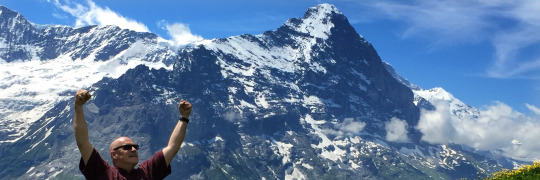
Ok, I was a little bit excited about reaching the top of this particular mountain. Being surrounded on all sides by incredible beauty is a bucket list moment, for sure.
We learned to love cheese and muesli at breakfast, conversed with locals about American politics, marveled at the flowers in nearly every window and came to appreciate the transportation genius of the country.
We felt like we belonged there, hopping easily on and off trains and navigating 10-syllable addresses with ease. We rode in swinging chair lifts, cable cars, gondolas, funiculars (railways that travel almost straight up), electric cog railways, trains, buses and one luxury bus. We soared past mountains of staggering heights, walked through alpine valleys thick with yellow globe flowers and smelled the crisp, fresh air in between.
All the while, grasshoppers and cricked played their soulful melody, trumpeting the arrival of summer in a country more known for its winter wonderland than kelly green pastures.
Use our two-week itinerary
With a little advance planning and our fool-proof itinerary you, too, can feel like a part of Switzerland for two weeks, whether you choose to visit in the summer like us, or opt for skiing and snowshoeing in the winter. It’ll cost you a lot less than hiring a travel planner or tour company, too. If you have fewer days to visit, simply omit a stop or two. If we can do it, you can, too!
We traveled to Switzerland in June 2016 with our youngest son and daughter, college students at the time. We told them it’d be our last big trip together as a family and started planning where we'd go. In a world full of possibilities, Switzerland got more nods than any other location for three big reasons: it’s overseas, vastly different from our Florida home and full of natural and man made attractions.
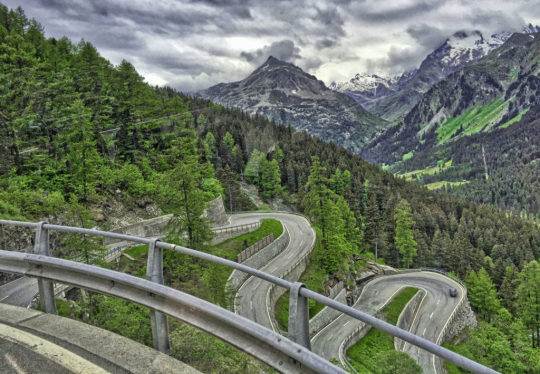
The views from our bus, traveling from Lugano to St. Moritz, were fabulous
What’s not to like about snow in June?
Indeed, our children were perhaps the only kids in their college classes that year to go sledding down a mountain near Europe's highest altitude railway. They were perhaps the only ones to walk along the sheer cliffs of a snowy mountain so high, it evoked a fear of heights in David.
And our daughter was perhaps the only senior in her class to almost careen over the edge of the Alps on her foot scooter, causing major road rash but, thankfully, no broken bones or head trauma.
But more about that late-vacation tragedy later.
Download the train app
The trip started uneventfully enough, with a long plane ride from Miami to Zurich and an earnest effort to learn the country's train system. David and I had planned the two-week odyssey on our own, using advice from a few well-known travel planners and many internet sites. We wanted to see the highlights of all regions of Switzerland so we booked six hotels in diverse areas, making sure to enjoy the German, French and Italian flavors of each sector.
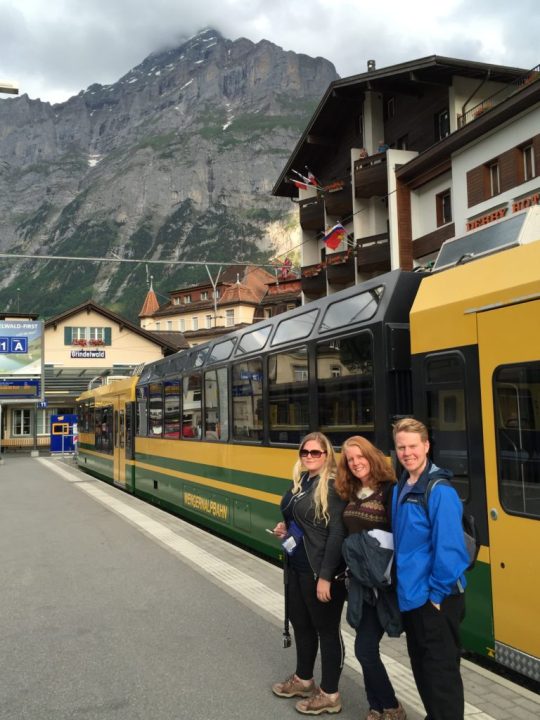
One of many trains we rode during our two-week stay
Though we saved money planning the trip ourselves, make no mistake: hotels and food in Switzerland are expensive, even by European standards. If you're not prepared to pay $25 for a modest restaurant meal, or shell out a few hundred dollars for an overnight hotel stay for four, don't bother going.
Switzerland is an affluent country, and it expects you will be, too. Daughter Julie still recalls the shock of learning that Burger King at a Lucerne train station was selling hamburgers for nearly $10 apiece. Fries were extra.
We downloaded a few smart phone apps detailing the country's train schedules, and used both for a few days before settling on a favorite. We liked SBB Mobile the most. It allowed us to put in a destination and be guided to the correct train station, rail platform and direction, along with showing us departure and arrival times. It took a few days but we finally got the hang of it -- with a little initial help from an employee at the Zurich train station.
Three countries in one
Switzerland doesn't have its own language, so each region's language and culture are influenced by its closest neighbor. We found it amusing to speak and read so many different languages in a single country. Stop signs and menus in Zurich (with a German influence) looked completely different from those in Lugano (inspired by Italy), both of which were unrecognizable in some areas of Bern (French). Most of them spoke fluent English, so communication was rarely a problem.
One thing all areas had in common was the price of things. All prices were listed as CHF, or Swiss francs. Lucky for us, 1 CHF is roughly equal to $1, so we didn't have to do any math to convert to US dollars.

Since we planned to rely solely on public transportation and forego a car rental, we bought two-week Swiss Travel passes online and booked hotels, in advance, within walking distance of train stations.
Hotels near train stations
We found this information online and used booking.com to secure our reservations. The rail passes gave us unlimited rides on all trains except those to unique tourist attractions like Jungfraujoch Top of Europe, the highest altitude railway in Europe, and the Gornergrat in Zermatt. It offered discounts on those.
Although we'd done our research thoroughly, there was always a little trepidation each time we stepped off a train, luggage-bound, headed toward a new hotel.
Was it truly where we thought, or would we discover it's nowhere to be found?
Luckily, we discovered all six hotels were indeed within walking distance of a train stop. We used Google maps on our smart phones to find the hotels and other attractions, although the language barrier and extremely long German names made it challenging at times.
Packing light is key
One time we had to find a hotel in the rain, making for some soggy luggage once we arrived. We packed only one carry-on bag each because we knew it'd be a chore to lug large suitcases from train to hotel each time.
To manage our limited space, we took advantage of washing machines in hotels that had them and handled the 50-degree temperature difference between Lugano and Zurich just fine.
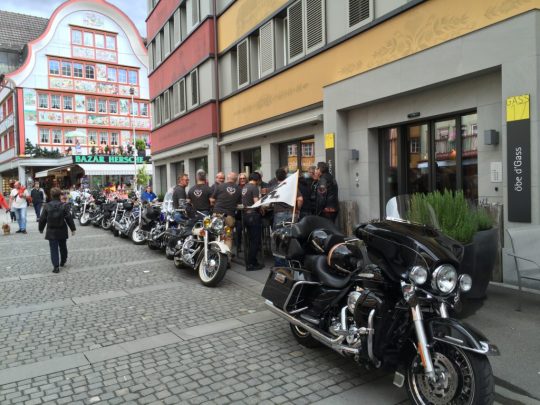
Motorcyclists gathered on the street of Appenzell
After a night in Zurich getting our bearings, we took a train to St. Gallen and checked into Idyllhotel Appenzellerhof. It reminded me of a large, older home and was oozing with charm and friendly employees. I loved how Swiss German speech sounded like a song, with the notes and words rising and falling in a beautiful melody. We also savored with the food here, especially the traditional Swiss breakfasts.
Many of our hotels offered breakfast buffets much more substantial than their American counterparts. There was usually a wide variety of hard-crusted bread, rolls and croissants with various jams and honey, muesli with fresh fruit and yogurt, potato fritters, a wide selection of cheeses and cold cuts and cereal along with juices, coffee, tea and milk.
Appenzell is feast for the eyes
After settling into our two-room suite we took a train to the nearby village of Appenzell, a quaint, car-free town with beautiful streets and a myriad of small

Gravesites were meticulously groomed and covered in flowers
stores and boutiques. Geraniums, petunias and daisies bloomed everywhere, from window boxes of homes and stores to planters in train stations, roundabouts, bridges and cemeteries.
We were especially impressed by the colorful grave sites. Awash in a sea of red, yellow and purple posies, each one looked like it could have graced the cover of a home and garden magazine. The facades of the German-inspired buildings at Appenzell are decorated with colorful paintings, making them all the more whimsical and fascinating.
It was here that we got our first taste of authentic wiener schnitzel and Swiss sausages, many of which are white. It was a startling sight at first, but the unique taste and smooth texture of the St. Galler bratwurst won me over. Made of veal, pork, milk and spices, including sweet cardamom, the white bratwurst has been a staple in Switzerland since the 1400s.
Of course, what better way to wash down a good sausage than local beer? We toured a small museum at the Appenzeller "Bier" brewery and enjoyed several samples of the ale. Jonathan was a month shy of his 21st birthday but was excited to learn Switzerland's minimum drinking age for beer is a mere 16.
He arrived five years too late, by his estimation.
Watch out for bubbly water
One customary drink I never learned to swallow was carbonated water in bottles. It was hard to discern which bottles contained carbonated or "still" water, as they called it, so we mostly avoided bottled water as a result.
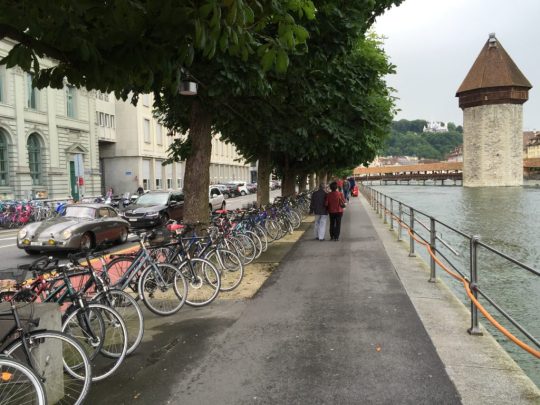
Overlooking the Chapel Bridge in Lucerne
We bid farewell to the beautiful Appenzell region after a few days and headed south toward Lucerne, a city David and I had visited in 1989 as part

The streets around our hotel in Malters, near Lucerne
of a three-week tour of Europe. It was fun to revisit such famous places as the Chapel Bridge and Lion Monument, and to soak up the rich architecture and vibe of this historic city. We noticed that thousands of people had written or carved their names into the wooden hand railing at Chapel Bridge,
We stayed a few miles outside town at Hotel Kreuz, near the Malters train station. It was a large,
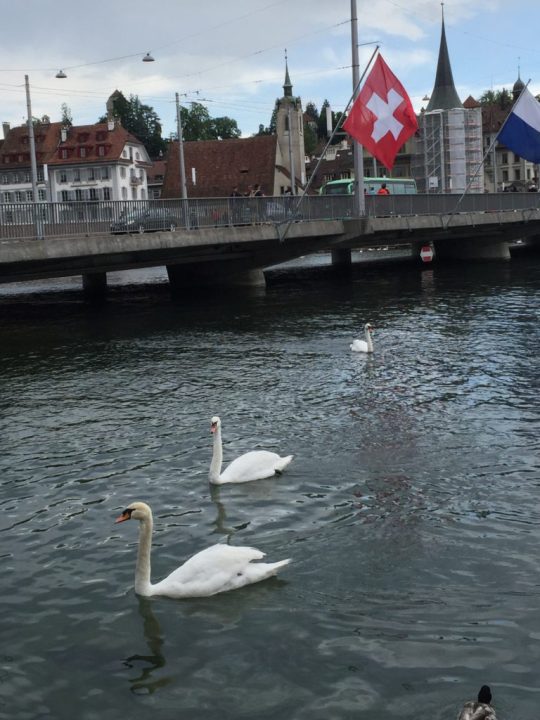
Swans are everywhere in Lucerne
Bavarian-style hotel with homey furnishings and a window view of an extraordinary church steeple. We rose early the second day to get in a full day at Mount Titlis, the highest peak in the region and home to a glacial paradise with thrilling cable car rides, a zip line, ice cave and suspension bridge between two peaks.
Into a snowstorm

Deep inside a tunnel that goes through the solid ice glacier there was a plant visible that must be thousands of years old.
It took about an hour via train to get from Lucerne to Mount Titlis, and once there we were whisked about halfway to the top in a small cable car just perfect for our family of four. Although the weather was partly overcast and drizzling, we had several clear views as we floated up the mountainside. About halfway up, we got off the small cable car and got inside a much larger, rotating gondola for the final ride to the top.
Once there, we walked outside onto the glacier and into the middle of a massive

The views from the top of Mount Titlis were breathtaking.
snowstorm! It was snowing so hard we couldn't see much of the distant scenery, but it was gorgeous staring down into the crevasses below while snowflakes danced around us.
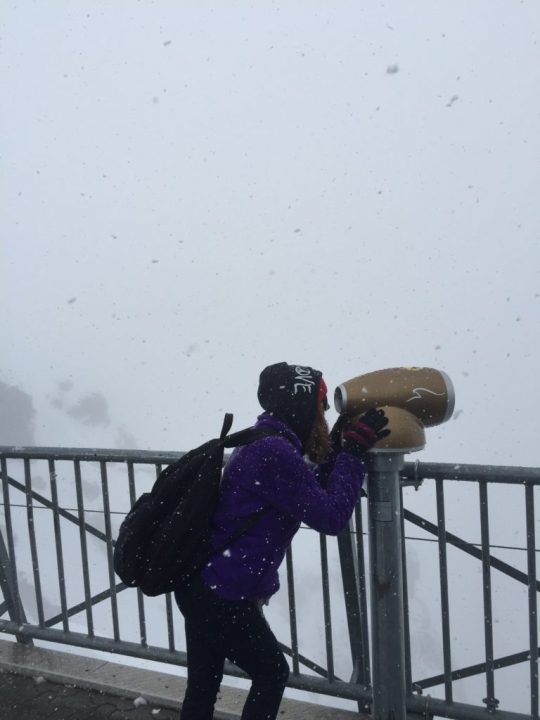
Keeping a close eye on the snow
We'd read about the dramatic temperature changes at Titlis and were prepared with coats, hats and gloves. After playing in the snow until our toes and fingers froze, we sought refuge inside with a cup of hot chocolate. Once warmed, we made our way to a lower level and the ice cave, its sparkling crystals and ice sculptures illuminated by soothing blue light.
We opted not to ride the zip line or walk across the suspension bridge because the snow had wiped out visibility by then. We played in the snow some more and had lunch in the mountain top cafeteria before heading back for another scenic ride in a cable car.
Read the full article
#BestplacestogoinSwitzerland#BestplacestoseeinSwitzerland#BestplacestotravelinSwitzerland#HikinginSwitzerland#HowexpensiveisSwitzerland?#Swisstravel#Switzerland#Switzerlandtravel#WhattodoinSwitzerland#WhattoseeinSwitzerland#WhenshouldIgotoSwitzerland?#WheretogoinSwitzerland
0 notes
Text
Friday, January 13th to Saturday January 14th, 2017- Gili Air, Mt. Bromo, Yogyakarta
It's on this day I say good bye to the enchanting Gili Air and begin to squeeze in more of Indonesia - or at least as much as possible in my remaining 6 days of travel. Next stop is East Java where Mt Bromo is, the next mountain I want to conquer... but first I have to figure out how I'm doing that... with a twist: while I'm literally traveling there.
What I mean by this is; I have no concrete plans on how I'm going to get to Bromo, but the goal is to do it on this night, to technically see sunrise. All I have sorted so far is the ferry off Gili Air and a bus on the other side to take me to Lombok International Airport, where I've seen online many flights departing that work in my favour, so I'm taking my odds and going in just a little blind.
The ferry was the easy part: a short 20 minutes on a 20 person fishing-like boat. Nothing like the 'fast boat' we took to the island-- in fact the exact opposite.
In the harbour on the other side, it was a slight panic as locals greeted the boat asking arriving passengers if they needed transport, which was me, but I had transport pre-arranged as part of shuttle bus, so I struggled for a couple minutes cutting through the noise to hear what was relevant for me and found MY guy pretty easily.
An older couple, maybe 50 years old and German, were also on a similar trajectory. They ended up with MY guy too, but their struggle was laughable and entertaining to watch. He (of the couple) had a face that was permanently grumpy (imagine grumpy cat, but on a man) and the woman would always look to him for guidance or direction, but he hadn't a clue. His grumpy face would sometimes gain an injection of confusion or difficulty as he tried to manage their huge piece of luggage off this little fishing boat and on to the beach and then finding THE guy he needed.
I think I got such entertainment from this couple because they seemed like the 'all-inclusive resorts' type; you know the type that wants everything done for them and wants to just relax without stress. Thus, they weren't ready for the spice to life island life brings ;)
We (myself and this German? couple) wound up with the same GUY, who directed his friends(?) to grab their luggage - since they were struggling - and we all went to a horse-drawn carriage that we maxed out with us four bodies (our GUY, this couple, and myself) and our luggage. It was pretty funny. Especially when the couple didn't want to tip the dude carrying their luggage for him. Shame on him.
So we're all in this carriage for about 20 minutes as we trust that this GUY is legit and actually taking us to our bus...which he did :)
We waited for the bus for an hour, which was great because I could get some breaky and find some WiFi to figure out how I'm getting to Bromo.
I found some tours that included airport pick up, hotel, trek up Bromo, and drop off where ever I wanted, so sent maybe 6 email inquiries hoping that one of them would reply by the next time I reach WiFi, and not to mention could pick me up in like 10 hours at this point.
The bus to the airport was long. Very long. I tried to relax, but the windy roads quintupled with the crazy driving wouldn't allow. Did I mention that drivers pass other drivers at any moment. Regardless of lines, corners, oncoming traffic, etc, they'll give warming with a tap on the horn and somehow pull it off.
At the airport I found the ticket office for LionAir, the cheaper of the airlines I uncovered earlier, and bought a ticket with a sigh of relief. Now to figure out what's happening on the other side of this flight.
I found WiFi and welcomed two replies in my inbox, so now it was a race between them to see who I can confirm first....and with two hours to spare before my flight departed, I confirmed a driver to pick me up and the whole nine yards. WOO WOO
Yes the price was a little more than what I would've liked, but I got exactly what I wanted and nothing more or less-- my itinerary was perfect.
Since I had some stress free time before my flight, I started thinking about the other side of Bromo, so what the fuck I was going to do tomorrow after the sunrise trek and essentially where I was going to be dropped off.
I knew I wanted to go to Yogyakarta in Central Java next, but hadn't a clue how I was going to get there, so I did some digging and found a train! At a fraction of the cost of a plane, but about 5 times as long, the train schedule lined up perfectly; I couldn't have planned it better.
So in full, the day would look like this;
1) Ferry from Gili Air to Lombok
2) Shuttle bus from the harbour to the airport
3) Plane to Surabaya airport in East Java
4) Driver from Surabaya to Mt. Bromo
5) Driver from Mt. Bromo back to Surabaya
6) Train from Surabaya to Yogyakarta
^^fun note: this all happens within about 36 hours of each other. Crazy right!
After the dull plane ride and the crazy drive from the airport in the rain and traffic to Bromo, I checked into my hotel at about midnight, so I'm now into the next day and have ~4 hours until we leave for sunrise over Mt Bromo.
With nothing more than a nap, my driver and I left for a 20min drive to base camp for going up. It was dark. Wet. And cold. Like Canada cold, but luckily I knew what I was doing and bundled up with my touque and gloves and lots of layers.
My driver dropped me at the trail and gave me some loose directions. Although it was just me - technically, there dozens of others trying to catch the sunrise from the top too, so I followed the path while keeping an awareness of what the other groups were doing to not go anywhere I wasn't suppose to.
The first 30 min of walking up a gradual hill of gravel road was easy and spat out at the first of two view points. This particular one wasn't anything special - besides it being pitch black; you would just see the town below and the crater around the volcano.
Oh yeah, Mt. Bromo is an active valcano.
So I kept on keeping on up the next bit of the climb. It turned to steps, kind of, for another 45min or so to the top. But it wasn't really the top, it was a peak called Seruni Point. Yes, you could keep going up, but it would have been some serious bushwacking and very vertical.
It was here that I chilled and watched sunrise. I found a good spot and struck conversation with this group of kids that had rode their motorbikes over night for 6 hours in the rain to catch the sunrise...crazy kids!
I told them I/we are the same: going to crazy distances/lengths to catch the sunrise.
The sun itself created a nice glow on the town below and the crater beside us. Although it was stuck behind the rain clouds for a bit, it showed its face and provided some good photo opps. I revealed in its glory, once again being reminded on a) how fucking fortunate I am to be enjoying this moment and b) how the fuck did I pull this off -- hahaha
Now the sunrise wasn't the most exciting I had seen on the trip, it was the most illuminating, meaning now that it was light out, I truly got perspective:
Although I thought I was going up Mt. Bromo, I had climbed Mount Penanjakan and gotten to Seruni Point, which is the mountain next to Bromo. The sun rose over Bromo and it's crater and the village of Cemoro Lawang below. The crater I was looking out to actually housed my hotel, among other buildings of the village. (An appreciation I didn't have until now and then to be reaffirmed by Dad via text later). If I wanted to check out Bromo, it would require a few more hours to not only descend Mt. Penanjakan and drive back to the village, but a walk across the Sea of Sand and only then be able to elevate myself on Mt. Bromo, physically.
Now as much as I wanted to do all of this, it was beginning to rain like a mutha fucker (and if I've learned anything on the trip, it's that when it rains, it pours) and as ready as I was for rain - umbrella, jacket, boots, etc - I wasn't feeling it. And in actual fact, I was feeling like I had done what I came for: to see the sunrise and Mt. Bromo.
*Looking back as I write this and read more about Bromo after the fact, I kinda wish I wasn't a big baby and just did it. But, now I have a reason to bring go back, but with company this time*
Anywho, the sunrise ended and I have to check out of this hotel, but first it's time for breakfast and figuring out this train situation...
Nowhere online would let me book a train ticket and no blog or equivalent was helpful, so I asked real people: first my driver, who had no clue, then the hotel desk, which also had no clue, but he asked his friend who said you can get them at the Indomaret (Seven Eleven of Indonesia). "OK, so the Indomaret eh, I can roll with that", I was thinking, so got my driver to make the stop en route to the train station.
At the first Indomaret, there system was down, so couldn't help.
The second Indomaret taught us that you can't buy train tickets on the day of departure unless you're at the station.
Oooooooo kaaaaay, I guess I'm taking a leap and getting dropped off at the station hoping there's a ticket for me-- which there was! WOO WOO!
Once I grabbed my ticket, I found a snack at Dunkin Donuts - which is super popular in Indonesia, alongside KFC - in case you were wondering - and hijacked their WiFi to find accomodation after this train in Yogyakarta.
I found this quaint homestay 25min walk from the train station, in a relatively central neighbourhood at a great rate. Boom! I now had somewhere to sleep for the next few days, phew.
The train was fun and really long. Like 7 hours long. But it was fun. There were lots of kids who took a fancy to me and I sat across from a young couple and their newborn, whom spoke English well enough for continued conversation. It gave me time to read and have a breath.
Arriving in Yogyakarta at about 9pm in a slight drizzle of rain, I took to the streets on foot to get a sense of the city, the neighbourhood, and the people before calling it a night.
My homestay turned out to be in an even-better-than-expected neighbourhood close to little street venders, big clothing stores, food, ATMs, etc, all the while being out of sight and very quiet.
Although this place cost a few bucks more a night than a hostel, I had my own room, which was heavenly for a change. (I hadn't had my own room since Vietnam).
And with that, I could sleep with ease! Especially since I'd never been more tired on this trip than now and felt like sleeping for an entire day!
So I did! After leaving Gili Air 40 hours ago at this point which included 1 ferry, 1 plane, 1 train, two longs drives, a mountain, and shit ton of walking, I called it a night.
BOOM! Another great series of adventure, wonder, and suspense :)
1 note
·
View note
Text
Hong Kong - Macau on a Budget: Our Php9,694 Itinerary

Hong Kong Disneyland is a childhood dream. Anybody who says they're too cool for that can suck it. Plus, it’s just a ferry-ride away from Macau!
Living in the Philippines, Hong Kong is so accessible and is a great first out of the country destination. It's just almost 2 hours away by plane, there is no time difference, and there are no shortages of fellow Filipinos you could talk to.
It's also only my second out of the country.
Last year was a month-long backpacking in Thailand with no itinerary whatsoever and this time it's a 4D3N HK-Macau escapade... so believe me when I say that, to me, this was too short a trip and that I got too intense and excited with the planning.
For details on how we budgeted our trip and if you're trying to determine how to know if you need an iVenture Hong Kong and Macau Attractions Pass or not, head to this post:
How to Determine if an iVenture Hong Kong and Macau Attraction Pass is Right for You
What is an iVenture Hong Kong and Macau Attractions Pass? Check this link:
KLOOK: iVenture HK-Macau Pass

ENTRY:
Filipinos can stay in Hong Kong for up to 14 days without having to apply for a visa. This does not mean you can always simply just waltz through. To learn more about how we got stopped by an immigration officer upon entry and how we got through it, this post might be helpful:
Hong Kong Entry : Got Stopped by an Immigration Officer: http://alettertotheuniverse.com/post/175956612343/hong-kong-entry-got-stopped-by-an-immigration
Arrival:
After getting through the checks, although excited to hop on a bus, it was first things first for us!
For this trip, we pre-ordered the following essentials through KLOOK in advance:

Octopus Card
HK's transportation system is extremely impressive (I couldn't shut up about it during our whole stay.) The metrorail system is easily accessible, connects you seamlessly to where you need to go, and there's a train, like, every 2 minutes so it's rarely cramped.
We knew we'd be going around a lot and would be using the MTR mainly, so we decided to get the Octopus card which is basically like our beep card wherein you top it up pre-trip and simply swipe it when your ready to board the train. It is also widely accepted by the buses so you will no longer have to wait in line to get a ticket or look for spare change.
With our itinerary, we approximately used up about $150HKD (Php1022) Octopus card top up.
You can get the Octopus Card at the airport for $100 plus a $50 deposit (you get this back when you return the card), so a total of Php1022 as well - not including any credit though.
We know we wouldn't be able to return the card as our return flight will be from Macau, so we got ourselves a discounted one from KLOOK. It's at Php641 and comes with a $50HKD top up already.
The link is below if you want to check it out:
KLOOK: Octopus Card
4G SIM CARD
I NEED MAPS! All the time. I'm just lost without it, literally. *wink*
And ofcourse, I need to stay connected with my travel buddies so we got ourselves a 4GSIM (China Mobile network) off KLOOK simply because I've learned that sim cards sold at the airport are wayyy overpriced. Plus securing one beforehand is just so convenient.
The card we got is the 5day 4G SIM priced at P361 and would give you 1.5GB 4G Data plus $18HKD load.
Was the 1.5GB enough for our stay? Yes, it was and I didn't even have to restrict my use. Of course, I didn't bingewatch series or anything and our AirBnb had Wifi anyway. But it was enough for Maps, Google, and your social media needs while on the go.
Was the internet fast? YES. Wherever you go.
Link is below if you want to check it out:
KLOOK: HK 4G SIM
Was it easy to pickup: Yes. The voucher comes with specific instructions on where to pick it up at the HK airport. The sim and the Octopus card can be picked up on the same booth.
Accommodations:
Unless you are on a luxury trip, you cannot be picky with accommodations. The rooms just aren't spacious to be honest, especially the bathrooms. But that's just how it is at Hong Kong. It costs around $300HKD a night for a double room.
We got one at the Jordan area where they also sell cheap pasalubongs
Anywhere is a good place in my opinion as long as it's close to the MTR.

Now that that's out of the way, we finally get to the part I'm most excited to write about: the places and activities!
Ngong Ping 360



We board the bus off the aiport at around 9:30am and first went to Ngong Ping 360 Cable Car.
Basically, to get to Lantau Island, we wanted to ride the cable car which goes over several mountains and gives you a beautiful Hong Kong city view from the top.
Our choice was to experience both the standard cabin and the crystal cabin (wherein you can also see the view through the floor of the cabin). We got a discounted ticket from KLOOK for this as well which costs P1139.
Link below:
KLOOK: Ngong Ping 360
You may also ride a bus to get to Lantau Island if you are not into the cable car route, so don't worry.
Ngong Ping Village, Lantau Island



In this island is the Ngong Ping village which is where you'll be dropped off by the cable car. It's a dainty village showing off beautiful, traditional architecture and cobblestone streets. Their 7-11 store design is so cute. In the square, you'll see a carabao roaming around
Tip: You may drop your bags off a counter as soon as you get off the cable car. Just ask around for it, it shouldn't be hard to find.
Tian Tan Buddha

After taking (quite a lot) of photos of the village, we went to see the Tian Tan Buddha which was atop a 250-step staicase.
To me, there's really something about big Buddhas that is extremely humbling and calming.
Once at the top, you'll get a great view of the island and you'll see the intricate details of the Tian Tan Buddha. Keep in mind to be respectful though as some people are praying at the foot of the Buddha and at the square.


Drop by the Po Lin monastery as well if you have time. It's all in one area within walking distance.
If you are into a formal tour with a pro tour guide and everything, the below link may prove to be useful:
KLOOK: Lantau Island Day Tour
The Peak

We left at noon to catch the KLOOK rep at Central Station who will take us to the tram which is also something new to me (in one day, I already gained new transpo experiences: cable car and tram).
This was a really cool experience - one of my favorites.
We got to go up the side of the mountain on a really old but still well kept train, while looking out the window into an amazing view. Once we got there, we directly went unto the top of the Sky Terrace 428 (the actual Peak) and was greeted by the best, highest view of the Hong Kong cityscape.
This is what we have availed for PHP625:
KLOOK: The Peak Fast Track Combo
Heading out, you'll pass by the 3D Art Museum. I'm not if it is always for free bit it was that day.
Other activities in this tower ar Madame Tussauds Wax Museum and Chocolate Art Museum.
We were supposed to go out that night but we were so tiiiired, we decided to simply check into our AirBnb and have dinner around the Jordan area.
We ate this delicious spicy squid dish that was around $120HKD which is a bit pricey as per most good dishes at Hong Kong are. Good for 2-person sharing though.

I tried to stop multiplying my expenses by 7 but it was just so hard to stop converting HKD to PHP, lol. Checkout other dishes we got to try within our stay:
Disneyland



Day 2 was a full day at Disneyland. It was every bit amazing as imagined.
The Ironman experience, It's a Small World, and the Magic Manor are my top 3 favorite rides.
There was a tribute to Mickey that night wherein they projected Mickey clips across the whole street making the building walls come alive. The closing parade was magical. It was just epic.
I made a whole separate post just in tribute to it so there, check it out and feel my feelings with me:
A Day of Disney Magic
Man Mo Temple

Day 3 was our cultural day. Also, all the places we visited that day didn't involve entrance fees. Yay!
There's a lot of free things to do in every country. Just walk around a city and experience the local life.
It was such a unique experience to be inside this temple. Every corner felt so... spiritual? And eerie, but in a mesmerizing way. It may be because of the incense, the lighting, and the hanging lanterns... but it's so hard to describe unless you get to experience it (so go experience it!)

I also got my fortune told for $30HKD which is cool to say and all, but really it was only 2 minutes and less exciting. Hahahaha. He just told me something about not quitting my job until September. Meh. I wasn't planning to anyway.
I mean, do this for the experience, like I did, but if you are on a really tight budget, you won't miss a lot by skipping this.
Kowloon Walled City
We were supposed to tour around the infamous walled city but during our stay there was a typhoon (signal warning number 1) so we went to take cover instead for a few hours at Chi Lin Nunnery. Guess I'll just have to come back to HK next time for a tour of Kowloon's walled city. :'c
Chi Lin Nunnery

The most peaceful place I've ever visited as of date (the rain helped with the cozy ambiance, I guess). Like the Man Mo Temple, it's really hard to explain the effect of these places. There's just calm and spirituality in the air. And the design of each corner of this place is wonderful and intricate.
Again, it's a place of worship for some people there so be extra cautious and respectful.
Victoria Harbour: Symphony of Lights Show

It's at 8pm every night!
We watched from the Avenue of Stars (we were literally running to catch it on time).
Sat beside the bay to watch the sky and the buildings light up.
You definitely must not miss this!!! I love Hong Kong at night and this is part of the top reasons why.
See my post dedicated simply to HK's after sunset magic:
Hong Kong at Night
This was our last day at HK so we went around Jordan's night market to buy pasalubong and to eat.
I'm not sure why Filipinos say things are cheap at HK so it's a great place to shop around but from my experience, things... weren't cheap?
I kept converting it to PHP, so to me a $100HKD blouse is equivalent to PHP600+. Don't they do that? Or have I just not found the right shopping places? Do let me know.

Macau
We only had a few hours stay in Macau and the typhoon warning was raised to signal number 2 so... we were't able to get to the place I was looking forward to the most: the Ruins of St. Paul.
But here's how we spent the few hours we had:
We boarded the Cotaijet Ferry at 10am.

The trip was about an hour and the transaction was actually hassle-free.
Tip: We got a PHP1091 discount voucher from KLOOK and we exchanged it for a ticket the day prior (we did this on Day 3) - to reserve a 10am slot.
For more info about the voucher, here's the link:
KLOOK: Hong Kong - Macau Cotaijet Ferry
Tip: Upon arriving, we boarded one of the free buses. These are everywhere and are provided by the hotels even if you do not check into them or are not availing anything from them. You won't have to pay for transpo honestly if you simply want to see the tourist spots. These buses will give you a free ride.
Tip Again: Cotaijet personnels will offer you free discount vouchers upon arriving (they just hand them out when you walk by). TAKE THOSE. You'll get loads of discount coupons and we even got a free pass to the Parisian's Eiffle Tower viewing deck which would have cost us $100HKD otherwise.
Good to know: No need to change your money. Macau widely accepts HKD.
The Parisian

The hotel interior is a tourist spot in itself. It's just grand.
The ceiling paintings are mesmerizing. Plus the staff are extremely accomodating.
Good to know: $20HKD temporary lockers are available at the lobby. Only accepts exact cash though. If you don't have $20 bills/coins, head to the Casino or Main Reception to have your bills exchanged.
At the Parisian, you can visit their replica of the Eiffel Tower. It includes a small tour of the history of the construction of the tower and a viewing deck.
At the viewing deck, there is also a recreation of the the Love Locks bridge.


It's $60HKD to get your lock or, you know, just bring your own.
So if you're like me who can't afford Paris yet, this place is pretty amazing and is the best part of my Macau stay.

The Venetian
This hotel is just a passageway away from the Parisian. You won't even have to go outside again.
Have you ever been to the Venice Grand Canal in Mckinley Hill, BGC? It's like that. It's basically the same, really.

It's like Venice streets inside a mall. It even has a moving sky projected in the ceiling. (In my opinion, the one here in BGC looks better so if you haven't been, you should.)
Tip: Try the $10HKD cheesecake. It's nice.

Hope this was helpful. If it was, do drop me a line in the comments or messages.
I hope you get to visit HK and Macau! If you already did, what are your favorite memories?

Extremely fortunate to be experiencing this,
N
0 notes
Text
Day 4 - ‘Empire State of Mind’
Today I finally decided to start my travel blog! I was playing with the idea of doing something to document the trip as I go, but hadn’t settled on exactly which approach I would take. I have decided a written blog would be the best approach to kick things off as one of the big things I wanted to develop whilst I was out on the road was my storytelling skills. Writing/Directing is the route I do wish to go down and this trip is supposed to feed directly into both of those things. I think the writing will likely start a little rusty, but as with most things, the more practice I get, the better it will get.
So, the blog… well yeah, I started a blog. Why are blogs called blogs? Seems like a strange word to just call something. Is it short for biographical logs maybe? I will have to Google it when I get some internet! Anyway, I digress. I spent the morning setting up a pretty straightforward blog on Tumblr with the intention of writing in it daily to document my trip. For now, I aim to add pictures alongside my posts, and I will maybe expand to some video down the line. I am keeping it to the writing/pictures for now though just to make it more manageable. I mean, this is already time-consuming to be fair. I have to edit a tonne of pictures from each day, pick a selection, and write from memory how the previous day went start to finish. I think I will stick to doing these biographical logs on the mornings of each day with a coffee. Seems the best option. If I post them around midday US time, they should be live by the time folk back in the UK are finishing work too. Could work! Anyway, I spent the morning writing and I also booked my accommodation and bus to Washington DC for 11am on Saturday. It is a 4h15m journey apparently so I should be in DC by 3.15 fingers crossed. I don’t know if the time zone changes down there yet either, so that may affect arrival time. Again, something I need to check when some Wi-Fi is present.
With the blog, transport and accommodation sorted, it was time to set off! The forecast had it down to rain but I was still yet to see signs of this. It was, however, freezing. Brr! I set off down to Columbus Circle on 59th where I walked to meet Shantel at a nearby cafe called Fluffy’s. The cafe is a bit of ‘we serve everything’ spot. Shantel swore the place was one of the nicest places to eat so expectations were a little bit high. I decided to go for some breakfast burrito (can’t remember the name of it now but it was named something grandeur). I hate to say it but it was disappointing! Very standard and the flavours were a little flat. Shantel was not happy about my comments on their food!

We finished up there and decided to head on the train to the south of Manhattan. Along the way, we were both discussing the routes when it became a bit apparent we had different ideas on how the day would go. From this, we decided to split off and meet up later. She went to Soho and I went right down to 180 Greenwich St, New York, where my start point was the 9/11 Memorial grounds. I found it very strange how people were treating it like some sort of attraction for fun. People were taking smiling selfies with the water falling into the pits behind them and to me that just seemed insensitive? Maybe it’s just me but it didn’t seem appropriate. When my friend Ash visited recently he told me about an eerie feeling around the site which I felt right away. Right there in the heart of the financial district was this big void space. Water-pitfall’s into the blackness where two towers once stood, occupied by the lives of people just engaging in another day of work before having it taken from them in an act of despicable violence. It really took me back to the day it happened. I recall walking home from school and stopping off to see my mother in the chemist where she worked and everyone was talking about it. It was on every TV screen and was at the core of every conversation for days and weeks later. And now there I am, stood in the exact spot 17 years later. Crazy. I didn’t hang around too long before heading further south to the coast of the island.

I walked toward the coast to get a glimpse of the Statue of Liberty. I wasn’t particularly interested in the whole boat ride experience for a couple of reasons. One, I was on a budget sprint of New York - meaning everything I did needed to be quick and cheap! Secondly, I have heard it is highly overrated for the cost/time. Seeing it from the coast was enough to satisfy me so I did just that.

- American Merchant Mariners' Memorial (Statue of Liberty in the distance)
From there, I worked my way up towards the New York Stock Exchange (NYSE) and Wall Street. By sheer chance, I passed by the Raging Bull and the Fearless Girl. Those were pretty cool to see in person, and the added value was that happening on them was a surprise to me.


I continued over a few blocks and quickly enough I was at the New York Stock Exchange. Not much to say on that besides that it had some lovely architecture. But, it appeared that most of Manhattan - New York was like that in any case.

Next, I head via Wall Street to the East River Docks short of where the iconic Brooklyn Bridge connects Manhattan to Brooklyn. It was very quiet there, and I had some lovely views of the Brooklyn skyline along with the magnificent Brooklyn Bridge.

Continuing on, I walked toward the bridge and worked my way back toward the city centre. I spotted a green line station so hopped on and head back up toward the park so that I could go visit Grand Central Station.
The main reason I wanted to visit the station was so that I could see the spot where The Avengers assembled for the first time as a cohesive team in the 2012 billion dollar movie of the same name (I am a HUGE Marvel fan).

Upon arriving there I also remembered that the Gossip Girls pilot episode also started off there, so I went inside to check the interior out too. With Gossip Girl now on my mind I thought to myself, why not see how many other spots I could stop off to! After a quick Google, I had a list of locations at hand and decided to go to nearby ones. It turns out that I had already been to some spots such as the Met Steps and Central Park by the bridge, and many others were a little too far in the wrong directions for me (I was on a tight time-frame!) There was one infamous spot right nearby that I could hit up... and that was Serena’s accommodation at Chucks fathers hotel. Lotte New York Palace Hotel. I walked a few blocks from Grand Central to get there, and managed to find it straight away. I decided to leave it at that for the Gossip Girl tour and get back to my original route.

I head via Times Square on foot toward Pier 83 so that I could get a look at the Hudson next, and there I found a spectacular battleship docked up carrying a variety of planes and jets. Turns out this was the The Intrepid Sea, Air & Space Museum.

I hung around here for a bit while waiting to meet back up with Shantel. We head off for food and relaxed a bit after a colossal long day of walking. By the time we left the restaurant it was pretty dark, so we head toward Times Square (TS), grabbed a few pictures, and began our trek home. I really wanted to see TS in the night as the lights from the billboards were a whole other thing in the dark.



Shantel and I eventually parted ways on 59th and I head to the hostel to try get an early night. My hostel roommate whom I had not met yet was in when I arrived, so we got acquainted a little bit before I went to sleep. Turns out he was waiting to move into an apartment and needed somewhere low cost to crash indefinitely until it was done. Same thing happened to me last September in London, and I had to stay in a Travelodge for two weeks! He said he worked in constructions in New York and lived there with his wife and kids who had taken a trip back to Italy while the new place was sorted. He had to stay however as he had to work. After a bit more chatting about music I decided to call it a day and hit the sheets. Another early one for me ready for my excursion to Washington DC the next day!
#New York#Times Square#9/11#memorial#twintowers#newyork#timesquare#manhattan#brooklyn bridge#east river#grand central#gossip girl#avengers#travel#backpacking#concrete jungle#big apple#travel blog#blogger#NYC
0 notes
Text
NY/LON
“Time to wake up dear, we’re just a stop away from Kings Cross station.” I said as the carriage pulled away from Holborn station. I turned my head to see the characteristic graphics from the British Museum which decorated the platform walls. It had been eight years since I first encountered those walls when I alighted on my first day at university; those eight years seemed almost a lifetime away.
Kelly yawned and straightened up as I got up to prepare our luggage which lay on the carriage floor next to the doors. Instinctively, and without looking up, I faced the right hand side of the train as it pulled into Kings Cross St Pancras underground station. Alighting onto the platform, I could not help but realise that I was simply going through the motions; indeed, I was still so used to the London Underground, it felt as if the two years since September 3rd, 2015 had never happened in the first place.
Planning this holiday to New York started back in March 2017, and I had asked Kelly if we could plan in a stopover in London for about three days. The layover was meant to break up the daunting number of flight hours, and it was the perfect excuse for me to organise a modest gathering of friends and ex-colleagues, and to catch up over a long-overdue pint. I was also curious to see how London had changed, if at all. From the first moments getting onto the tube, that curiosity somehow managed to turn into relief; I felt like I had come home at long last, even if London could no longer be the home I had once adopted as my own.
Our Airbnb place was located just at the top of St Augustine’s Road in Camden, a mere stone’s throw from Camelot House, a council building where I had stayed during the final year of my degree programme. That neighbourhood and its surrounding area was so familiar to Kelly and I (she had stayed a little further down Camden Road, closer to the Camden Sainsbury’s for a year) we did not even need to consult the bus or tube apps to get around. Everything was just as we had remembered it to be, and for those 3 days it seemed as if London was going to be part of our lives again.
We took the time to reacquaint ourselves: a walk along Regents Canal and Little Venice, had coffee and cakes in a small quaint cafe along Portobello Road, rifled through old records and collectibles at Greenwich Clock Tower market, and even headed up Stoke Newington road where my friends Yvonne and Christian have their store. Besides the welcome nostalgia, I knew I had to consciously tell myself that this holiday was more than just the trip down memory lane. After all, there was something bigger and better to come, and it came in the shape and form of New York City.
I had never been to America, yet through the countless years of exposure to its pop culture via TV, movies, YouTube and current affairs media, the USA felt like a close relative, albeit always kept tantalisingly at arm’s length. America, in my mind, is the land of Steven Spielberg’s action thrillers; and where a significant number of my musical heroes like The Eagles, John Coltrane and John Mayer came from.
It was also the land of excessive consumption, freedom of speech, the second amendment and guns, Walmart and police brutality via the NYPD. It was exciting and intimidating all at the same time, but that was all in my mind where the negative connotations were concerned. Even though geographically London is closer, and having spent many years living in the UK, I was always a little too broke to take that trip across the Atlantic, whether through circumstance or personal priorities. How I wished to make up for the lost opportunity.
As we rushed through the gates at Heathrow Terminal 5, I was in a daze of adrenaline simultaneously due to the run from airport security, as well as the realisation I was finally on a plane to America. To say the least, I was immensely excited about the prospect of finally getting to see the Manhattan skyline, walk the streets amongst the skyscrapers, hear the people speak in that characteristic loud, brash and confident manner. I was not disappointed: taking the sky train from JFK airport to the subway station, there were two ladies having a spirited conversation about their “man, and what a disappointment he is.” I could not help but grin at Kelly, as it was the perfect primer for my nine days of immersion in the craziness and wonder that is NYC.
Our Brooklyn Airbnb was located in the Vinegar Hill section of DUMBO, just a 5 minute walk from the massive arches of the Manhattan Bridge. Exiting at York Street, the clatter from the subway train overhead greeted us, along with the crisp evening air. I could not wait to drop our stuff and go exploring, but the plane ride and subsequent queue at JFK customs had worn us out. We settled for a walk down to Juliana’s for dinner instead, and ordered a pizza so massive we had it for breakfast the next day!
Our trip plans afforded us to take in parts of Manhattan on foot, and managed to fit in Sleep No More, an immersive theatre experience located near Chelsea, as well as the off-Broadway Classic, Avenue Q. We took the subway into Manhattan and got acquainted with how the subway entrances and exits would indicate the train’s direction of travel. It took me a while to get used to the concept of how New York named its streets and avenues, as well as how people would describe the location of a particular building; Streets then Avenues was the key.
Like typical tourists, we had a great time on the Liberty Island cruise, had a look at the World Trade Center memorial, took photos at Times Square and took in many other landmarks like the Empire State Building, Grand Central Station and many more along 5th, 6th and 7th Avenue. While just being there, taking in the sights, smells, and sounds was all part of the plan, I’m not a former art student and design buff for no small reason; museums like the Whitney, Guggenheim, MoMA and Met and their stores were scoured for famous works and treasured souvenirs alike. Walks on the Manhattan bridge as well as the Brooklyn bridge on a broad sunny day were simply glorious experiences that could not be expressed in words.
Other NYC treasures were not overlooked: the Chelsea and Brooklyn fleas were a treat for the vinyl collector in me, we rented a boat in Central Park, took the Roosevelt Island Tramway at sunset, and visited Smorgasburg in Williamsburg to see what it was all about. Taking the ferry from DUMBO to Pier 11 in Manhattan was such a joy even on a cloudy day, as well as walking along The Highline that stretched from The Whitney to Hudson Yards. At Kelly’s request, we also spent a day shopping at Woodsbury, which was upstate and required us to rent a car. The drive back into Manhattan at sunset was the cherry on top of the cake as breathtaking views along the Hudson were mixed with the golden light reflecting off the glass facades of the high-rise buildings, all the while taking in the tunes off a special Spotify playlist I had prepared in advance for our road trip.
As we nursed our sore feet and shoulders at the end of each day, we also took time to relax and recuperate; Kelly had caught a cold, and I had some work to catch up on. On the weekend, we had later starts, but being a morning person I got up anyway, took the time to read and prepared breakfast as well. I had actually done up a massive spreadsheet, detailing all of the things that we could and should do. We had toted up approximately 35-40km of walking distance over the entirety of our holiday, and some things simply had to wait or be visited at the end, when we had the last day specifically set apart to fit in anything that had been missed out.
Night fell on Thursday evening in NYC, and we packed up our belongings ready for the 4:45am taxi to JFK. I put my Nikon F3 back inside my luggage and stashed away the 9 rolls of Kodak Portra 400 that had been shot over 14 memorable days, forming the first major vacation I had had in a year. Kelly was understandably upset how we now had a very short gap between that moment, and the reality of going back to our normal lives. As I comforted her, I suppressed the sadness that welled up inside over how time truly flew by, then said a little prayer in hopes that the images captured on film would adequately reflect the mood and feel of our wonderful, yet short-lived trip.
New York and London, we shall see each other once again.
0 notes
Text
China Itinerary: How to Spend 2 Weeks in China
When planning a trip to China, there are probably a handful of destinations you’re dying to check off your bucket list in just 2 weeks in China. Maybe you want to explore the colorful Buddhist temples, lotus-filled ponds, and adorable baby pandas chewing on bamboo stalks. Or perhaps you imagine walking through the bustling metropolis of towering skyscrapers and modern high rises.
Or maybe you simply crave the aromatic taste of traditional Chinese foods like pan-fried dumplings and crispy Peking duck.
And the truth is, you can do all these things with just 2 weeks in China. Although two weeks will barely scratch the surface, there is still so much to do. As one of the oldest and fasting growing civilizations in the world, China is teeming with adventures for every type of traveler.

Due to the recent coronavirus outbreak in China, we at TravelFreak do not recommend traveling to China at this time. The U.S. Department of State has issued a statement warning against all travel to Hubei Province and restricting travel elsewhere in China.

How to Get Around China
Generally speaking, air travel is the fastest way to get around the country. Because cities and distances can be far apart, you can save a lot of time and energy by flying. The only downside is that domestic flights can be expensive, especially if booked last minute.
And while domestic flights can be faster and more convenient, traveling by bullet train is another popular method of transportation in China. Bullet trains usually run between most major tourist cities and provide a fast, comfortable way to travel long distances.
If you’re on a budget, traveling by standard railway is a cost-efficient way to go. However, local trains are often uncomfortable and extremely slow. The journey takes twice as long compared to bullet trains, which means you could be stuck in the same seat for over 24 hours.
Tickets for both types of trains can be booked the day of, but since they can quickly sell out, it’s recommended to purchase seats 20-30 days in advance.
The cheapest and most common transportation method is by bus. However, taking the bus is only practical if you are traveling to a city that’s not served by an airport or train station. Poor road conditions and unbearable traffic can make the bus journey extremely stressful.
A Sleeper bus is also available for long distance China trips, but bed space is often narrow and crowded. And while most bus coaches have bathrooms on-board, we can’t attest that they’ll be clean or even in service.
For a wide selection of train, bus and flight tickets during your China itinerary, we recommend booking directly with 12go.asia.
China Itinerary: See the Best of China in 2 Weeks
With 22 different provinces and dozens of beautiful cities, China is one of the largest countries in the world. And even if you plan an action-packed China trip, a few days in China simply won’t do it justice.
But as a first (or second) time visitor, 2 weeks in China is a reasonable amount of time to get an overview of the entire country. And if you have more time to spare, you can always stay a few days longer in each city to gain a richer understanding of the area. It’s more rewarding to spend your trip soaking in the culture rather than seeing it from the inside of a bus or plane!
Day 1 – 4: Visit Historical and Cultural Landmarks in Beijing

The Great Wall, Mutianyu, Beijing, China
China’s capital is a bustling city overflowing with 3,000 years of culture and history. Home to some of China’s most iconic landmarks, Beijing is slowly revolutionizing itself to become an international world leader.
And around every corner, you can see how Beijing manages to blend both ancient histories with modern culture together.
Climb the Great Wall of China
No trip to the capital city would be complete without trekking the Great Wall of China, one of the seven wonders of the world. Winding through 5,500 miles of rugged mountains, the Great Wall of China is a rare glimpse into one of China’s most fascinating pieces of architecture.
A word of advice: Skip the Badaling section and head straight for Mutianyu or Jinshanling. While these spots are further away, they’re more authentic and way less crowded than the commercial, tourist trap of Badaling. That’s why you should definitely go during your China itinerary.
Explore the Forbidden City
The Forbidden City was once home to ruling Imperial emperors of both the Ming and Qing Dynasties. And although you won’t find any royal families wandering around today, the Forbidden City remains the largest palace complex in the entire world.
But with over 900 buildings and almost 9,000 individual rooms, you can’t explore everything within the Forbidden City. However, you shouldn’t miss a tour of the Hall of Supreme Harmony, the Palace of Heavenly Purity, and the Imperial Gardens.
If you’re not entirely exhausted, we recommend a short walk up to the neighboring Jingshan Park. From the top, you’ll be rewarded with panoramic views over the Forbidden City.
Relax at the Summer Palace
The Summer Palace is a beautiful park and easy day trip getaway from the bustle and congestion of the city. Built as a summer escape for the Imperial family, this park boasts a variety of Buddhist temples, landscape gardens and tree-lined lakes.
The park grounds are centered around Kunming Lake, the perfect destination for a picnic lunch or relaxing boat ride. Make sure to tour Longevity Hill, a scenic viewpoint with colorful pavilions and grand halls.
Where to Stay in Beijing
Although the capital is one of the more expensive places to stay in China, you can still find accommodation for every type of budget during your China itinerary.
Just like in most major cities, there are large, international chains in Beijing. These places have amenities such as swimming pools, restaurants with western breakfast and business centers.
But if you’re looking to step outside your comfort zone, you can spend a few days in one of the traditional hutongs. Hutongs are one-story residential buildings have been converted to inns. For an authentic, Beijing experience, hutongs are a unique accommodation experience right in the city.
Luxury Hotels: Hotel Eclat Beijing
, Legendale Hotel Wangfujing Beijing
, Shangri-La Hotel Beijing
, InterContinental Beijing Sanlitun
Boutique Hotels: Beijing Pudi Hotel
, Beijing Double Happiness Hotel
, Michael’s House Beijing
, Sofu Hotel
Mid-Range Hotels: Ming Courtyard
, Jade Hotel
, Capital Hotel
, Kelly’s Courtyard Hotel
Hostels: Peking International Youth Hostel
, Chinese Box Courtyard Hostel
, The Great Wall Box House
, Leo Hostel
How to Get from Beijing to Xi’an
The easiest (and most comfortable) way to reach Xi’an from Beijing is by bullet train. The train leaves from Beijing West Station and takes only 4.5 – 6 hours in total. Speeding through the country at 186 mph, you’ll have the opportunity to see other picturesque villages like Zhengzhou, Luoyang and Huashan from your window.
Taking a two-hour flight from Beijing to Xi’an is also possible. But with the check-in and security, it ends up taking the same amount of time as the high-speed train.
If you’re on a budget, then taking the sleeper train to Xi’an is a great option. You can choose between shared bunks or a separate compartment throughout your China itinerary. But best of all, you’ll save the cost accommodation when opting for this 12-hour train ride!
Check out routes and prices using the form below.
Day 4 – 6: Explore the Imperial Capital of Xi’an

On the famous Xi’an wall in China
Few places in China are as culturally diverse as Xi’an. As the starting point on the Silk Road, Xi’an became an influential city home to emperors, warriors, merchants, and artists. But besides the Silk Road, most of the city’s history can be seen through its distinct architecture, making Xi’an a must stop destination in China for a few days.
Admire the Terracotta Warriors
When in Xi’an, you must tour the tomb of the terracotta warriors. Over 8,000 life-size soldiers and horses were buried more than 2,000 decades ago to protect Qin Shi Huang, the first emperor of China, in the afterlife.
And while there are still thousands of soldiers left to excavate, the terracotta army is a rare journey into the world of Ancient China.
What’s more impressive is each warrior has a different face. The level of detail on the armor, footwear, hairstyles and facial expressions is nothing short of remarkable. No two soldiers are the same, which you’ll see during your China itinerary tour!
Eat Your Heart Out in the Muslim Quarter
Although there’s no shortage of mouth-watering snacks in China, Xi’an’s Muslim Quarter is a food lover’s paradise. The sheer number of snack food stalls along the silk road can be overwhelming at first.
Here, you can find everything from beef skewers, dumplings, noodle bowls, spicy sandwiches, and local pastries. Try the Yangrou Paomo, a typical Xi’an stew made from lamb and served steaming hot with chunks of unleavened bread.
And while you’ll have an endless supply of traditional Xi’an foods at your fingertips, don’t expect any pork. After all, you are in a Muslim neighborhood!
Cycle Along the Ancient City Wall
For some of the best, panoramic views of Xi’an, stand atop the imperial 40-foot city walls that surround the city center. Built-in 1370 as a defense fortification system, the city walls were also constructed with a moat, drawbridges, steel gates and watchtowers.
Walking along the city wall is possible, but the best way to get around with a bike tour. It takes roughly two hours to cycle the perimeter of the city. Your reward: sweeping views of both modern day and ancient Xi-an from every angle.
Conquer Mt. Huashan
You won’t read about this in your travel guide! If you want to check a dangerous albeit thrilling adventure off your bucket list during your China itinerary, then hike Mt. Huashan, one of China’s most treacherous mountains. Located a few hours outside Xi’an, Mt. Huashan is famous for breathtaking views, granite peaks, and of course, it’s adrenaline-filled plank walk.
With only a thin harness chaining you to safety, you can scale the side of the 2,000-foot cliff by shuffling across a 1-foot wide, wooden plank. And while we can’t guarantee you won’t have a panic attack, we can vouch for the exceptional scenic views.
Where to Stay in Xi’an
Hotels in Xi’an are more affordable than other big cities in China, such as Beijing or Shanghai. For this reason, you should have no problem finding a clean, decent place to stay for a few days.
For first time visitors to this silk road city, consider staying within the city walls. Not only are you within walking distance to most major attractions, but you can also easily take a public bus to the terracotta warriors or other outlying neighborhoods.
And when it comes to different types of accommodation, Xi’an is home to a wide variety of hostels, hotels, and luxury resorts for every budget.
Luxury Hotels: Sofitel Legend People’s Grand Hotel Xi’an
, Shangri-la Hotel Xi’an
, Gran Melia Xi’an Hotel
Boutique Hotels: Eastern House Boutique Hotel
, Xi’an 52 Hezi Hotel
, Time Tunnel Designer Hotel
, Simple Palace
Mid-Range Hotels: Grand Park Xi’an
, CitiGO Hotel Gaoxin Xi’an
, Ramada by Wyndham Xi’an Bell Tower
, Xi’an Grand Soluxe International Hotel
Hostels: Xi’an 7 Sages Belltower Boutique Youth Hostel
, Han Tang Inn Hostel
, Han Tang House
, Shuyuan International Party Hostel
How to Get from Xi’an to Guilin
For transport, you have two realistic options to get from Xi’an to Guilin. The fastest way is to take a two-hour flight south to Guilin Liangjiang International Airport, which is roughly 20 miles outside the city center. If you’re short on time, then flying from Xi’an is the best option.
The other, more time-consuming option is to take a bullet train. It runs only during the day and takes around 11 hours to reach the city.
Check out your options using the form below.
Day 6 – 8: Be One With Nature in Guilin

If you want to tour rolling hills, steep mountains, and tranquil lakes, then make sure to add this ancient city in the south to your China itinerary. Famous for its dramatic landscapes, Guilin is lightyears away from the hectic crowds of China’s bigger cities. It’s the perfect place to relax and explore China’s scenic and breathtaking countryside.
Admire the Buddhist Sun and Moon Pagodas
Situated in the heart of this spectacular city are the two Buddhist Sun and Moon Pagodas. The Sun Pagoda is built from copper and glows a bright, warm gold when illuminated at night. The smaller but equally impressive Moon Pagoda is made from marble and shines a bright white color.
The two Buddhist pagodas are connected by an underground tunnel that runs under Shan Lake. Although you can ride to the top of the pagodas, the best view is from the banks of the lake at night! This is a must-do tour to add to your China itinerary.
Be Dazzled Inside Reed Flute Cave
The Reed Flute Cave is one of China’s most spectacular natural phenomenons. As you take a tour underground, you’ll uncover dark caverns and rugged limestone formations that have existed over the last 180 million years!
But most impressively, the giant stalactites and stalagmites are illuminated by thousands of colorful, neon lights. This sparkling attraction brings the cave to life, and shows the beauty of the natural formations from a unique perspective!
Walk Along the Longsheng Rice Terraces
Cascading down the sides of sloping hills, the bright green, terraced rice paddies are one of Guilin’s natural gems. And with miles of tiered terraces, you’ll understand why people often refer to it as the country’s Dragon’s Backbone.
To fully explore everything the Longsheng Rice Terraces has to offer, consider taking a tour from Dazhai to Ping’an (or vice versa). It takes around 4 or 5 hours and winds you through the rice paddies and small, rural villages.
It’s important to note that the terraces are several hours outside the city center, so be prepared to take a full day trip.
Where to Stay in Guilin
Most of the attractions are outside the city, and you can easily find somewhere away from the hustle and bustle. However, staying in the city puts you in the center of restaurants and bars. Either way, try and snag a room with a view of the natural surroundings!
There are also plenty of international and western brand chains. And while these options are more expensive than smaller, local hotels, the price is still affordable compared to other cities in this China itinerary.
Luxury Hotels: The Wing Hotel Guilin
, Guilin Bravo Hotel
, Sheraton Guilin Hotel, The White House Hotel Guilin
Boutique Hotels: Joli Vue Boutique Hotel Guilin
, Aroma Tea House
, Sky Garden Inn
, Elephant Truck Hill Hotel
Mid-Range Hotels: Lijiang Waterfall Hotel
, Guilin Bravo Hotel Grand Wing
, Guilin Lakeside Inn
, Guilin Oasis Inn
Hostels: Guilin Central Wada Hostel
, Sky Palace Hostel
, This Old Place International Youth Hostel, Ming Palace International Hostel
How to Get from Guilin to Yangshuo
Due to their close proximity, you’ll have a variety of options to get to Yangshuo. A private car or taxi may be the most expensive option, but it can get you door to door in under 90 minutes.
A public bus can also shuttle you between both cities. The bus ride also takes under 90 minutes, and leave from the airport, bus station, or railway station.
However, we recommend taking the bullet train from to Yangshuo for this China itinerary. It’s roughly the same price as the bus and gets you into Yangshuo in just 25 minutes. Keep in mind that the train station is 20 miles outside the city center, which means you’ll have to take a taxi to your hotel.
Day 8 – 10: Soak in the Countryside in Yangshuo

This small and charming town will be one of the most beautiful spots on your itinerary. But despite its rural location, it’s remained a popular tourist destination for visitors since the 80’s.
And although you’ll find plenty of international and western places in the city center, you come to Yangshuo for the scenic countryside. It’s the perfect jumping off point on this itinerary for exploring the natural beauty of China’s landscape.
Explore West Street
Yangshuo’s oldest road is also its most famous. Paved with cobblestones and mixing both western and Qing Dynasty architecture, West Street is a lively hub for tourists and locals alike. It’s a buzzing oasis right in the middle of the Chinese countryside!
And, it’s is also home to Yangshuo’s large backpacking community. There are plenty of hostels, western restaurants, and karaoke bars to keep you entertained for several days. And for those looking to spend the night dancing, drinking, and listening to live music, this bustling district has you covered.
Bamboo Raft down the Li River
Hop aboard a private bamboo raft and tour the spectacular Li River. You can stop by different villages, dine at river-side cafes, or relax with a book to read while you soak in your surroundings. But despite the name, these bamboo rafts are made from plastic piping, which makes for a faster (and safer) ride.
The landscape is nothing short of breathtaking as your boat glides seamlessly through the river and the rugged, limestone cliffs. And with only the sound of the humming engine to distract you, you just might find a bit of tranquility and peace on a day trip down the Li River.
Climb to the Top of Moon Hill
This unusual rock formation is named after the giant moon-shaped hole carved into the arch of the cave. As you stand below it, you can marvel at the jagged stalactites that protrude down from the arch. Rock climbing is also a popular sport at Moon Hill, with over 14 distinct climbing routes available.
And for a closer view of the arch, you can ascend the 1,000 marble steps towards the top. But if you’re eager to catch a glimpse of the entire valley, you can continue the climb to the summit for the best sweeping views.
Where to Stay in Yangshuo
If you choose to spend a few days in the city center, you’ll find many hostels and hotels on the busy West Street. Since Yangshuo is a popular backpacker destination, you should have no problem finding a clean and reasonably priced dorm bed for a few days.
On the other hand, staying in one of the neighboring villages can offer a unique experience. Many resorts or inns provide a peaceful, countryside retreat away from the crowds.
Luxury Hotels: Yangshuo Li River Resort
, Yangshuo Mountain Retreat
, Yangshuo Hidden Dragon Villa Hotel
, VISION Hotel
Boutique Hotels: Yangshuo C Source West Street Residence
, Amari Yangshuo
, Yangshuo Mountain Nest Boutique Hotel
, Humble Inn Boutique Residence
Mid-Range Hotels: West Street Hotel
, Bamboo House Resort
, Guifu Holiday Hotel
, Yangshuo Moondance Hotel
Hostels: En Attendant Godot Youth Hostel
, The Hidden House
, Yangshuo Sudder Street Guesthouse
, Mountain Stream
How to Get from Yangshuo to Shanghai
While there are several ways to get from Yangshuo to Shanghai, we strongly recommend taking a bullet train or plane. The main bullet train leaves from Guilin Railway Station and takes between eight and nine hours, while the flight is around two hours.
Although a standard train might save you a few bucks, it can take upwards of 25 hours, which can be a nightmare journey if you can’t snag a sleeper bed!
Day 10 – 14: Be Dazzled by the Metropolitan Skyline of Shanghai

In the south, Shanghai is an urban oasis, teeming with neon lights, skyscrapers, and enough entertainment to satisfy every taste. Here, the architecture is diverse, the shopping is plentiful, and the cuisine is served fresh and piping hot.
And while it feels more like glamorous and western than most places in China, Shanghai is still a buzzing cultural hot spot. Fusing ancient traditions with modern ideas, Shanghai is the perfect destination to end your journey in China.
Stroll Along the Bund
Walking on Shanghai’s waterfront boulevard boasts some of the best views of the city. Situated south from cosmopolitan high-rises of Pudong, the Bund is the perfect place for a leisurely stroll. Not to mention, it’s also one of the best sites for people watching!
Filled with performers, tai-chi enthusiasts, and photographers, the Bund is lively at all hours of the day.
And when the sun goes down, the neon skyscrapers reflect off the Huangpu River and illuminate the night sky. Taking an evening dinner cruise is one of the best ways to experience the sparkling magic of Shanghai’s skyline.
Spend an Evening in Tianzifang
Tianzifang is a charming art district teeming with designer pop-up shops, hidden cafes and trendy restaurants. As you navigate through the labyrinth of narrow alleys and stone-framed houses, you’ll stumble across some of the coolest shops in Shanghai.
At night, students, trendsetters, and tourists flood the roads looking for cocktails, snacks, and fun times in general. Because of it’s cozy, quaint atmosphere, you’ll forget you’re even in Shanghai!
Shop on Nanjing Lu
The blazing lights of Shanghai’s most prominent shopping district can be, to put it simply, overwhelming. Luxury department stores, knock-off markets, textile shops and malls line this crowded pedestrianized area. Nevertheless, it’s an exciting and authentic Shanghainese experience that you can’t keep away from.
Nanjing Lu is a shopper’s oasis and stretches south from the Bund all the way to People’s Square. But even if you’re not into shopping, you can still enjoy the boisterous and chaotic atmosphere!
Slurp Some Xiaolongbao
Commonly known to most people as a soup dumpling, xiaolongbao is a traditional Shanghainese snack that can be found almost everywhere in the city. These cooks stuff succulent dumplings with ground pork, green onion, and ginger before folding them (with precisely 18 creases) and steaming them in a bamboo basket.
The most popular restaurant is Nanxiang, which is located in YuYuan Gardens. While it can be jam-packed (and touristy), they’ve been making xiaolongbao for over 100 years, so you know you’re getting the good stuff! You can’t miss this place during your 2 weeks in China.
Where to Stay in Shanghai
As China’s largest city, Shanghai has a large variety of hostels and hotels to choose from. You can find chic boutiques in the French Concession, opulent resorts on the bund and even dorm rooms tucked away down an alley.
While you can score good deals on rooms, the average cost of a hotel in Shanghai can be high.
Luxury Hotels: Shanghai Mariott Hotel City Center
, Sofitel Shanghai Hyland
, Radisson Blu Hotel Shanghai New World
, Le Royal Meridien Shanghai
Boutique Hotels: The Yangtze Boutique Shanghai
, SSAW Boutique Hotel Shanghai Bund
, Les Suites Orient
, Shanghai Chi Chen Boutique Hotel
Mid-Range Hotels: Shanghai Fish Inn East Nanjing Road
, Riverview Hotel on the Bund
, Majesty Plaza Shanghai
, City Hotel Shanghai
Hostels: Shanghai Blue Mountain Bund Youth Hostel
, Shanghai Meego Yes Hotel
, Rock&Wood International Youth Hostel, Mingtown Etour International Youth Hostel
Ending Your Trip in Shanghai
Sadly, all great vacations must come to an end. And after two exhilarating weeks in China, it’s time to head back through one of Shanghai’s two international airports.
Remember to give yourself enough time to check in luggage and get through customs at the airport. Lines tend be longer compared to other airports, and can take upwards of two hours.
But as your plane soars past the city lights of Shanghai and over the Pacific Ocean, you’ll have plenty of incredible memories to take back home with you.
How Much Will 2 Weeks in China Cost?
The cost of your trip to China doesn’t necessarily depend on where you travel, but how you travel.
The Cost of Transportation in China
Getting to and around China is likely to be your biggest expense. Depending on where you’re traveling from, international flights into Beijing or other major cities can cost around $600 to $1,500 per seat.
Once you’re in the country, you’ll have a variety of options to travel from city to city. Domestic flights can save time and energy, but they will almost always cost more than ground transportation. On the other hand, trains are much more affordable (especially the slower, regional trains) and can be nicer than other ground travel options for your 2 weeks in China.
Taxis are also relatively cheap, even in big cities like Beijing and Shanghai. But most places are well connected by subway, which is affordable and surprisingly easy to navigate.
The Cost of Accommodation in China
Accommodation costs vary greatly depending on the type of place you are staying. Luxury hotels can cost almost as much as they do in western countries but come with all the comforts that you’d expect.
If you’re on a budget, you’ll find plenty of mid-range hotels in every city for your trip to China. These can cost anywhere from $30 to $100 a night and are usually reasonably spacious and clean.
Hostels are a popular choice if you want to spend the least amount for accommodation. In big cities, you can find shared dorm rooms for around $20, while smaller towns can be as low as $10 a night.
The Cost of Food and Drinks in China
Everyone around the world knows China for its cuisine, and you can find a range of restaurants when traveling through the country.
Snack food is delicious, cheap, and can be found on almost every corner. From dumplings to meat skewers to pancakes, these snacks are a great way to sample the local culture while also sticking to a budget. Best of all, it will only cost you a few bucks!
Keep in mind that international or western restaurants will almost always cost more than Chinese restaurants. The only exceptions are Chinese delicacies like Peking duck, shark fin soup, and other luxury seafood dishes.
Travel Insurance in China
Travel insurance is one of the most important, if not the most critical thing to have on your China itinerary. Whether you come down with a bad case of food poisoning or break your leg in a scooter accident or during another activity in China itinerary, you’ll be glad to have travel insurance.
Not only does travel insurance in China cover the cost of your medical treatments, but it also protects you against other incidents that might occur.
Your $800 iPhone that some thief swiped from your pocket on the train? Or that thunderstorm that canceled your flight to Beijing? Travel insurance covers both of those situations, too.
The last thing you want is to have thousands of dollars in medical bills or pay for your lost or stolen goods straight out of pocket. And since it only costs a fraction of your total trip, there’s no excuse to travel without it.
There are plenty of travel insurance companies to choose from, but some policies and benefits are better than others. We recommend World Nomads, the leading travel insurance for all types of backpackers and travelers.
Click here for our full World Nomads review or fill out the form below for a free quote!
Final Thoughts
China is brimming activities for every type of traveler. From the great outdoors to the Great Wall, you can spend a memorable 2 weeks in China.
This China itinerary highlights the main attractions for a two-week trip, but you should feel free to make it your own! Take that last-minute trip to the neighboring village for a few days, explore the back alleys of the city and get off the beaten path. You never know what awaits you around every corner.
Because really, there’s no right or wrong way to see China.
READ MORE:
from Cheapr Travels https://ift.tt/3btqm6B
via https://ift.tt/2NIqXKN
0 notes
Text
China Itinerary: How to Spend 2 Weeks in China
When planning a trip to China, there are probably a handful of destinations you’re dying to check off your bucket list in just 2 weeks in China. Maybe you want to explore the colorful Buddhist temples, lotus-filled ponds, and adorable baby pandas chewing on bamboo stalks. Or perhaps you imagine walking through the bustling metropolis of towering skyscrapers and modern high rises.
Or maybe you simply crave the aromatic taste of traditional Chinese foods like pan-fried dumplings and crispy Peking duck.
And the truth is, you can do all these things with just 2 weeks in China. Although two weeks will barely scratch the surface, there is still so much to do. As one of the oldest and fasting growing civilizations in the world, China is teeming with adventures for every type of traveler.

Due to the recent coronavirus outbreak in China, we at TravelFreak do not recommend traveling to China at this time. The U.S. Department of State has issued a statement warning against all travel to Hubei Province and restricting travel elsewhere in China.

How to Get Around China
Generally speaking, air travel is the fastest way to get around the country. Because cities and distances can be far apart, you can save a lot of time and energy by flying. The only downside is that domestic flights can be expensive, especially if booked last minute.
And while domestic flights can be faster and more convenient, traveling by bullet train is another popular method of transportation in China. Bullet trains usually run between most major tourist cities and provide a fast, comfortable way to travel long distances.
If you’re on a budget, traveling by standard railway is a cost-efficient way to go. However, local trains are often uncomfortable and extremely slow. The journey takes twice as long compared to bullet trains, which means you could be stuck in the same seat for over 24 hours.
Tickets for both types of trains can be booked the day of, but since they can quickly sell out, it’s recommended to purchase seats 20-30 days in advance.
The cheapest and most common transportation method is by bus. However, taking the bus is only practical if you are traveling to a city that’s not served by an airport or train station. Poor road conditions and unbearable traffic can make the bus journey extremely stressful.
A Sleeper bus is also available for long distance China trips, but bed space is often narrow and crowded. And while most bus coaches have bathrooms on-board, we can’t attest that they’ll be clean or even in service.
For a wide selection of train, bus and flight tickets during your China itinerary, we recommend booking directly with 12go.asia.
China Itinerary: See the Best of China in 2 Weeks
With 22 different provinces and dozens of beautiful cities, China is one of the largest countries in the world. And even if you plan an action-packed China trip, a few days in China simply won’t do it justice.
But as a first (or second) time visitor, 2 weeks in China is a reasonable amount of time to get an overview of the entire country. And if you have more time to spare, you can always stay a few days longer in each city to gain a richer understanding of the area. It’s more rewarding to spend your trip soaking in the culture rather than seeing it from the inside of a bus or plane!
Day 1 – 4: Visit Historical and Cultural Landmarks in Beijing

The Great Wall, Mutianyu, Beijing, China
China’s capital is a bustling city overflowing with 3,000 years of culture and history. Home to some of China’s most iconic landmarks, Beijing is slowly revolutionizing itself to become an international world leader.
And around every corner, you can see how Beijing manages to blend both ancient histories with modern culture together.
Climb the Great Wall of China
No trip to the capital city would be complete without trekking the Great Wall of China, one of the seven wonders of the world. Winding through 5,500 miles of rugged mountains, the Great Wall of China is a rare glimpse into one of China’s most fascinating pieces of architecture.
A word of advice: Skip the Badaling section and head straight for Mutianyu or Jinshanling. While these spots are further away, they’re more authentic and way less crowded than the commercial, tourist trap of Badaling. That’s why you should definitely go during your China itinerary.
Explore the Forbidden City
The Forbidden City was once home to ruling Imperial emperors of both the Ming and Qing Dynasties. And although you won’t find any royal families wandering around today, the Forbidden City remains the largest palace complex in the entire world.
But with over 900 buildings and almost 9,000 individual rooms, you can’t explore everything within the Forbidden City. However, you shouldn’t miss a tour of the Hall of Supreme Harmony, the Palace of Heavenly Purity, and the Imperial Gardens.
If you’re not entirely exhausted, we recommend a short walk up to the neighboring Jingshan Park. From the top, you’ll be rewarded with panoramic views over the Forbidden City.
Relax at the Summer Palace
The Summer Palace is a beautiful park and easy day trip getaway from the bustle and congestion of the city. Built as a summer escape for the Imperial family, this park boasts a variety of Buddhist temples, landscape gardens and tree-lined lakes.
The park grounds are centered around Kunming Lake, the perfect destination for a picnic lunch or relaxing boat ride. Make sure to tour Longevity Hill, a scenic viewpoint with colorful pavilions and grand halls.
Where to Stay in Beijing
Although the capital is one of the more expensive places to stay in China, you can still find accommodation for every type of budget during your China itinerary.
Just like in most major cities, there are large, international chains in Beijing. These places have amenities such as swimming pools, restaurants with western breakfast and business centers.
But if you’re looking to step outside your comfort zone, you can spend a few days in one of the traditional hutongs. Hutongs are one-story residential buildings have been converted to inns. For an authentic, Beijing experience, hutongs are a unique accommodation experience right in the city.
Luxury Hotels: Hotel Eclat Beijing
, Legendale Hotel Wangfujing Beijing
, Shangri-La Hotel Beijing
, InterContinental Beijing Sanlitun
Boutique Hotels: Beijing Pudi Hotel
, Beijing Double Happiness Hotel
, Michael’s House Beijing
, Sofu Hotel
Mid-Range Hotels: Ming Courtyard
, Jade Hotel
, Capital Hotel
, Kelly’s Courtyard Hotel
Hostels: Peking International Youth Hostel
, Chinese Box Courtyard Hostel
, The Great Wall Box House
, Leo Hostel
How to Get from Beijing to Xi’an
The easiest (and most comfortable) way to reach Xi’an from Beijing is by bullet train. The train leaves from Beijing West Station and takes only 4.5 – 6 hours in total. Speeding through the country at 186 mph, you’ll have the opportunity to see other picturesque villages like Zhengzhou, Luoyang and Huashan from your window.
Taking a two-hour flight from Beijing to Xi’an is also possible. But with the check-in and security, it ends up taking the same amount of time as the high-speed train.
If you’re on a budget, then taking the sleeper train to Xi’an is a great option. You can choose between shared bunks or a separate compartment throughout your China itinerary. But best of all, you’ll save the cost accommodation when opting for this 12-hour train ride!
Check out routes and prices using the form below.
Day 4 – 6: Explore the Imperial Capital of Xi’an

On the famous Xi’an wall in China
Few places in China are as culturally diverse as Xi’an. As the starting point on the Silk Road, Xi’an became an influential city home to emperors, warriors, merchants, and artists. But besides the Silk Road, most of the city’s history can be seen through its distinct architecture, making Xi’an a must stop destination in China for a few days.
Admire the Terracotta Warriors
When in Xi’an, you must tour the tomb of the terracotta warriors. Over 8,000 life-size soldiers and horses were buried more than 2,000 decades ago to protect Qin Shi Huang, the first emperor of China, in the afterlife.
And while there are still thousands of soldiers left to excavate, the terracotta army is a rare journey into the world of Ancient China.
What’s more impressive is each warrior has a different face. The level of detail on the armor, footwear, hairstyles and facial expressions is nothing short of remarkable. No two soldiers are the same, which you’ll see during your China itinerary tour!
Eat Your Heart Out in the Muslim Quarter
Although there’s no shortage of mouth-watering snacks in China, Xi’an’s Muslim Quarter is a food lover’s paradise. The sheer number of snack food stalls along the silk road can be overwhelming at first.
Here, you can find everything from beef skewers, dumplings, noodle bowls, spicy sandwiches, and local pastries. Try the Yangrou Paomo, a typical Xi’an stew made from lamb and served steaming hot with chunks of unleavened bread.
And while you’ll have an endless supply of traditional Xi’an foods at your fingertips, don’t expect any pork. After all, you are in a Muslim neighborhood!
Cycle Along the Ancient City Wall
For some of the best, panoramic views of Xi’an, stand atop the imperial 40-foot city walls that surround the city center. Built-in 1370 as a defense fortification system, the city walls were also constructed with a moat, drawbridges, steel gates and watchtowers.
Walking along the city wall is possible, but the best way to get around with a bike tour. It takes roughly two hours to cycle the perimeter of the city. Your reward: sweeping views of both modern day and ancient Xi-an from every angle.
Conquer Mt. Huashan
You won’t read about this in your travel guide! If you want to check a dangerous albeit thrilling adventure off your bucket list during your China itinerary, then hike Mt. Huashan, one of China’s most treacherous mountains. Located a few hours outside Xi’an, Mt. Huashan is famous for breathtaking views, granite peaks, and of course, it’s adrenaline-filled plank walk.
With only a thin harness chaining you to safety, you can scale the side of the 2,000-foot cliff by shuffling across a 1-foot wide, wooden plank. And while we can’t guarantee you won’t have a panic attack, we can vouch for the exceptional scenic views.
Where to Stay in Xi’an
Hotels in Xi’an are more affordable than other big cities in China, such as Beijing or Shanghai. For this reason, you should have no problem finding a clean, decent place to stay for a few days.
For first time visitors to this silk road city, consider staying within the city walls. Not only are you within walking distance to most major attractions, but you can also easily take a public bus to the terracotta warriors or other outlying neighborhoods.
And when it comes to different types of accommodation, Xi’an is home to a wide variety of hostels, hotels, and luxury resorts for every budget.
Luxury Hotels: Sofitel Legend People’s Grand Hotel Xi’an
, Shangri-la Hotel Xi’an
, Gran Melia Xi’an Hotel
Boutique Hotels: Eastern House Boutique Hotel
, Xi’an 52 Hezi Hotel
, Time Tunnel Designer Hotel
, Simple Palace
Mid-Range Hotels: Grand Park Xi’an
, CitiGO Hotel Gaoxin Xi’an
, Ramada by Wyndham Xi’an Bell Tower
, Xi’an Grand Soluxe International Hotel
Hostels: Xi’an 7 Sages Belltower Boutique Youth Hostel
, Han Tang Inn Hostel
, Han Tang House
, Shuyuan International Party Hostel
How to Get from Xi’an to Guilin
For transport, you have two realistic options to get from Xi’an to Guilin. The fastest way is to take a two-hour flight south to Guilin Liangjiang International Airport, which is roughly 20 miles outside the city center. If you’re short on time, then flying from Xi’an is the best option.
The other, more time-consuming option is to take a bullet train. It runs only during the day and takes around 11 hours to reach the city.
Check out your options using the form below.
Day 6 – 8: Be One With Nature in Guilin

If you want to tour rolling hills, steep mountains, and tranquil lakes, then make sure to add this ancient city in the south to your China itinerary. Famous for its dramatic landscapes, Guilin is lightyears away from the hectic crowds of China’s bigger cities. It’s the perfect place to relax and explore China’s scenic and breathtaking countryside.
Admire the Buddhist Sun and Moon Pagodas
Situated in the heart of this spectacular city are the two Buddhist Sun and Moon Pagodas. The Sun Pagoda is built from copper and glows a bright, warm gold when illuminated at night. The smaller but equally impressive Moon Pagoda is made from marble and shines a bright white color.
The two Buddhist pagodas are connected by an underground tunnel that runs under Shan Lake. Although you can ride to the top of the pagodas, the best view is from the banks of the lake at night! This is a must-do tour to add to your China itinerary.
Be Dazzled Inside Reed Flute Cave
The Reed Flute Cave is one of China’s most spectacular natural phenomenons. As you take a tour underground, you’ll uncover dark caverns and rugged limestone formations that have existed over the last 180 million years!
But most impressively, the giant stalactites and stalagmites are illuminated by thousands of colorful, neon lights. This sparkling attraction brings the cave to life, and shows the beauty of the natural formations from a unique perspective!
Walk Along the Longsheng Rice Terraces
Cascading down the sides of sloping hills, the bright green, terraced rice paddies are one of Guilin’s natural gems. And with miles of tiered terraces, you’ll understand why people often refer to it as the country’s Dragon’s Backbone.
To fully explore everything the Longsheng Rice Terraces has to offer, consider taking a tour from Dazhai to Ping’an (or vice versa). It takes around 4 or 5 hours and winds you through the rice paddies and small, rural villages.
It’s important to note that the terraces are several hours outside the city center, so be prepared to take a full day trip.
Where to Stay in Guilin
Most of the attractions are outside the city, and you can easily find somewhere away from the hustle and bustle. However, staying in the city puts you in the center of restaurants and bars. Either way, try and snag a room with a view of the natural surroundings!
There are also plenty of international and western brand chains. And while these options are more expensive than smaller, local hotels, the price is still affordable compared to other cities in this China itinerary.
Luxury Hotels: The Wing Hotel Guilin
, Guilin Bravo Hotel
, Sheraton Guilin Hotel, The White House Hotel Guilin
Boutique Hotels: Joli Vue Boutique Hotel Guilin
, Aroma Tea House
, Sky Garden Inn
, Elephant Truck Hill Hotel
Mid-Range Hotels: Lijiang Waterfall Hotel
, Guilin Bravo Hotel Grand Wing
, Guilin Lakeside Inn
, Guilin Oasis Inn
Hostels: Guilin Central Wada Hostel
, Sky Palace Hostel
, This Old Place International Youth Hostel, Ming Palace International Hostel
How to Get from Guilin to Yangshuo
Due to their close proximity, you’ll have a variety of options to get to Yangshuo. A private car or taxi may be the most expensive option, but it can get you door to door in under 90 minutes.
A public bus can also shuttle you between both cities. The bus ride also takes under 90 minutes, and leave from the airport, bus station, or railway station.
However, we recommend taking the bullet train from to Yangshuo for this China itinerary. It’s roughly the same price as the bus and gets you into Yangshuo in just 25 minutes. Keep in mind that the train station is 20 miles outside the city center, which means you’ll have to take a taxi to your hotel.
Day 8 – 10: Soak in the Countryside in Yangshuo

This small and charming town will be one of the most beautiful spots on your itinerary. But despite its rural location, it’s remained a popular tourist destination for visitors since the 80’s.
And although you’ll find plenty of international and western places in the city center, you come to Yangshuo for the scenic countryside. It’s the perfect jumping off point on this itinerary for exploring the natural beauty of China’s landscape.
Explore West Street
Yangshuo’s oldest road is also its most famous. Paved with cobblestones and mixing both western and Qing Dynasty architecture, West Street is a lively hub for tourists and locals alike. It’s a buzzing oasis right in the middle of the Chinese countryside!
And, it’s is also home to Yangshuo’s large backpacking community. There are plenty of hostels, western restaurants, and karaoke bars to keep you entertained for several days. And for those looking to spend the night dancing, drinking, and listening to live music, this bustling district has you covered.
Bamboo Raft down the Li River
Hop aboard a private bamboo raft and tour the spectacular Li River. You can stop by different villages, dine at river-side cafes, or relax with a book to read while you soak in your surroundings. But despite the name, these bamboo rafts are made from plastic piping, which makes for a faster (and safer) ride.
The landscape is nothing short of breathtaking as your boat glides seamlessly through the river and the rugged, limestone cliffs. And with only the sound of the humming engine to distract you, you just might find a bit of tranquility and peace on a day trip down the Li River.
Climb to the Top of Moon Hill
This unusual rock formation is named after the giant moon-shaped hole carved into the arch of the cave. As you stand below it, you can marvel at the jagged stalactites that protrude down from the arch. Rock climbing is also a popular sport at Moon Hill, with over 14 distinct climbing routes available.
And for a closer view of the arch, you can ascend the 1,000 marble steps towards the top. But if you’re eager to catch a glimpse of the entire valley, you can continue the climb to the summit for the best sweeping views.
Where to Stay in Yangshuo
If you choose to spend a few days in the city center, you’ll find many hostels and hotels on the busy West Street. Since Yangshuo is a popular backpacker destination, you should have no problem finding a clean and reasonably priced dorm bed for a few days.
On the other hand, staying in one of the neighboring villages can offer a unique experience. Many resorts or inns provide a peaceful, countryside retreat away from the crowds.
Luxury Hotels: Yangshuo Li River Resort
, Yangshuo Mountain Retreat
, Yangshuo Hidden Dragon Villa Hotel
, VISION Hotel
Boutique Hotels: Yangshuo C Source West Street Residence
, Amari Yangshuo
, Yangshuo Mountain Nest Boutique Hotel
, Humble Inn Boutique Residence
Mid-Range Hotels: West Street Hotel
, Bamboo House Resort
, Guifu Holiday Hotel
, Yangshuo Moondance Hotel
Hostels: En Attendant Godot Youth Hostel
, The Hidden House
, Yangshuo Sudder Street Guesthouse
, Mountain Stream
How to Get from Yangshuo to Shanghai
While there are several ways to get from Yangshuo to Shanghai, we strongly recommend taking a bullet train or plane. The main bullet train leaves from Guilin Railway Station and takes between eight and nine hours, while the flight is around two hours.
Although a standard train might save you a few bucks, it can take upwards of 25 hours, which can be a nightmare journey if you can’t snag a sleeper bed!
Day 10 – 14: Be Dazzled by the Metropolitan Skyline of Shanghai

In the south, Shanghai is an urban oasis, teeming with neon lights, skyscrapers, and enough entertainment to satisfy every taste. Here, the architecture is diverse, the shopping is plentiful, and the cuisine is served fresh and piping hot.
And while it feels more like glamorous and western than most places in China, Shanghai is still a buzzing cultural hot spot. Fusing ancient traditions with modern ideas, Shanghai is the perfect destination to end your journey in China.
Stroll Along the Bund
Walking on Shanghai’s waterfront boulevard boasts some of the best views of the city. Situated south from cosmopolitan high-rises of Pudong, the Bund is the perfect place for a leisurely stroll. Not to mention, it’s also one of the best sites for people watching!
Filled with performers, tai-chi enthusiasts, and photographers, the Bund is lively at all hours of the day.
And when the sun goes down, the neon skyscrapers reflect off the Huangpu River and illuminate the night sky. Taking an evening dinner cruise is one of the best ways to experience the sparkling magic of Shanghai’s skyline.
Spend an Evening in Tianzifang
Tianzifang is a charming art district teeming with designer pop-up shops, hidden cafes and trendy restaurants. As you navigate through the labyrinth of narrow alleys and stone-framed houses, you’ll stumble across some of the coolest shops in Shanghai.
At night, students, trendsetters, and tourists flood the roads looking for cocktails, snacks, and fun times in general. Because of it’s cozy, quaint atmosphere, you’ll forget you’re even in Shanghai!
Shop on Nanjing Lu
The blazing lights of Shanghai’s most prominent shopping district can be, to put it simply, overwhelming. Luxury department stores, knock-off markets, textile shops and malls line this crowded pedestrianized area. Nevertheless, it’s an exciting and authentic Shanghainese experience that you can’t keep away from.
Nanjing Lu is a shopper’s oasis and stretches south from the Bund all the way to People’s Square. But even if you’re not into shopping, you can still enjoy the boisterous and chaotic atmosphere!
Slurp Some Xiaolongbao
Commonly known to most people as a soup dumpling, xiaolongbao is a traditional Shanghainese snack that can be found almost everywhere in the city. These cooks stuff succulent dumplings with ground pork, green onion, and ginger before folding them (with precisely 18 creases) and steaming them in a bamboo basket.
The most popular restaurant is Nanxiang, which is located in YuYuan Gardens. While it can be jam-packed (and touristy), they’ve been making xiaolongbao for over 100 years, so you know you’re getting the good stuff! You can’t miss this place during your 2 weeks in China.
Where to Stay in Shanghai
As China’s largest city, Shanghai has a large variety of hostels and hotels to choose from. You can find chic boutiques in the French Concession, opulent resorts on the bund and even dorm rooms tucked away down an alley.
While you can score good deals on rooms, the average cost of a hotel in Shanghai can be high.
Luxury Hotels: Shanghai Mariott Hotel City Center
, Sofitel Shanghai Hyland
, Radisson Blu Hotel Shanghai New World
, Le Royal Meridien Shanghai
Boutique Hotels: The Yangtze Boutique Shanghai
, SSAW Boutique Hotel Shanghai Bund
, Les Suites Orient
, Shanghai Chi Chen Boutique Hotel
Mid-Range Hotels: Shanghai Fish Inn East Nanjing Road
, Riverview Hotel on the Bund
, Majesty Plaza Shanghai
, City Hotel Shanghai
Hostels: Shanghai Blue Mountain Bund Youth Hostel
, Shanghai Meego Yes Hotel
, Rock&Wood International Youth Hostel, Mingtown Etour International Youth Hostel
Ending Your Trip in Shanghai
Sadly, all great vacations must come to an end. And after two exhilarating weeks in China, it’s time to head back through one of Shanghai’s two international airports.
Remember to give yourself enough time to check in luggage and get through customs at the airport. Lines tend be longer compared to other airports, and can take upwards of two hours.
But as your plane soars past the city lights of Shanghai and over the Pacific Ocean, you’ll have plenty of incredible memories to take back home with you.
How Much Will 2 Weeks in China Cost?
The cost of your trip to China doesn’t necessarily depend on where you travel, but how you travel.
The Cost of Transportation in China
Getting to and around China is likely to be your biggest expense. Depending on where you’re traveling from, international flights into Beijing or other major cities can cost around $600 to $1,500 per seat.
Once you’re in the country, you’ll have a variety of options to travel from city to city. Domestic flights can save time and energy, but they will almost always cost more than ground transportation. On the other hand, trains are much more affordable (especially the slower, regional trains) and can be nicer than other ground travel options for your 2 weeks in China.
Taxis are also relatively cheap, even in big cities like Beijing and Shanghai. But most places are well connected by subway, which is affordable and surprisingly easy to navigate.
The Cost of Accommodation in China
Accommodation costs vary greatly depending on the type of place you are staying. Luxury hotels can cost almost as much as they do in western countries but come with all the comforts that you’d expect.
If you’re on a budget, you’ll find plenty of mid-range hotels in every city for your trip to China. These can cost anywhere from $30 to $100 a night and are usually reasonably spacious and clean.
Hostels are a popular choice if you want to spend the least amount for accommodation. In big cities, you can find shared dorm rooms for around $20, while smaller towns can be as low as $10 a night.
The Cost of Food and Drinks in China
Everyone around the world knows China for its cuisine, and you can find a range of restaurants when traveling through the country.
Snack food is delicious, cheap, and can be found on almost every corner. From dumplings to meat skewers to pancakes, these snacks are a great way to sample the local culture while also sticking to a budget. Best of all, it will only cost you a few bucks!
Keep in mind that international or western restaurants will almost always cost more than Chinese restaurants. The only exceptions are Chinese delicacies like Peking duck, shark fin soup, and other luxury seafood dishes.
Travel Insurance in China
Travel insurance is one of the most important, if not the most critical thing to have on your China itinerary. Whether you come down with a bad case of food poisoning or break your leg in a scooter accident or during another activity in China itinerary, you’ll be glad to have travel insurance.
Not only does travel insurance in China cover the cost of your medical treatments, but it also protects you against other incidents that might occur.
Your $800 iPhone that some thief swiped from your pocket on the train? Or that thunderstorm that canceled your flight to Beijing? Travel insurance covers both of those situations, too.
The last thing you want is to have thousands of dollars in medical bills or pay for your lost or stolen goods straight out of pocket. And since it only costs a fraction of your total trip, there’s no excuse to travel without it.
There are plenty of travel insurance companies to choose from, but some policies and benefits are better than others. We recommend World Nomads, the leading travel insurance for all types of backpackers and travelers.
Click here for our full World Nomads review or fill out the form below for a free quote!
Final Thoughts
China is brimming activities for every type of traveler. From the great outdoors to the Great Wall, you can spend a memorable 2 weeks in China.
This China itinerary highlights the main attractions for a two-week trip, but you should feel free to make it your own! Take that last-minute trip to the neighboring village for a few days, explore the back alleys of the city and get off the beaten path. You never know what awaits you around every corner.
Because really, there’s no right or wrong way to see China.
READ MORE:
from Cheapr Travels https://ift.tt/3btqm6B
via IFTTT
0 notes
Text
How to Spend 2 Weeks in China: A Complete Itinerary
When planning your ideal China itinerary, there are probably a handful of destinations you’re dying to check off your bucket list in just 2 weeks in China. Maybe you want to see colorful temples, lotus-filled ponds, and adorable baby pandas chewing on bamboo stalks. Or perhaps you imagine walking through the bustling metropolis of towering skyscrapers and modern high rises.
Or maybe you simply crave the aromatic taste of traditional Chinese foods like pan-fried dumplings and crispy Peking duck.
And the truth is, you can do all these things with just 2 weeks in China. Although two weeks will barely scratch the surface, there is still so much to do. As one of the oldest and fasting growing civilizations in the world, China is teeming with adventures for every type of traveler.
How to Get Around China
Generally speaking, air travel is the fastest way to get around China. Because cities and distances can be far apart, you can save a lot of time and energy by flying. The only downside is that domestic flights can be expensive, especially if booked last minute.
And while domestic flights can be faster and more convenient, traveling by bullet train is another popular method of transportation in China. Bullet trains usually run between most major tourist cities and provide a fast, comfortable way to travel long distances.
If you’re on a budget, traveling by standard railway is a cost-efficient way to go. However, trains are often uncomfortable and extremely slow. They usually take twice as long to reach their destination compared to bullet trains, which means you could be stuck in the same seat for over 24 hours.
Tickets for both types of trains can be booked the day of, but since they can quickly sell out, it’s recommended to purchase seats 20-30 days in advance.
The cheapest and most common transportation method is by bus. However, taking the bus is only practical if you are traveling to a city that’s not served by an airport or train station. Poor road conditions and unbearable traffic can make traveling by bus extremely stressful.
Sleeper buses are also available for long distance trips, but the bed space is often narrow and crowded. And while most coaches have bathrooms on-board, we can’t attest that they’ll be clean or even in service.
For a wide selection of train and flight tickets during your China itinerary, we recommend booking directly with 12go.asia.
2 Weeks in China Itinerary
With 22 different provinces and dozens of beautiful cities, China is one of the largest countries in the world. And even if you plan an action-packed China itinerary, a few weeks in China simply won’t do it justice.
But as a first (or second) time visitor, 2 weeks in China is a reasonable amount of time to get an overview of the entire country. And if you have more time to spare, you can always stay longer in each city to gain a richer understanding of the area. It’s more rewarding to spend your trip soaking in the culture rather than seeing it from the inside of a train or plane!
Day 1 – 4: Visit Historical and Cultural Landmarks in Beijing
The Great Wall, Mutianyu, Beijing, China
China’s capital is a bustling city overflowing with 3,000 years of culture and history. Home to some of China’s most iconic landmarks, Beijing is slowly revolutionizing itself to become an international world leader. And around every corner, you can see how Beijing manages to blend both ancient histories with modern culture together. That’s why it’s a must for your China itinerary.
Climb the Great Wall of China
No trip to Beijing would be complete without trekking the Great Wall of China, one of the seven wonders of the world. Winding through 5,500 miles of rugged mountains, the Great Wall is a rare glimpse into one of China’s most fascinating pieces of architecture.
From Beijing, it’s only an hour and a half to two hours away by public transportation or private car. And with dozens of watchtowers, fortresses, and fantastic photo opportunities, you should allow a full day to explore the Wall at a leisurely pace.
A word of advice: Skip the Badaling section and head straight for Mutianyu or Jinshanling. While these spots are further away, they’re more authentic and way less crowded than the commercial, tourist trap of Badaling. That’s why you should definitely go during your China itinerary.
Explore the Forbidden City
The Forbidden City was once home to ruling Imperial emperors of both the Ming and Qing Dynasties. And although you won’t find any royal families wandering around today, it remains the largest palace complex in the entire world.
But with over 900 buildings and almost 9,000 individual rooms, you can’t expect to see everything within the Forbidden City. However, you shouldn’t miss the Hall of Supreme Harmony, the Palace of Heavenly Purity, and the Imperial Gardens.
If you’re not entirely exhausted, we recommend a short walk up to the neighboring Jingshan Park. From the top, you’ll be rewarded with panoramic views over the Forbidden City.
Visit the 798 Art District
Housed in a transformed 1950s military complex, Beijing’s 798 Art District is a collection of avant-garde art galleries, independent boutiques, and trendy cafes.
Although there are plenty of exhibits to explore, check out the Danish-run Faurschou Foundation Beijing gallery. Over the years, it’s hosted internationally acclaimed exhibitions for Ai Wei Wei, Andy Warhol and even Yoko Ono. You can also visit Magician Space and Beijing Commune to see installations from local, Chinese artists.
But best of all, you don’t have to step foot inside a gallery to see art. Larger than life sculptures, colorful street art, and Communist-era murals are scattered around the industrial area. See if you can spot the headless bust of Chairman Mao, one of the most controversial pieces in China, during your China itinerary.
Relax at the Summer Palace
The Summer Palace is the ultimate getaway from the bustle and congestion of the city. Built as a summer escape for the Imperial family, the Summer Palace boasts a variety of vibrant temples, landscape gardens and tree-lined lakes.
The grounds are centered around Kunming Lake, the perfect destination for a picnic lunch or relaxing boat ride. Next to the lake is Longevity Hill, a scenic viewpoint with colorful pavilions and grand halls.
The Summer Palace is best enjoyed in, well, summer of course! During the winter, the lakes are frozen, and many of the attractions are not open to the public. However, you can still enjoy the serene quietness and natural beauty of China’s most beautiful imperial garden.
Where to Stay in Beijing
Although Beijing is one of the more expensive places to stay in China, you can still find accommodation for every type of budget during your China itinerary.
Just like in most major cities, there are large, international hotel chains in Beijing. These hotels have amenities such as swimming pools, restaurants with western breakfast and business centers.
But if you’re looking to step outside your comfort zone, you can stay in a traditional courtyard hutong. These one-story residential buildings have been converted to hotels, and offer an authentic, Beijing experience.
Luxury Hotels: Hotel Eclat Beijing, Legendale Hotel Wangfujing Beijing, Shangri-La Hotel Beijing, InterContinental Beijing Sanlitun
Boutique Hotels: Beijing Pudi Hotel, Beijing Double Happiness Hotel, Michael’s House Beijing, Sofu Hotel
Mid-Range Hotels: Ming Courtyard, Jade Hotel, Capital Hotel, Kelly’s Courtyard Hotel
Hostels: Peking International Youth Hostel, Chinese Box Courtyard Hostel, The Great Wall Box House, Leo Hostel
How to Get from Beijing to Xi’an
The easiest (and most comfortable) way to reach Xi’an from Beijing is by bullet train. The train leaves from Beijing West Station and takes only 4.5 – 6 hours in total. Speeding through the countryside at 186 mph, you’ll have the opportunity to see other picturesque villages like Zhengzhou, Luoyang and Huashan from your window.
Taking a two-hour flight from Beijing to Xi’an is also possible. But with the check-in and security, it ends up taking the same amount of time as the high-speed train.
If you’re on a budget, then taking the sleeper train to Xi’an is a great option. You can choose between shared bunks or a separate compartment throughout your China itinerary. But best of all, you’ll save the cost of a night in a hotel when opting for this 12-hour train ride!
Day 4 – 6: Explore the Imperial Capital of Xi’an
On the famous Xi’an wall in China
Few places in China are as culturally diverse as Xi’an. As the starting point on the Silk Road, Xi’an became an influential city home to emperors, warriors, merchants, and artists. Most of the city’s history can be seen through its distinct architecture, making Xi’an a must stop destination in China.
Admire the Terracotta Warriors
When in Xi’an, you cannot miss a visit to the tomb of the terracotta warriors. Over 8,000 life-size soldiers and horses were buried more than 2,000 decades ago to protect Qin Shi Huang, the first emperor of China, in the afterlife.
And while there are still thousands of soldiers left to excavate, the terracotta army is a rare glimpse into the world of Ancient China.
What’s more impressive is each warrior has a different face. The level of detail on the armor, footwear, hairstyles and facial expressions is nothing short of remarkable. No two soldiers are the same, which you’ll see during your China itinerary!
Eat Your Heart Out in the Muslim Quarter
Although there’s no shortage of mouth-watering snacks in China, Xi’an’s Muslim Quarter is a food lover’s paradise. The sheer number of street food stalls can be overwhelming at first.
Here, you can find everything from beef skewers, dumplings, noodle bowls, spicy sandwiches, and pastries. Try the Yangrou Paomo, a typical Xi’an stew made from lamb and served steaming hot with chunks of unleavened bread.
And while you’ll have an endless supply of traditional Xi’an foods at your fingertips, don’t expect any pork. After all, you are in the Muslim Quarter!
Cycle along the Ancient City Wall
For some of the best, panoramic views of Xi’an, stand atop the imperial 40-foot walls that surround the city center. Built-in 1370 as a defense fortification system, the city walls were also constructed with a moat, drawbridges, steel gates and watchtowers.
Walking along the wall is possible, but the best way to get around is by renting a bike. It takes roughly two hours to cycle the perimeter of the city. Your reward: sweeping views of both modern day and ancient Xi-an from every angle.
Conquer Mt. Huashan
If you want to check a dangerous albeit thrilling adventure off your bucket list during your China itinerary, then hike Mt. Huashan, China’s most treacherous mountain. Located a few hours outside Xi’an, Mt. Huashan is famous for breathtaking views, granite peaks, and of course, it’s adrenaline-filled plank walk.
With only a thin harness chaining you to safety, you can scale the side of the 2,000-foot cliff by shuffling across a 1-foot wide, wooden plank. And while we can’t guarantee you won’t have a panic attack, we can vouch for the exceptional scenic views.
Where to Stay in Xi’an
Hotels in Xi’an are more affordable than other big cities in China, such as Beijing or Shanghai. For this reason, you should have no problem finding a clean, decent place to stay during China itinerary!
If this is your first time to Xi’an, you should consider staying within the city walls. Not only are you within walking distance to most major attractions, but you can also easily take public transportation to the terracotta warriors or other outlying neighborhoods.
And when it comes to different types of accommodation, Xi’an is home to a wide variety of hostels, hotels, and luxury resorts for every budget.
Luxury Hotels: Sofitel Legend People’s Grand Hotel Xi’an, Shangri-la Hotel Xi’an, Gran Melia Xi’an Hotel
Boutique Hotels: Eastern House Boutique Hotel, Xi’an 52 Hezi Hotel, Time Tunnel Designer Hotel, Simple Palace
Mid-Range Hotels: Grand Park Xi’an, CitiGO Hotel Gaoxin Xi’an, Ramada by Wyndham Xi’an Bell Tower, Xi’an Grand Soluxe International Hotel
Hostels: Xi’an 7 Sages Belltower Boutique Youth Hostel, Han Tang Inn Hostel, Han Tang House, Shuyuan International Party Hostel
How to Get from Xi’an to Guilin
You have two realistic options to get from Xi’an to Guilin. The fastest way is to take a two-hour flight to Guilin Liangjiang International Airport, which is roughly 20 miles outside the city center. If you’re short on time, then flying from Xi’an to Guilin is the best option.
The other, more time-consuming option is to take a bullet train. It runs only during the day and takes around 11 hours to reach Guilin. This can easily fit into your China itinerary.
Day 6 – 8: Be One With Nature in Guilin
Guilin, China
If you want to see rolling hills, steep mountains, and tranquil lakes, then make sure to add Guilin to your China itinerary. Famous for its dramatic landscapes, Guilin is lightyears away from the hectic crowds of China’s bigger cities. It’s the perfect place to relax and explore China’s scenic and breathtaking countryside.
Admire the Sun and Moon Pagodas
Situated in the heart of Guilin are the two Buddhist-style Sun and Moon Pagodas. The Sun Pagoda is built from copper and glows a bright, warm gold when illuminated at night. The smaller but equally impressive Moon Pagoda is made from marble and shines a bright white color.
The two pagodas are connected by an underground tunnel that runs under Guilin’s Shan Lake. Although you can ride to the top of the pagodas, the best view is from the banks of the lake at night! This is a must-do to add to your China itinerary.
Be Dazzled Inside Reed Flute Cave
The Reed Flute Cave is one of China’s most spectacular natural phenomenons. As you’re guided underground, you’ll uncover dark caverns and rugged limestone formations that have existed over the last 180 million years!
But most impressively, the giant stalactites and stalagmites are illuminated by thousands of colorful, neon lights. This sparkling attraction brings the cave to life, and shows the beauty of the natural formations from a unique perspective!
Walk Along the Longsheng Rice Terraces
Cascading down the sides of sloping hills, the bright green, terraced rice paddies are one of Guilin’s natural gems. And with miles of tiered terraces, you’ll understand why people often refer to it as the Dragon’s Backbone.
To fully experience everything the Longsheng Rice Terraces has to offer, consider hiking from Dazhai to Ping’an (or vice versa). It takes around 4 or 5 hours and winds you through the rice paddies and small, rural villages.
It’s important to note that the terraces are several hours outside the city center of Guilin, so be prepared to spend a full day away.
Where to Stay in Guilin
Most of Guilin’s attractions are outside the city, and you can easily find hotels away from the hustle and bustle. However, staying in the city puts you in the center of restaurants and bars. Either way, try and snag a room with a view of the natural surroundings!
There are also plenty of international and western brand hotel chains in Guilin. And while these options are more expensive than smaller, local hotels, the price is still affordable compared to other cities in this China itinerary.
Luxury Hotels: The Wing Hotel Guilin, Guilin Bravo Hotel, Sheraton Guilin Hotel, The White House Hotel Guilin
Boutique Hotels: Joli Vue Boutique Hotel Guilin, Aroma Tea House, Sky Garden Inn, Elephant Truck Hill Hotel
Mid-Range Hotels: Lijiang Waterfall Hotel, Guilin Bravo Hotel Grand Wing, Guilin Lakeside Inn, Guilin Oasis Inn
Hostels: Guilin Central Wada Hostel, Sky Palace Hostel, This Old Place International Youth Hostel, Ming Palace International Hostel
How to Get from Guilin to Yangshuo
Due to their close proximity, you’ll have a variety of options to get from Guilin to Yangshuo. A private car or taxi may be the most expensive option, but it can get you door to door in under 90 minutes.
A public bus can also shuttle you between both cities. The ride also takes under 90 minutes, and leave from the airport, bus station, or railway station.
However, we recommend taking the bullet train from Guilin to Yangshuo for this China itinerary. It’s roughly the same price as the bus and gets you into Yangshuo in just 25 minutes. Keep in mind that the train station is 20 miles outside the city center, which means you’ll have to take a taxi to your hotel.
Day 8 – 10: Soak in the Countryside in Yangshuo
Yangshuo, China
This small and charming town sits just an hour outside Guilin. But despite its rural location, it’s remained a popular tourist destination for travelers since the 80s.
And although you’ll find plenty of international and western places in the city center, you come to Yangshuo for the scenic countryside. It’s the perfect jumping off point for exploring the natural beauty of China’s landscape.
Explore West Street
Yangshuo’s oldest street is also it’s most famous. Paved with cobblestones and mixing both western and Qing Dynasty architecture, West Street is a lively hub for tourists and locals alike. It’s a buzzing oasis right in the middle of the Chinese countryside!
And, West Street is also home to Yangshuo’s large backpacking community. There are plenty of hostels, western restaurants, and karaoke bars to keep you entertained during your trip. And for those looking to spend the night dancing, drinking, and listening to live music, West Street has you covered.
Bamboo Raft down the Li River
Hop aboard a private bamboo raft and spend a few hours cruising down the spectacular Li River. You can stop by different villages, dine at river-side cafes, or relax while you soak in your surroundings. But despite the name, these bamboo rafts are made from plastic piping, which makes for a faster (and safer) ride.
The landscape is nothing short of breathtaking as your boat glides seamlessly through the river and the rugged, limestone cliffs. And with only the sound of the humming engine to distract you, you just might find a bit of tranquility and peace as you float down the Li River.
Climb to the Top of Moon Hill
This unusual rock formation is named after the giant moon-shaped hole carved into the arch of the cave. As you stand below it, you can marvel at the jagged stalactites that protrude down from the arch. Rock climbing is also a popular sport at Moon Hill, with over 14 distinct climbing routes available.
And for a closer view of the arch, you can ascend the 1,000 marble steps towards the top. But if you’re eager to catch a glimpse of the entire valley, you can continue the climb to the summit for the best sweeping views.
Where to Stay in Yangshuo
If you choose to stay in the city center, you’ll find many hostels and hotels on the busy West Street. Since Yangshuo is a popular backpacker destination, you should have no problem finding a clean and reasonably priced dorm bed for the night.
On the other hand, staying in one of the neighboring villages can offer a unique experience. Many resorts or inns provide a peaceful, countryside retreat away from the crowds.
Luxury Hotels: Yangshuo Li River Resort, Yangshuo Mountain Retreat, Yangshuo Hidden Dragon Villa Hotel, VISION Hotel
Boutique Hotels: Yangshuo C Source West Street Residence, Amari Yangshuo, Yangshuo Mountain Nest Boutique Hotel, Humble Inn Boutique Residence
Mid-Range Hotels: West Street Hotel, Bamboo House Resort, Guifu Holiday Hotel, Yangshuo Moondance Hotel
Hostels: En Attendant Godot Youth Hostel, The Hidden House, Yangshuo Sudder Street Guesthouse, Mountain Stream
How to Get from Yangshou to Shanghai
While there are several ways to get from Yangshou to Shanghai, we strongly recommend taking the bullet train or flying via Guilin. The main bullet train leaves from Guilin Railway Station and takes between eight and nine hours, while the flight is around two hours.
Although a standard train might save you a few bucks, it can take upwards of 25 hours, which can be a nightmare if you can’t snag a sleeper bed!
Day 10 – 14: Be Dazzled by the Metropolitan Skyline of Shanghai
Shanghai, China
Shanghai is China’s urban oasis, teeming with neon lights, skyscrapers, and enough entertainment to satisfy every taste. Here, the architecture is diverse, the shopping is plentiful, and the cuisine is served fresh and piping hot.
And while it feels more like glamorous and western than most places in China, Shanghai is still a buzzing cultural hot spot. Fusing ancient traditions with modern ideas, Shanghai is the perfect destination to end your journey in China.
Stroll Along the Bund
Walking on Shanghai’s waterfront boulevard boasts some of the best views of the city. Situated across from cosmopolitan high-rises of Pudong, the Bund is the perfect place for a leisurely stroll. Not to mention, it’s also one of the best sites for people watching!
Filled with street performers, tai-chi enthusiasts, and photographers, the Bund is lively at all hours of the day.
And when the sun goes down, the neon skyscrapers reflect off the Huangpu River and illuminate the night sky. Taking an evening dinner cruise is one of the best ways to experience the sparkling magic of Shanghai’s skyline.
Spend an Evening in Tianzifang
Tianzifang is a charming art district teeming with designer pop-up shops, hidden cafes and trendy restaurants. As you navigate through the labyrinth of narrow alleys and stone-framed houses, you’ll stumble across some of the coolest shops in Shanghai.
At night, students, trendsetters, and tourists flood the streets looking for cocktails, street food, and fun times in general. Because of it’s cozy, quaint atmosphere, you’ll forget you’re even in Shanghai!
Shop on Nanjing Lu
The blazing lights of Shanghai’s most prominent shopping street can be, to put it simply, overwhelming. Luxury department stores, knock-off markets, textile shops and malls line this crowded pedestrianized street. Nevertheless, it’s an exciting and authentic Shanghainese experience that you can’t keep away from.
Nanjing Lu is a shopper’s oasis and stretches from the Bund all the way to People’s Square. But even if you’re not into shopping, you can still enjoy the boisterous and chaotic atmosphere!
Slurp Some Xiaolongbao
Commonly known to most people as a soup dumpling, xiaolongbao is a traditional Shanghainese snack that can be found almost everywhere in the city. These cooks stuff succulent dumplings with ground pork, green onion, and ginger before folding them (with precisely 18 creases) and steaming them in a bamboo basket.
The most popular restaurant is Nanxiang, which is located in YuYuan Gardens. While it can be jam-packed (and touristy), they’ve been making xiaolongbao for over 100 years, so you know you’re getting the good stuff! You can’t miss this place during your 2 weeks in China.
Where to Stay in Shanghai
As China’s largest city, Shanghai has a large variety of hostels and hotels to choose from. You can find chic boutiques in the French Concession, opulent resorts on the bund and even dorm rooms tucked away down an alley.
While you can score good deals on rooms, the average cost of a hotel in Shanghai can be high. Not only is Shanghai the most expensive city in China, but it’s now the most expensive city in all of Asia.
Luxury Hotels: Shanghai Mariott Hotel City Center, Sofitel Shanghai Hyland, Radisson Blu Hotel Shanghai New World, Le Royal Meridien Shanghai
Boutique Hotels: The Yangtze Boutique Shanghai, SSAW Boutique Hotel Shanghai Bund, Les Suites Orient, Shanghai Chi Chen Boutique Hotel
Mid-Range Hotels: Shanghai Fish Inn East Nanjing Road, Riverview Hotel on the Bund, Majesty Plaza Shanghai, City Hotel Shanghai
Hostels: Shanghai Blue Mountain International Hostel, Shanghai Meego Yes Hostel, Rock&Wood International Youth Hostel, Mingtown Etour International Youth Hostel
Ending Your Trip in Shanghai
Sadly, all great vacations must come to an end. And after two exhilarating weeks in China, it’s time to head back through one of Shanghai’s two international airports.
Remember to give yourself enough time to check in luggage and get through customs at the airport. Lines tend be longer compared to other airports, and can take upwards of two hours.
But as your plane soars past the city lights of Shanghai and over the Pacific Ocean, you’ll have plenty of incredible memories to take back home with you.
How Much Will 2 Weeks in China Cost?
The cost of your trip to China doesn’t necessarily depend on where you travel, but how you travel.
Transportation
Getting to and around China is likely to be your biggest expense. Depending on where you’re traveling from, international flights into Beijing or other major cities can cost around $600 to $1,500 per seat.
Once you’re in the country, you’ll have a variety of options to travel from city to city. Domestic flights can save time and energy, but they will almost always cost more than ground transportation. On the other hand, trains are much more affordable (especially the slower, regional trains) and can be nicer than other ground travel options for your 2 weeks in China.
Taxis are also relatively cheap, even in big cities like Beijing and Shanghai. But most places are well connected by subway, which is affordable and surprisingly easy to navigate.
Accommodation
Accommodation costs vary greatly depending on the type of place you are staying. Luxury hotels can cost almost as much as they do in western countries but come with all the comforts that you’d expect.
If you’re on a budget, you’ll find plenty of mid-range hotels in every city throughout your 2 weeks in China. These can cost anywhere from $30 to $100 a night and are usually reasonably spacious and clean.
Hostels are a popular choice if you want to spend the least amount for accommodation. In big cities, you can find shared dorm rooms for around $20, while smaller towns can be as low as $10 a night.
Food and Drinks
Everyone around the world knows China for its cuisine, and you can find a range of restaurants when traveling through the country.
Street food is delicious, cheap, and can be found on almost every corner. From dumplings to meat skewers to pancakes, street foods are a great way to sample the local culture while also sticking to a budget. Best of all, it will only cost you a few bucks!
Keep in mind that international or western restaurants will almost always cost more than Chinese restaurants. The only exceptions are Chinese delicacies like Peking duck, shark fin soup, and other luxury seafood dishes.
What to Pack for 2 Weeks in China
You already have your packing list of essentials, like your passport and comfortable walking shoes. But there are a few extra gadgets you’ll want to arm yourself with for 2 weeks in China.
Secure Wallet
A functional travel wallet is crucial when traveling through China. For ladies, the Zoppen Travel Wallet holds your passport, travel documents, and cash while also adding an extra level of security with an RFID blocking shield. And for men, check out the slick Buffway Minimalist Wallet, which also comes with RFID blocking technology.
SHOP ZOPPEN ON AMAZON SHOP BUFFWAY ON AMAZON
Chinese Power Adapter
Unless you’re from Australia or New Zealand, you’ll need to purchase a separate power adapter for your 2 weeks in China. The Sublimeware Multicountry Adaptor not only works for your 2 weeks in China, but it can also be used in over 150 other countries.
SHOP ON AMAZON
Packing Cubes
Maybe you tend to overpack, or perhaps you plan on doing some shopping in China. Either way, you should invest in a durable set of packing cubes, like the Eagle Creek Cube Set. Packing cubes keep your clothes and belongings organized while also taking up less room in your suitcase.
SHOP ON REI SHOP ON AMAZON
Filtered Water Bottle
The tap water in China is not safe for drinking, and buying multiple plastic bottles of water is damaging to the environment. But with the LifeStraw Go Filtered Water Bottle, you can enjoy fresh tasting and clean water while also cutting down the amount of plastic you waste!
SHOP ON REI SHOP ON AMAZON
Portable Charger
Don’t catch yourself on a long distance train ride during your 2 weeks in China without some backup power! The Anker PowerCore 5000 is small (just 10cm tall), lightweight, and can charge your smartphone and other devices up to two full times. A portable charger is a must-have when traveling through China!
SHOP ON AMAZON
Daypack
Whether you’re hiking the Great Wall or shopping through the markets in Shanghai, the Osprey Daylite Daypack will keep your personal belongings safe and organized. And with a built-in hydration pocket and super soft back panel, it’s the perfect travel companion to take everywhere in China.
SHOP ON REI SHOP ON AMAZON
Toilet Paper
Trust us on this one – you’re going to need your own toilet paper when traveling through China. While some restaurant and retail bathrooms provide toilet paper, public restrooms absolutely do not. Toilet Tissue To Go will literally save your ass in those dire times of need!
SHOP ON AMAZON
Camera
A good camera is one of the most essential things to pack on your trip for 2 weeks in China. We love the GoPro Hero 7 Black. Not only is it wearable, waterproof, and voice-activated, but it also takes some of the sharpest pictures and videos for its size!
SHOP ON REI SHOP ON AMAZON
Tile Tracker
Petty theft is one of the biggest threats you need to be concerned about while traveling in China. But you can worry a little less by tracking your belongings with Tile. Tile helps you locate your wallet, your suitcase, or even your camera during your trip.
SHOP ON TILE
WiFi Hotspot
Finding a reliable and robust internet connection in China can be a struggle, especially if you need to look up directions or check your email. The Tep Wireless International Hotspot is a pocket-sized device that provides unlimited WiFi to your smartphone, laptop, and other accessories at all times.
SHOP ON TEP
Travel Insurance in China
Travel insurance is one of the most important, if not the most critical thing to have for your 2 weeks in China. Whether you come down with a bad case of food poisoning or break your leg in a scooter accident or during another activity in China itinerary, you’ll be glad to have travel insurance.
Not only does travel insurance in China cover the cost of your medical treatments, but it also protects you against other incidents that might occur.
Your $800 iPhone that some thief swiped from your pocket on the train? Or that thunderstorm that canceled your flight to Beijing? Travel insurance covers both of those situations, too.
The last thing you want is to have thousands of dollars in medical bills or pay for your lost or stolen goods straight out of pocket. And since it only costs a fraction of your total trip, there’s no excuse to travel without it.
There are plenty of travel insurance companies to choose from, but some policies and benefits are better than others. We recommend World Nomads, the leading travel insurance for all types of backpackers and travelers.
Final Thoughts
China is brimming activities for every type of traveler. From the great outdoors to the Great Wall, you can spend a memorable 2 weeks in China.
This China itinerary highlights the main attractions for a two-week trip, but you should feel free to make it your own! Take that last-minute weekend trip to the neighboring village, explore the back alleys of the city and get off the beaten path. You never know what awaits you around every corner.
Because really, there’s no right or wrong way to see China.
READ MORE:
8 Reasons You Need Travel Insurance for China
Is it Safe to Travel to China?
12 Traditional Chinese Foods You’ve Got to Try
Want to travel more?
We can help you manifest your dreams of traveling the world.
Sign up for FREE to get started.
from Cheapr Travels https://ift.tt/2JHWad4
via https://ift.tt/2NIqXKN
0 notes
Text
How to Spend 2 Weeks in China: A Complete Itinerary
When planning your ideal China itinerary, there are probably a handful of destinations you’re dying to check off your bucket list in just 2 weeks in China. Maybe you want to see colorful temples, lotus-filled ponds, and adorable baby pandas chewing on bamboo stalks. Or perhaps you imagine walking through the bustling metropolis of towering skyscrapers and modern high rises.
Or maybe you simply crave the aromatic taste of traditional Chinese foods like pan-fried dumplings and crispy Peking duck.
And the truth is, you can do all these things with just 2 weeks in China. Although two weeks will barely scratch the surface, there is still so much to do. As one of the oldest and fasting growing civilizations in the world, China is teeming with adventures for every type of traveler.
How to Get Around China
Generally speaking, air travel is the fastest way to get around China. Because cities and distances can be far apart, you can save a lot of time and energy by flying. The only downside is that domestic flights can be expensive, especially if booked last minute.
And while domestic flights can be faster and more convenient, traveling by bullet train is another popular method of transportation in China. Bullet trains usually run between most major tourist cities and provide a fast, comfortable way to travel long distances.
If you’re on a budget, traveling by standard railway is a cost-efficient way to go. However, trains are often uncomfortable and extremely slow. They usually take twice as long to reach their destination compared to bullet trains, which means you could be stuck in the same seat for over 24 hours.
Tickets for both types of trains can be booked the day of, but since they can quickly sell out, it’s recommended to purchase seats 20-30 days in advance.
The cheapest and most common transportation method is by bus. However, taking the bus is only practical if you are traveling to a city that’s not served by an airport or train station. Poor road conditions and unbearable traffic can make traveling by bus extremely stressful.
Sleeper buses are also available for long distance trips, but the bed space is often narrow and crowded. And while most coaches have bathrooms on-board, we can’t attest that they’ll be clean or even in service.
For a wide selection of train and flight tickets during your China itinerary, we recommend booking directly with 12go.asia.
2 Weeks in China Itinerary
With 22 different provinces and dozens of beautiful cities, China is one of the largest countries in the world. And even if you plan an action-packed China itinerary, a few weeks in China simply won’t do it justice.
But as a first (or second) time visitor, 2 weeks in China is a reasonable amount of time to get an overview of the entire country. And if you have more time to spare, you can always stay longer in each city to gain a richer understanding of the area. It’s more rewarding to spend your trip soaking in the culture rather than seeing it from the inside of a train or plane!
Day 1 – 4: Visit Historical and Cultural Landmarks in Beijing
The Great Wall, Mutianyu, Beijing, China
China’s capital is a bustling city overflowing with 3,000 years of culture and history. Home to some of China’s most iconic landmarks, Beijing is slowly revolutionizing itself to become an international world leader. And around every corner, you can see how Beijing manages to blend both ancient histories with modern culture together. That’s why it’s a must for your China itinerary.
Climb the Great Wall of China
No trip to Beijing would be complete without trekking the Great Wall of China, one of the seven wonders of the world. Winding through 5,500 miles of rugged mountains, the Great Wall is a rare glimpse into one of China’s most fascinating pieces of architecture.
From Beijing, it’s only an hour and a half to two hours away by public transportation or private car. And with dozens of watchtowers, fortresses, and fantastic photo opportunities, you should allow a full day to explore the Wall at a leisurely pace.
A word of advice: Skip the Badaling section and head straight for Mutianyu or Jinshanling. While these spots are further away, they’re more authentic and way less crowded than the commercial, tourist trap of Badaling. That’s why you should definitely go during your China itinerary.
Explore the Forbidden City
The Forbidden City was once home to ruling Imperial emperors of both the Ming and Qing Dynasties. And although you won’t find any royal families wandering around today, it remains the largest palace complex in the entire world.
But with over 900 buildings and almost 9,000 individual rooms, you can’t expect to see everything within the Forbidden City. However, you shouldn’t miss the Hall of Supreme Harmony, the Palace of Heavenly Purity, and the Imperial Gardens.
If you’re not entirely exhausted, we recommend a short walk up to the neighboring Jingshan Park. From the top, you’ll be rewarded with panoramic views over the Forbidden City.
Visit the 798 Art District
Housed in a transformed 1950s military complex, Beijing’s 798 Art District is a collection of avant-garde art galleries, independent boutiques, and trendy cafes.
Although there are plenty of exhibits to explore, check out the Danish-run Faurschou Foundation Beijing gallery. Over the years, it’s hosted internationally acclaimed exhibitions for Ai Wei Wei, Andy Warhol and even Yoko Ono. You can also visit Magician Space and Beijing Commune to see installations from local, Chinese artists.
But best of all, you don’t have to step foot inside a gallery to see art. Larger than life sculptures, colorful street art, and Communist-era murals are scattered around the industrial area. See if you can spot the headless bust of Chairman Mao, one of the most controversial pieces in China, during your China itinerary.
Relax at the Summer Palace
The Summer Palace is the ultimate getaway from the bustle and congestion of the city. Built as a summer escape for the Imperial family, the Summer Palace boasts a variety of vibrant temples, landscape gardens and tree-lined lakes.
The grounds are centered around Kunming Lake, the perfect destination for a picnic lunch or relaxing boat ride. Next to the lake is Longevity Hill, a scenic viewpoint with colorful pavilions and grand halls.
The Summer Palace is best enjoyed in, well, summer of course! During the winter, the lakes are frozen, and many of the attractions are not open to the public. However, you can still enjoy the serene quietness and natural beauty of China’s most beautiful imperial garden.
Where to Stay in Beijing
Although Beijing is one of the more expensive places to stay in China, you can still find accommodation for every type of budget during your China itinerary.
Just like in most major cities, there are large, international hotel chains in Beijing. These hotels have amenities such as swimming pools, restaurants with western breakfast and business centers.
But if you’re looking to step outside your comfort zone, you can stay in a traditional courtyard hutong. These one-story residential buildings have been converted to hotels, and offer an authentic, Beijing experience.
Luxury Hotels: Hotel Eclat Beijing, Legendale Hotel Wangfujing Beijing, Shangri-La Hotel Beijing, InterContinental Beijing Sanlitun
Boutique Hotels: Beijing Pudi Hotel, Beijing Double Happiness Hotel, Michael’s House Beijing, Sofu Hotel
Mid-Range Hotels: Ming Courtyard, Jade Hotel, Capital Hotel, Kelly’s Courtyard Hotel
Hostels: Peking International Youth Hostel, Chinese Box Courtyard Hostel, The Great Wall Box House, Leo Hostel
How to Get from Beijing to Xi’an
The easiest (and most comfortable) way to reach Xi’an from Beijing is by bullet train. The train leaves from Beijing West Station and takes only 4.5 – 6 hours in total. Speeding through the countryside at 186 mph, you’ll have the opportunity to see other picturesque villages like Zhengzhou, Luoyang and Huashan from your window.
Taking a two-hour flight from Beijing to Xi’an is also possible. But with the check-in and security, it ends up taking the same amount of time as the high-speed train.
If you’re on a budget, then taking the sleeper train to Xi’an is a great option. You can choose between shared bunks or a separate compartment throughout your China itinerary. But best of all, you’ll save the cost of a night in a hotel when opting for this 12-hour train ride!
Day 4 – 6: Explore the Imperial Capital of Xi’an
On the famous Xi’an wall in China
Few places in China are as culturally diverse as Xi’an. As the starting point on the Silk Road, Xi’an became an influential city home to emperors, warriors, merchants, and artists. Most of the city’s history can be seen through its distinct architecture, making Xi’an a must stop destination in China.
Admire the Terracotta Warriors
When in Xi’an, you cannot miss a visit to the tomb of the terracotta warriors. Over 8,000 life-size soldiers and horses were buried more than 2,000 decades ago to protect Qin Shi Huang, the first emperor of China, in the afterlife.
And while there are still thousands of soldiers left to excavate, the terracotta army is a rare glimpse into the world of Ancient China.
What’s more impressive is each warrior has a different face. The level of detail on the armor, footwear, hairstyles and facial expressions is nothing short of remarkable. No two soldiers are the same, which you’ll see during your China itinerary!
Eat Your Heart Out in the Muslim Quarter
Although there’s no shortage of mouth-watering snacks in China, Xi’an’s Muslim Quarter is a food lover’s paradise. The sheer number of street food stalls can be overwhelming at first.
Here, you can find everything from beef skewers, dumplings, noodle bowls, spicy sandwiches, and pastries. Try the Yangrou Paomo, a typical Xi’an stew made from lamb and served steaming hot with chunks of unleavened bread.
And while you’ll have an endless supply of traditional Xi’an foods at your fingertips, don’t expect any pork. After all, you are in the Muslim Quarter!
Cycle along the Ancient City Wall
For some of the best, panoramic views of Xi’an, stand atop the imperial 40-foot walls that surround the city center. Built-in 1370 as a defense fortification system, the city walls were also constructed with a moat, drawbridges, steel gates and watchtowers.
Walking along the wall is possible, but the best way to get around is by renting a bike. It takes roughly two hours to cycle the perimeter of the city. Your reward: sweeping views of both modern day and ancient Xi-an from every angle.
Conquer Mt. Huashan
If you want to check a dangerous albeit thrilling adventure off your bucket list during your China itinerary, then hike Mt. Huashan, China’s most treacherous mountain. Located a few hours outside Xi’an, Mt. Huashan is famous for breathtaking views, granite peaks, and of course, it’s adrenaline-filled plank walk.
With only a thin harness chaining you to safety, you can scale the side of the 2,000-foot cliff by shuffling across a 1-foot wide, wooden plank. And while we can’t guarantee you won’t have a panic attack, we can vouch for the exceptional scenic views.
Where to Stay in Xi’an
Hotels in Xi’an are more affordable than other big cities in China, such as Beijing or Shanghai. For this reason, you should have no problem finding a clean, decent place to stay during China itinerary!
If this is your first time to Xi’an, you should consider staying within the city walls. Not only are you within walking distance to most major attractions, but you can also easily take public transportation to the terracotta warriors or other outlying neighborhoods.
And when it comes to different types of accommodation, Xi’an is home to a wide variety of hostels, hotels, and luxury resorts for every budget.
Luxury Hotels: Sofitel Legend People’s Grand Hotel Xi’an, Shangri-la Hotel Xi’an, Gran Melia Xi’an Hotel
Boutique Hotels: Eastern House Boutique Hotel, Xi’an 52 Hezi Hotel, Time Tunnel Designer Hotel, Simple Palace
Mid-Range Hotels: Grand Park Xi’an, CitiGO Hotel Gaoxin Xi’an, Ramada by Wyndham Xi’an Bell Tower, Xi’an Grand Soluxe International Hotel
Hostels: Xi’an 7 Sages Belltower Boutique Youth Hostel, Han Tang Inn Hostel, Han Tang House, Shuyuan International Party Hostel
How to Get from Xi’an to Guilin
You have two realistic options to get from Xi’an to Guilin. The fastest way is to take a two-hour flight to Guilin Liangjiang International Airport, which is roughly 20 miles outside the city center. If you’re short on time, then flying from Xi’an to Guilin is the best option.
The other, more time-consuming option is to take a bullet train. It runs only during the day and takes around 11 hours to reach Guilin. This can easily fit into your China itinerary.
Day 6 – 8: Be One With Nature in Guilin
Guilin, China
If you want to see rolling hills, steep mountains, and tranquil lakes, then make sure to add Guilin to your China itinerary. Famous for its dramatic landscapes, Guilin is lightyears away from the hectic crowds of China’s bigger cities. It’s the perfect place to relax and explore China’s scenic and breathtaking countryside.
Admire the Sun and Moon Pagodas
Situated in the heart of Guilin are the two Buddhist-style Sun and Moon Pagodas. The Sun Pagoda is built from copper and glows a bright, warm gold when illuminated at night. The smaller but equally impressive Moon Pagoda is made from marble and shines a bright white color.
The two pagodas are connected by an underground tunnel that runs under Guilin’s Shan Lake. Although you can ride to the top of the pagodas, the best view is from the banks of the lake at night! This is a must-do to add to your China itinerary.
Be Dazzled Inside Reed Flute Cave
The Reed Flute Cave is one of China’s most spectacular natural phenomenons. As you’re guided underground, you’ll uncover dark caverns and rugged limestone formations that have existed over the last 180 million years!
But most impressively, the giant stalactites and stalagmites are illuminated by thousands of colorful, neon lights. This sparkling attraction brings the cave to life, and shows the beauty of the natural formations from a unique perspective!
Walk Along the Longsheng Rice Terraces
Cascading down the sides of sloping hills, the bright green, terraced rice paddies are one of Guilin’s natural gems. And with miles of tiered terraces, you’ll understand why people often refer to it as the Dragon’s Backbone.
To fully experience everything the Longsheng Rice Terraces has to offer, consider hiking from Dazhai to Ping’an (or vice versa). It takes around 4 or 5 hours and winds you through the rice paddies and small, rural villages.
It’s important to note that the terraces are several hours outside the city center of Guilin, so be prepared to spend a full day away.
Where to Stay in Guilin
Most of Guilin’s attractions are outside the city, and you can easily find hotels away from the hustle and bustle. However, staying in the city puts you in the center of restaurants and bars. Either way, try and snag a room with a view of the natural surroundings!
There are also plenty of international and western brand hotel chains in Guilin. And while these options are more expensive than smaller, local hotels, the price is still affordable compared to other cities in this China itinerary.
Luxury Hotels: The Wing Hotel Guilin, Guilin Bravo Hotel, Sheraton Guilin Hotel, The White House Hotel Guilin
Boutique Hotels: Joli Vue Boutique Hotel Guilin, Aroma Tea House, Sky Garden Inn, Elephant Truck Hill Hotel
Mid-Range Hotels: Lijiang Waterfall Hotel, Guilin Bravo Hotel Grand Wing, Guilin Lakeside Inn, Guilin Oasis Inn
Hostels: Guilin Central Wada Hostel, Sky Palace Hostel, This Old Place International Youth Hostel, Ming Palace International Hostel
How to Get from Guilin to Yangshuo
Due to their close proximity, you’ll have a variety of options to get from Guilin to Yangshuo. A private car or taxi may be the most expensive option, but it can get you door to door in under 90 minutes.
A public bus can also shuttle you between both cities. The ride also takes under 90 minutes, and leave from the airport, bus station, or railway station.
However, we recommend taking the bullet train from Guilin to Yangshuo for this China itinerary. It’s roughly the same price as the bus and gets you into Yangshuo in just 25 minutes. Keep in mind that the train station is 20 miles outside the city center, which means you’ll have to take a taxi to your hotel.
Day 8 – 10: Soak in the Countryside in Yangshuo
Yangshuo, China
This small and charming town sits just an hour outside Guilin. But despite its rural location, it’s remained a popular tourist destination for travelers since the 80s.
And although you’ll find plenty of international and western places in the city center, you come to Yangshuo for the scenic countryside. It’s the perfect jumping off point for exploring the natural beauty of China’s landscape.
Explore West Street
Yangshuo’s oldest street is also it’s most famous. Paved with cobblestones and mixing both western and Qing Dynasty architecture, West Street is a lively hub for tourists and locals alike. It’s a buzzing oasis right in the middle of the Chinese countryside!
And, West Street is also home to Yangshuo’s large backpacking community. There are plenty of hostels, western restaurants, and karaoke bars to keep you entertained during your trip. And for those looking to spend the night dancing, drinking, and listening to live music, West Street has you covered.
Bamboo Raft down the Li River
Hop aboard a private bamboo raft and spend a few hours cruising down the spectacular Li River. You can stop by different villages, dine at river-side cafes, or relax while you soak in your surroundings. But despite the name, these bamboo rafts are made from plastic piping, which makes for a faster (and safer) ride.
The landscape is nothing short of breathtaking as your boat glides seamlessly through the river and the rugged, limestone cliffs. And with only the sound of the humming engine to distract you, you just might find a bit of tranquility and peace as you float down the Li River.
Climb to the Top of Moon Hill
This unusual rock formation is named after the giant moon-shaped hole carved into the arch of the cave. As you stand below it, you can marvel at the jagged stalactites that protrude down from the arch. Rock climbing is also a popular sport at Moon Hill, with over 14 distinct climbing routes available.
And for a closer view of the arch, you can ascend the 1,000 marble steps towards the top. But if you’re eager to catch a glimpse of the entire valley, you can continue the climb to the summit for the best sweeping views.
Where to Stay in Yangshuo
If you choose to stay in the city center, you’ll find many hostels and hotels on the busy West Street. Since Yangshuo is a popular backpacker destination, you should have no problem finding a clean and reasonably priced dorm bed for the night.
On the other hand, staying in one of the neighboring villages can offer a unique experience. Many resorts or inns provide a peaceful, countryside retreat away from the crowds.
Luxury Hotels: Yangshuo Li River Resort, Yangshuo Mountain Retreat, Yangshuo Hidden Dragon Villa Hotel, VISION Hotel
Boutique Hotels: Yangshuo C Source West Street Residence, Amari Yangshuo, Yangshuo Mountain Nest Boutique Hotel, Humble Inn Boutique Residence
Mid-Range Hotels: West Street Hotel, Bamboo House Resort, Guifu Holiday Hotel, Yangshuo Moondance Hotel
Hostels: En Attendant Godot Youth Hostel, The Hidden House, Yangshuo Sudder Street Guesthouse, Mountain Stream
How to Get from Yangshou to Shanghai
While there are several ways to get from Yangshou to Shanghai, we strongly recommend taking the bullet train or flying via Guilin. The main bullet train leaves from Guilin Railway Station and takes between eight and nine hours, while the flight is around two hours.
Although a standard train might save you a few bucks, it can take upwards of 25 hours, which can be a nightmare if you can’t snag a sleeper bed!
Day 10 – 14: Be Dazzled by the Metropolitan Skyline of Shanghai
Shanghai, China
Shanghai is China’s urban oasis, teeming with neon lights, skyscrapers, and enough entertainment to satisfy every taste. Here, the architecture is diverse, the shopping is plentiful, and the cuisine is served fresh and piping hot.
And while it feels more like glamorous and western than most places in China, Shanghai is still a buzzing cultural hot spot. Fusing ancient traditions with modern ideas, Shanghai is the perfect destination to end your journey in China.
Stroll Along the Bund
Walking on Shanghai’s waterfront boulevard boasts some of the best views of the city. Situated across from cosmopolitan high-rises of Pudong, the Bund is the perfect place for a leisurely stroll. Not to mention, it’s also one of the best sites for people watching!
Filled with street performers, tai-chi enthusiasts, and photographers, the Bund is lively at all hours of the day.
And when the sun goes down, the neon skyscrapers reflect off the Huangpu River and illuminate the night sky. Taking an evening dinner cruise is one of the best ways to experience the sparkling magic of Shanghai’s skyline.
Spend an Evening in Tianzifang
Tianzifang is a charming art district teeming with designer pop-up shops, hidden cafes and trendy restaurants. As you navigate through the labyrinth of narrow alleys and stone-framed houses, you’ll stumble across some of the coolest shops in Shanghai.
At night, students, trendsetters, and tourists flood the streets looking for cocktails, street food, and fun times in general. Because of it’s cozy, quaint atmosphere, you’ll forget you’re even in Shanghai!
Shop on Nanjing Lu
The blazing lights of Shanghai’s most prominent shopping street can be, to put it simply, overwhelming. Luxury department stores, knock-off markets, textile shops and malls line this crowded pedestrianized street. Nevertheless, it’s an exciting and authentic Shanghainese experience that you can’t keep away from.
Nanjing Lu is a shopper’s oasis and stretches from the Bund all the way to People’s Square. But even if you’re not into shopping, you can still enjoy the boisterous and chaotic atmosphere!
Slurp Some Xiaolongbao
Commonly known to most people as a soup dumpling, xiaolongbao is a traditional Shanghainese snack that can be found almost everywhere in the city. These cooks stuff succulent dumplings with ground pork, green onion, and ginger before folding them (with precisely 18 creases) and steaming them in a bamboo basket.
The most popular restaurant is Nanxiang, which is located in YuYuan Gardens. While it can be jam-packed (and touristy), they’ve been making xiaolongbao for over 100 years, so you know you’re getting the good stuff! You can’t miss this place during your 2 weeks in China.
Where to Stay in Shanghai
As China’s largest city, Shanghai has a large variety of hostels and hotels to choose from. You can find chic boutiques in the French Concession, opulent resorts on the bund and even dorm rooms tucked away down an alley.
While you can score good deals on rooms, the average cost of a hotel in Shanghai can be high. Not only is Shanghai the most expensive city in China, but it’s now the most expensive city in all of Asia.
Luxury Hotels: Shanghai Mariott Hotel City Center, Sofitel Shanghai Hyland, Radisson Blu Hotel Shanghai New World, Le Royal Meridien Shanghai
Boutique Hotels: The Yangtze Boutique Shanghai, SSAW Boutique Hotel Shanghai Bund, Les Suites Orient, Shanghai Chi Chen Boutique Hotel
Mid-Range Hotels: Shanghai Fish Inn East Nanjing Road, Riverview Hotel on the Bund, Majesty Plaza Shanghai, City Hotel Shanghai
Hostels: Shanghai Blue Mountain International Hostel, Shanghai Meego Yes Hostel, Rock&Wood International Youth Hostel, Mingtown Etour International Youth Hostel
Ending Your Trip in Shanghai
Sadly, all great vacations must come to an end. And after two exhilarating weeks in China, it’s time to head back through one of Shanghai’s two international airports.
Remember to give yourself enough time to check in luggage and get through customs at the airport. Lines tend be longer compared to other airports, and can take upwards of two hours.
But as your plane soars past the city lights of Shanghai and over the Pacific Ocean, you’ll have plenty of incredible memories to take back home with you.
How Much Will 2 Weeks in China Cost?
The cost of your trip to China doesn’t necessarily depend on where you travel, but how you travel.
Transportation
Getting to and around China is likely to be your biggest expense. Depending on where you’re traveling from, international flights into Beijing or other major cities can cost around $600 to $1,500 per seat.
Once you’re in the country, you’ll have a variety of options to travel from city to city. Domestic flights can save time and energy, but they will almost always cost more than ground transportation. On the other hand, trains are much more affordable (especially the slower, regional trains) and can be nicer than other ground travel options for your 2 weeks in China.
Taxis are also relatively cheap, even in big cities like Beijing and Shanghai. But most places are well connected by subway, which is affordable and surprisingly easy to navigate.
Accommodation
Accommodation costs vary greatly depending on the type of place you are staying. Luxury hotels can cost almost as much as they do in western countries but come with all the comforts that you’d expect.
If you’re on a budget, you’ll find plenty of mid-range hotels in every city throughout your 2 weeks in China. These can cost anywhere from $30 to $100 a night and are usually reasonably spacious and clean.
Hostels are a popular choice if you want to spend the least amount for accommodation. In big cities, you can find shared dorm rooms for around $20, while smaller towns can be as low as $10 a night.
Food and Drinks
Everyone around the world knows China for its cuisine, and you can find a range of restaurants when traveling through the country.
Street food is delicious, cheap, and can be found on almost every corner. From dumplings to meat skewers to pancakes, street foods are a great way to sample the local culture while also sticking to a budget. Best of all, it will only cost you a few bucks!
Keep in mind that international or western restaurants will almost always cost more than Chinese restaurants. The only exceptions are Chinese delicacies like Peking duck, shark fin soup, and other luxury seafood dishes.
What to Pack for 2 Weeks in China
You already have your packing list of essentials, like your passport and comfortable walking shoes. But there are a few extra gadgets you’ll want to arm yourself with for 2 weeks in China.
Secure Wallet
A functional travel wallet is crucial when traveling through China. For ladies, the Zoppen Travel Wallet holds your passport, travel documents, and cash while also adding an extra level of security with an RFID blocking shield. And for men, check out the slick Buffway Minimalist Wallet, which also comes with RFID blocking technology.
SHOP ZOPPEN ON AMAZON SHOP BUFFWAY ON AMAZON
Chinese Power Adapter
Unless you’re from Australia or New Zealand, you’ll need to purchase a separate power adapter for your 2 weeks in China. The Sublimeware Multicountry Adaptor not only works for your 2 weeks in China, but it can also be used in over 150 other countries.
SHOP ON AMAZON
Packing Cubes
Maybe you tend to overpack, or perhaps you plan on doing some shopping in China. Either way, you should invest in a durable set of packing cubes, like the Eagle Creek Cube Set. Packing cubes keep your clothes and belongings organized while also taking up less room in your suitcase.
SHOP ON REI SHOP ON AMAZON
Filtered Water Bottle
The tap water in China is not safe for drinking, and buying multiple plastic bottles of water is damaging to the environment. But with the LifeStraw Go Filtered Water Bottle, you can enjoy fresh tasting and clean water while also cutting down the amount of plastic you waste!
SHOP ON REI SHOP ON AMAZON
Portable Charger
Don’t catch yourself on a long distance train ride during your 2 weeks in China without some backup power! The Anker PowerCore 5000 is small (just 10cm tall), lightweight, and can charge your smartphone and other devices up to two full times. A portable charger is a must-have when traveling through China!
SHOP ON AMAZON
Daypack
Whether you’re hiking the Great Wall or shopping through the markets in Shanghai, the Osprey Daylite Daypack will keep your personal belongings safe and organized. And with a built-in hydration pocket and super soft back panel, it’s the perfect travel companion to take everywhere in China.
SHOP ON REI SHOP ON AMAZON
Toilet Paper
Trust us on this one – you’re going to need your own toilet paper when traveling through China. While some restaurant and retail bathrooms provide toilet paper, public restrooms absolutely do not. Toilet Tissue To Go will literally save your ass in those dire times of need!
SHOP ON AMAZON
Camera
A good camera is one of the most essential things to pack on your trip for 2 weeks in China. We love the GoPro Hero 7 Black. Not only is it wearable, waterproof, and voice-activated, but it also takes some of the sharpest pictures and videos for its size!
SHOP ON REI SHOP ON AMAZON
Tile Tracker
Petty theft is one of the biggest threats you need to be concerned about while traveling in China. But you can worry a little less by tracking your belongings with Tile. Tile helps you locate your wallet, your suitcase, or even your camera during your trip.
SHOP ON TILE
WiFi Hotspot
Finding a reliable and robust internet connection in China can be a struggle, especially if you need to look up directions or check your email. The Tep Wireless International Hotspot is a pocket-sized device that provides unlimited WiFi to your smartphone, laptop, and other accessories at all times.
SHOP ON TEP
Travel Insurance in China
Travel insurance is one of the most important, if not the most critical thing to have for your 2 weeks in China. Whether you come down with a bad case of food poisoning or break your leg in a scooter accident or during another activity in China itinerary, you’ll be glad to have travel insurance.
Not only does travel insurance in China cover the cost of your medical treatments, but it also protects you against other incidents that might occur.
Your $800 iPhone that some thief swiped from your pocket on the train? Or that thunderstorm that canceled your flight to Beijing? Travel insurance covers both of those situations, too.
The last thing you want is to have thousands of dollars in medical bills or pay for your lost or stolen goods straight out of pocket. And since it only costs a fraction of your total trip, there’s no excuse to travel without it.
There are plenty of travel insurance companies to choose from, but some policies and benefits are better than others. We recommend World Nomads, the leading travel insurance for all types of backpackers and travelers.
Final Thoughts
China is brimming activities for every type of traveler. From the great outdoors to the Great Wall, you can spend a memorable 2 weeks in China.
This China itinerary highlights the main attractions for a two-week trip, but you should feel free to make it your own! Take that last-minute weekend trip to the neighboring village, explore the back alleys of the city and get off the beaten path. You never know what awaits you around every corner.
Because really, there’s no right or wrong way to see China.
READ MORE:
8 Reasons You Need Travel Insurance for China
Is it Safe to Travel to China?
12 Traditional Chinese Foods You’ve Got to Try
Want to travel more?
We can help you manifest your dreams of traveling the world.
Sign up for FREE to get started.
source http://cheaprtravels.com/how-to-spend-2-weeks-in-china-a-complete-itinerary/
0 notes
Text
How to Spend 2 Weeks in China: A Complete Itinerary
When planning your ideal China itinerary, there are probably a handful of destinations you’re dying to check off your bucket list in just 2 weeks in China. Maybe you want to see colorful temples, lotus-filled ponds, and adorable baby pandas chewing on bamboo stalks. Or perhaps you imagine walking through the bustling metropolis of towering skyscrapers and modern high rises.
Or maybe you simply crave the aromatic taste of traditional Chinese foods like pan-fried dumplings and crispy Peking duck.
And the truth is, you can do all these things with just 2 weeks in China. Although two weeks will barely scratch the surface, there is still so much to do. As one of the oldest and fasting growing civilizations in the world, China is teeming with adventures for every type of traveler.
How to Get Around China
Generally speaking, air travel is the fastest way to get around China. Because cities and distances can be far apart, you can save a lot of time and energy by flying. The only downside is that domestic flights can be expensive, especially if booked last minute.
And while domestic flights can be faster and more convenient, traveling by bullet train is another popular method of transportation in China. Bullet trains usually run between most major tourist cities and provide a fast, comfortable way to travel long distances.
If you’re on a budget, traveling by standard railway is a cost-efficient way to go. However, trains are often uncomfortable and extremely slow. They usually take twice as long to reach their destination compared to bullet trains, which means you could be stuck in the same seat for over 24 hours.
Tickets for both types of trains can be booked the day of, but since they can quickly sell out, it’s recommended to purchase seats 20-30 days in advance.
The cheapest and most common transportation method is by bus. However, taking the bus is only practical if you are traveling to a city that’s not served by an airport or train station. Poor road conditions and unbearable traffic can make traveling by bus extremely stressful.
Sleeper buses are also available for long distance trips, but the bed space is often narrow and crowded. And while most coaches have bathrooms on-board, we can’t attest that they’ll be clean or even in service.
For a wide selection of train and flight tickets during your China itinerary, we recommend booking directly with 12go.asia.
2 Weeks in China Itinerary
With 22 different provinces and dozens of beautiful cities, China is one of the largest countries in the world. And even if you plan an action-packed China itinerary, a few weeks in China simply won’t do it justice.
But as a first (or second) time visitor, 2 weeks in China is a reasonable amount of time to get an overview of the entire country. And if you have more time to spare, you can always stay longer in each city to gain a richer understanding of the area. It’s more rewarding to spend your trip soaking in the culture rather than seeing it from the inside of a train or plane!
Day 1 – 4: Visit Historical and Cultural Landmarks in Beijing
The Great Wall, Mutianyu, Beijing, China
China’s capital is a bustling city overflowing with 3,000 years of culture and history. Home to some of China’s most iconic landmarks, Beijing is slowly revolutionizing itself to become an international world leader. And around every corner, you can see how Beijing manages to blend both ancient histories with modern culture together. That’s why it’s a must for your China itinerary.
Climb the Great Wall of China
No trip to Beijing would be complete without trekking the Great Wall of China, one of the seven wonders of the world. Winding through 5,500 miles of rugged mountains, the Great Wall is a rare glimpse into one of China’s most fascinating pieces of architecture.
From Beijing, it’s only an hour and a half to two hours away by public transportation or private car. And with dozens of watchtowers, fortresses, and fantastic photo opportunities, you should allow a full day to explore the Wall at a leisurely pace.
A word of advice: Skip the Badaling section and head straight for Mutianyu or Jinshanling. While these spots are further away, they’re more authentic and way less crowded than the commercial, tourist trap of Badaling. That’s why you should definitely go during your China itinerary.
Explore the Forbidden City
The Forbidden City was once home to ruling Imperial emperors of both the Ming and Qing Dynasties. And although you won’t find any royal families wandering around today, it remains the largest palace complex in the entire world.
But with over 900 buildings and almost 9,000 individual rooms, you can’t expect to see everything within the Forbidden City. However, you shouldn’t miss the Hall of Supreme Harmony, the Palace of Heavenly Purity, and the Imperial Gardens.
If you’re not entirely exhausted, we recommend a short walk up to the neighboring Jingshan Park. From the top, you’ll be rewarded with panoramic views over the Forbidden City.
Visit the 798 Art District
Housed in a transformed 1950s military complex, Beijing’s 798 Art District is a collection of avant-garde art galleries, independent boutiques, and trendy cafes.
Although there are plenty of exhibits to explore, check out the Danish-run Faurschou Foundation Beijing gallery. Over the years, it’s hosted internationally acclaimed exhibitions for Ai Wei Wei, Andy Warhol and even Yoko Ono. You can also visit Magician Space and Beijing Commune to see installations from local, Chinese artists.
But best of all, you don’t have to step foot inside a gallery to see art. Larger than life sculptures, colorful street art, and Communist-era murals are scattered around the industrial area. See if you can spot the headless bust of Chairman Mao, one of the most controversial pieces in China, during your China itinerary.
Relax at the Summer Palace
The Summer Palace is the ultimate getaway from the bustle and congestion of the city. Built as a summer escape for the Imperial family, the Summer Palace boasts a variety of vibrant temples, landscape gardens and tree-lined lakes.
The grounds are centered around Kunming Lake, the perfect destination for a picnic lunch or relaxing boat ride. Next to the lake is Longevity Hill, a scenic viewpoint with colorful pavilions and grand halls.
The Summer Palace is best enjoyed in, well, summer of course! During the winter, the lakes are frozen, and many of the attractions are not open to the public. However, you can still enjoy the serene quietness and natural beauty of China’s most beautiful imperial garden.
Where to Stay in Beijing
Although Beijing is one of the more expensive places to stay in China, you can still find accommodation for every type of budget during your China itinerary.
Just like in most major cities, there are large, international hotel chains in Beijing. These hotels have amenities such as swimming pools, restaurants with western breakfast and business centers.
But if you’re looking to step outside your comfort zone, you can stay in a traditional courtyard hutong. These one-story residential buildings have been converted to hotels, and offer an authentic, Beijing experience.
Luxury Hotels: Hotel Eclat Beijing, Legendale Hotel Wangfujing Beijing, Shangri-La Hotel Beijing, InterContinental Beijing Sanlitun
Boutique Hotels: Beijing Pudi Hotel, Beijing Double Happiness Hotel, Michael’s House Beijing, Sofu Hotel
Mid-Range Hotels: Ming Courtyard, Jade Hotel, Capital Hotel, Kelly’s Courtyard Hotel
Hostels: Peking International Youth Hostel, Chinese Box Courtyard Hostel, The Great Wall Box House, Leo Hostel
How to Get from Beijing to Xi’an
The easiest (and most comfortable) way to reach Xi’an from Beijing is by bullet train. The train leaves from Beijing West Station and takes only 4.5 – 6 hours in total. Speeding through the countryside at 186 mph, you’ll have the opportunity to see other picturesque villages like Zhengzhou, Luoyang and Huashan from your window.
Taking a two-hour flight from Beijing to Xi’an is also possible. But with the check-in and security, it ends up taking the same amount of time as the high-speed train.
If you’re on a budget, then taking the sleeper train to Xi’an is a great option. You can choose between shared bunks or a separate compartment throughout your China itinerary. But best of all, you’ll save the cost of a night in a hotel when opting for this 12-hour train ride!
Day 4 – 6: Explore the Imperial Capital of Xi’an
On the famous Xi’an wall in China
Few places in China are as culturally diverse as Xi’an. As the starting point on the Silk Road, Xi’an became an influential city home to emperors, warriors, merchants, and artists. Most of the city’s history can be seen through its distinct architecture, making Xi’an a must stop destination in China.
Admire the Terracotta Warriors
When in Xi’an, you cannot miss a visit to the tomb of the terracotta warriors. Over 8,000 life-size soldiers and horses were buried more than 2,000 decades ago to protect Qin Shi Huang, the first emperor of China, in the afterlife.
And while there are still thousands of soldiers left to excavate, the terracotta army is a rare glimpse into the world of Ancient China.
What’s more impressive is each warrior has a different face. The level of detail on the armor, footwear, hairstyles and facial expressions is nothing short of remarkable. No two soldiers are the same, which you’ll see during your China itinerary!
Eat Your Heart Out in the Muslim Quarter
Although there’s no shortage of mouth-watering snacks in China, Xi’an’s Muslim Quarter is a food lover’s paradise. The sheer number of street food stalls can be overwhelming at first.
Here, you can find everything from beef skewers, dumplings, noodle bowls, spicy sandwiches, and pastries. Try the Yangrou Paomo, a typical Xi’an stew made from lamb and served steaming hot with chunks of unleavened bread.
And while you’ll have an endless supply of traditional Xi’an foods at your fingertips, don’t expect any pork. After all, you are in the Muslim Quarter!
Cycle along the Ancient City Wall
For some of the best, panoramic views of Xi’an, stand atop the imperial 40-foot walls that surround the city center. Built-in 1370 as a defense fortification system, the city walls were also constructed with a moat, drawbridges, steel gates and watchtowers.
Walking along the wall is possible, but the best way to get around is by renting a bike. It takes roughly two hours to cycle the perimeter of the city. Your reward: sweeping views of both modern day and ancient Xi-an from every angle.
Conquer Mt. Huashan
If you want to check a dangerous albeit thrilling adventure off your bucket list during your China itinerary, then hike Mt. Huashan, China’s most treacherous mountain. Located a few hours outside Xi’an, Mt. Huashan is famous for breathtaking views, granite peaks, and of course, it’s adrenaline-filled plank walk.
With only a thin harness chaining you to safety, you can scale the side of the 2,000-foot cliff by shuffling across a 1-foot wide, wooden plank. And while we can’t guarantee you won’t have a panic attack, we can vouch for the exceptional scenic views.
Where to Stay in Xi’an
Hotels in Xi’an are more affordable than other big cities in China, such as Beijing or Shanghai. For this reason, you should have no problem finding a clean, decent place to stay during China itinerary!
If this is your first time to Xi’an, you should consider staying within the city walls. Not only are you within walking distance to most major attractions, but you can also easily take public transportation to the terracotta warriors or other outlying neighborhoods.
And when it comes to different types of accommodation, Xi’an is home to a wide variety of hostels, hotels, and luxury resorts for every budget.
Luxury Hotels: Sofitel Legend People’s Grand Hotel Xi’an, Shangri-la Hotel Xi’an, Gran Melia Xi’an Hotel
Boutique Hotels: Eastern House Boutique Hotel, Xi’an 52 Hezi Hotel, Time Tunnel Designer Hotel, Simple Palace
Mid-Range Hotels: Grand Park Xi’an, CitiGO Hotel Gaoxin Xi’an, Ramada by Wyndham Xi’an Bell Tower, Xi’an Grand Soluxe International Hotel
Hostels: Xi’an 7 Sages Belltower Boutique Youth Hostel, Han Tang Inn Hostel, Han Tang House, Shuyuan International Party Hostel
How to Get from Xi’an to Guilin
You have two realistic options to get from Xi’an to Guilin. The fastest way is to take a two-hour flight to Guilin Liangjiang International Airport, which is roughly 20 miles outside the city center. If you’re short on time, then flying from Xi’an to Guilin is the best option.
The other, more time-consuming option is to take a bullet train. It runs only during the day and takes around 11 hours to reach Guilin. This can easily fit into your China itinerary.
Day 6 – 8: Be One With Nature in Guilin
Guilin, China
If you want to see rolling hills, steep mountains, and tranquil lakes, then make sure to add Guilin to your China itinerary. Famous for its dramatic landscapes, Guilin is lightyears away from the hectic crowds of China’s bigger cities. It’s the perfect place to relax and explore China’s scenic and breathtaking countryside.
Admire the Sun and Moon Pagodas
Situated in the heart of Guilin are the two Buddhist-style Sun and Moon Pagodas. The Sun Pagoda is built from copper and glows a bright, warm gold when illuminated at night. The smaller but equally impressive Moon Pagoda is made from marble and shines a bright white color.
The two pagodas are connected by an underground tunnel that runs under Guilin’s Shan Lake. Although you can ride to the top of the pagodas, the best view is from the banks of the lake at night! This is a must-do to add to your China itinerary.
Be Dazzled Inside Reed Flute Cave
The Reed Flute Cave is one of China’s most spectacular natural phenomenons. As you’re guided underground, you’ll uncover dark caverns and rugged limestone formations that have existed over the last 180 million years!
But most impressively, the giant stalactites and stalagmites are illuminated by thousands of colorful, neon lights. This sparkling attraction brings the cave to life, and shows the beauty of the natural formations from a unique perspective!
Walk Along the Longsheng Rice Terraces
Cascading down the sides of sloping hills, the bright green, terraced rice paddies are one of Guilin’s natural gems. And with miles of tiered terraces, you’ll understand why people often refer to it as the Dragon’s Backbone.
To fully experience everything the Longsheng Rice Terraces has to offer, consider hiking from Dazhai to Ping’an (or vice versa). It takes around 4 or 5 hours and winds you through the rice paddies and small, rural villages.
It’s important to note that the terraces are several hours outside the city center of Guilin, so be prepared to spend a full day away.
Where to Stay in Guilin
Most of Guilin’s attractions are outside the city, and you can easily find hotels away from the hustle and bustle. However, staying in the city puts you in the center of restaurants and bars. Either way, try and snag a room with a view of the natural surroundings!
There are also plenty of international and western brand hotel chains in Guilin. And while these options are more expensive than smaller, local hotels, the price is still affordable compared to other cities in this China itinerary.
Luxury Hotels: The Wing Hotel Guilin, Guilin Bravo Hotel, Sheraton Guilin Hotel, The White House Hotel Guilin
Boutique Hotels: Joli Vue Boutique Hotel Guilin, Aroma Tea House, Sky Garden Inn, Elephant Truck Hill Hotel
Mid-Range Hotels: Lijiang Waterfall Hotel, Guilin Bravo Hotel Grand Wing, Guilin Lakeside Inn, Guilin Oasis Inn
Hostels: Guilin Central Wada Hostel, Sky Palace Hostel, This Old Place International Youth Hostel, Ming Palace International Hostel
How to Get from Guilin to Yangshuo
Due to their close proximity, you’ll have a variety of options to get from Guilin to Yangshuo. A private car or taxi may be the most expensive option, but it can get you door to door in under 90 minutes.
A public bus can also shuttle you between both cities. The ride also takes under 90 minutes, and leave from the airport, bus station, or railway station.
However, we recommend taking the bullet train from Guilin to Yangshuo for this China itinerary. It’s roughly the same price as the bus and gets you into Yangshuo in just 25 minutes. Keep in mind that the train station is 20 miles outside the city center, which means you’ll have to take a taxi to your hotel.
Day 8 – 10: Soak in the Countryside in Yangshuo
Yangshuo, China
This small and charming town sits just an hour outside Guilin. But despite its rural location, it’s remained a popular tourist destination for travelers since the 80s.
And although you’ll find plenty of international and western places in the city center, you come to Yangshuo for the scenic countryside. It’s the perfect jumping off point for exploring the natural beauty of China’s landscape.
Explore West Street
Yangshuo’s oldest street is also it’s most famous. Paved with cobblestones and mixing both western and Qing Dynasty architecture, West Street is a lively hub for tourists and locals alike. It’s a buzzing oasis right in the middle of the Chinese countryside!
And, West Street is also home to Yangshuo’s large backpacking community. There are plenty of hostels, western restaurants, and karaoke bars to keep you entertained during your trip. And for those looking to spend the night dancing, drinking, and listening to live music, West Street has you covered.
Bamboo Raft down the Li River
Hop aboard a private bamboo raft and spend a few hours cruising down the spectacular Li River. You can stop by different villages, dine at river-side cafes, or relax while you soak in your surroundings. But despite the name, these bamboo rafts are made from plastic piping, which makes for a faster (and safer) ride.
The landscape is nothing short of breathtaking as your boat glides seamlessly through the river and the rugged, limestone cliffs. And with only the sound of the humming engine to distract you, you just might find a bit of tranquility and peace as you float down the Li River.
Climb to the Top of Moon Hill
This unusual rock formation is named after the giant moon-shaped hole carved into the arch of the cave. As you stand below it, you can marvel at the jagged stalactites that protrude down from the arch. Rock climbing is also a popular sport at Moon Hill, with over 14 distinct climbing routes available.
And for a closer view of the arch, you can ascend the 1,000 marble steps towards the top. But if you’re eager to catch a glimpse of the entire valley, you can continue the climb to the summit for the best sweeping views.
Where to Stay in Yangshuo
If you choose to stay in the city center, you’ll find many hostels and hotels on the busy West Street. Since Yangshuo is a popular backpacker destination, you should have no problem finding a clean and reasonably priced dorm bed for the night.
On the other hand, staying in one of the neighboring villages can offer a unique experience. Many resorts or inns provide a peaceful, countryside retreat away from the crowds.
Luxury Hotels: Yangshuo Li River Resort, Yangshuo Mountain Retreat, Yangshuo Hidden Dragon Villa Hotel, VISION Hotel
Boutique Hotels: Yangshuo C Source West Street Residence, Amari Yangshuo, Yangshuo Mountain Nest Boutique Hotel, Humble Inn Boutique Residence
Mid-Range Hotels: West Street Hotel, Bamboo House Resort, Guifu Holiday Hotel, Yangshuo Moondance Hotel
Hostels: En Attendant Godot Youth Hostel, The Hidden House, Yangshuo Sudder Street Guesthouse, Mountain Stream
How to Get from Yangshou to Shanghai
While there are several ways to get from Yangshou to Shanghai, we strongly recommend taking the bullet train or flying via Guilin. The main bullet train leaves from Guilin Railway Station and takes between eight and nine hours, while the flight is around two hours.
Although a standard train might save you a few bucks, it can take upwards of 25 hours, which can be a nightmare if you can’t snag a sleeper bed!
Day 10 – 14: Be Dazzled by the Metropolitan Skyline of Shanghai
Shanghai, China
Shanghai is China’s urban oasis, teeming with neon lights, skyscrapers, and enough entertainment to satisfy every taste. Here, the architecture is diverse, the shopping is plentiful, and the cuisine is served fresh and piping hot.
And while it feels more like glamorous and western than most places in China, Shanghai is still a buzzing cultural hot spot. Fusing ancient traditions with modern ideas, Shanghai is the perfect destination to end your journey in China.
Stroll Along the Bund
Walking on Shanghai’s waterfront boulevard boasts some of the best views of the city. Situated across from cosmopolitan high-rises of Pudong, the Bund is the perfect place for a leisurely stroll. Not to mention, it’s also one of the best sites for people watching!
Filled with street performers, tai-chi enthusiasts, and photographers, the Bund is lively at all hours of the day.
And when the sun goes down, the neon skyscrapers reflect off the Huangpu River and illuminate the night sky. Taking an evening dinner cruise is one of the best ways to experience the sparkling magic of Shanghai’s skyline.
Spend an Evening in Tianzifang
Tianzifang is a charming art district teeming with designer pop-up shops, hidden cafes and trendy restaurants. As you navigate through the labyrinth of narrow alleys and stone-framed houses, you’ll stumble across some of the coolest shops in Shanghai.
At night, students, trendsetters, and tourists flood the streets looking for cocktails, street food, and fun times in general. Because of it’s cozy, quaint atmosphere, you’ll forget you’re even in Shanghai!
Shop on Nanjing Lu
The blazing lights of Shanghai’s most prominent shopping street can be, to put it simply, overwhelming. Luxury department stores, knock-off markets, textile shops and malls line this crowded pedestrianized street. Nevertheless, it’s an exciting and authentic Shanghainese experience that you can’t keep away from.
Nanjing Lu is a shopper’s oasis and stretches from the Bund all the way to People’s Square. But even if you’re not into shopping, you can still enjoy the boisterous and chaotic atmosphere!
Slurp Some Xiaolongbao
Commonly known to most people as a soup dumpling, xiaolongbao is a traditional Shanghainese snack that can be found almost everywhere in the city. These cooks stuff succulent dumplings with ground pork, green onion, and ginger before folding them (with precisely 18 creases) and steaming them in a bamboo basket.
The most popular restaurant is Nanxiang, which is located in YuYuan Gardens. While it can be jam-packed (and touristy), they’ve been making xiaolongbao for over 100 years, so you know you’re getting the good stuff! You can’t miss this place during your 2 weeks in China.
Where to Stay in Shanghai
As China’s largest city, Shanghai has a large variety of hostels and hotels to choose from. You can find chic boutiques in the French Concession, opulent resorts on the bund and even dorm rooms tucked away down an alley.
While you can score good deals on rooms, the average cost of a hotel in Shanghai can be high. Not only is Shanghai the most expensive city in China, but it’s now the most expensive city in all of Asia.
Luxury Hotels: Shanghai Mariott Hotel City Center, Sofitel Shanghai Hyland, Radisson Blu Hotel Shanghai New World, Le Royal Meridien Shanghai
Boutique Hotels: The Yangtze Boutique Shanghai, SSAW Boutique Hotel Shanghai Bund, Les Suites Orient, Shanghai Chi Chen Boutique Hotel
Mid-Range Hotels: Shanghai Fish Inn East Nanjing Road, Riverview Hotel on the Bund, Majesty Plaza Shanghai, City Hotel Shanghai
Hostels: Shanghai Blue Mountain International Hostel, Shanghai Meego Yes Hostel, Rock&Wood International Youth Hostel, Mingtown Etour International Youth Hostel
Ending Your Trip in Shanghai
Sadly, all great vacations must come to an end. And after two exhilarating weeks in China, it’s time to head back through one of Shanghai’s two international airports.
Remember to give yourself enough time to check in luggage and get through customs at the airport. Lines tend be longer compared to other airports, and can take upwards of two hours.
But as your plane soars past the city lights of Shanghai and over the Pacific Ocean, you’ll have plenty of incredible memories to take back home with you.
How Much Will 2 Weeks in China Cost?
The cost of your trip to China doesn’t necessarily depend on where you travel, but how you travel.
Transportation
Getting to and around China is likely to be your biggest expense. Depending on where you’re traveling from, international flights into Beijing or other major cities can cost around $600 to $1,500 per seat.
Once you’re in the country, you’ll have a variety of options to travel from city to city. Domestic flights can save time and energy, but they will almost always cost more than ground transportation. On the other hand, trains are much more affordable (especially the slower, regional trains) and can be nicer than other ground travel options for your 2 weeks in China.
Taxis are also relatively cheap, even in big cities like Beijing and Shanghai. But most places are well connected by subway, which is affordable and surprisingly easy to navigate.
Accommodation
Accommodation costs vary greatly depending on the type of place you are staying. Luxury hotels can cost almost as much as they do in western countries but come with all the comforts that you’d expect.
If you’re on a budget, you’ll find plenty of mid-range hotels in every city throughout your 2 weeks in China. These can cost anywhere from $30 to $100 a night and are usually reasonably spacious and clean.
Hostels are a popular choice if you want to spend the least amount for accommodation. In big cities, you can find shared dorm rooms for around $20, while smaller towns can be as low as $10 a night.
Food and Drinks
Everyone around the world knows China for its cuisine, and you can find a range of restaurants when traveling through the country.
Street food is delicious, cheap, and can be found on almost every corner. From dumplings to meat skewers to pancakes, street foods are a great way to sample the local culture while also sticking to a budget. Best of all, it will only cost you a few bucks!
Keep in mind that international or western restaurants will almost always cost more than Chinese restaurants. The only exceptions are Chinese delicacies like Peking duck, shark fin soup, and other luxury seafood dishes.
What to Pack for 2 Weeks in China
You already have your packing list of essentials, like your passport and comfortable walking shoes. But there are a few extra gadgets you’ll want to arm yourself with for 2 weeks in China.
Secure Wallet
A functional travel wallet is crucial when traveling through China. For ladies, the Zoppen Travel Wallet holds your passport, travel documents, and cash while also adding an extra level of security with an RFID blocking shield. And for men, check out the slick Buffway Minimalist Wallet, which also comes with RFID blocking technology.
SHOP ZOPPEN ON AMAZON SHOP BUFFWAY ON AMAZON
Chinese Power Adapter
Unless you’re from Australia or New Zealand, you’ll need to purchase a separate power adapter for your 2 weeks in China. The Sublimeware Multicountry Adaptor not only works for your 2 weeks in China, but it can also be used in over 150 other countries.
SHOP ON AMAZON
Packing Cubes
Maybe you tend to overpack, or perhaps you plan on doing some shopping in China. Either way, you should invest in a durable set of packing cubes, like the Eagle Creek Cube Set. Packing cubes keep your clothes and belongings organized while also taking up less room in your suitcase.
SHOP ON REI SHOP ON AMAZON
Filtered Water Bottle
The tap water in China is not safe for drinking, and buying multiple plastic bottles of water is damaging to the environment. But with the LifeStraw Go Filtered Water Bottle, you can enjoy fresh tasting and clean water while also cutting down the amount of plastic you waste!
SHOP ON REI SHOP ON AMAZON
Portable Charger
Don’t catch yourself on a long distance train ride during your 2 weeks in China without some backup power! The Anker PowerCore 5000 is small (just 10cm tall), lightweight, and can charge your smartphone and other devices up to two full times. A portable charger is a must-have when traveling through China!
SHOP ON AMAZON
Daypack
Whether you’re hiking the Great Wall or shopping through the markets in Shanghai, the Osprey Daylite Daypack will keep your personal belongings safe and organized. And with a built-in hydration pocket and super soft back panel, it’s the perfect travel companion to take everywhere in China.
SHOP ON REI SHOP ON AMAZON
Toilet Paper
Trust us on this one – you’re going to need your own toilet paper when traveling through China. While some restaurant and retail bathrooms provide toilet paper, public restrooms absolutely do not. Toilet Tissue To Go will literally save your ass in those dire times of need!
SHOP ON AMAZON
Camera
A good camera is one of the most essential things to pack on your trip for 2 weeks in China. We love the GoPro Hero 7 Black. Not only is it wearable, waterproof, and voice-activated, but it also takes some of the sharpest pictures and videos for its size!
SHOP ON REI SHOP ON AMAZON
Tile Tracker
Petty theft is one of the biggest threats you need to be concerned about while traveling in China. But you can worry a little less by tracking your belongings with Tile. Tile helps you locate your wallet, your suitcase, or even your camera during your trip.
SHOP ON TILE
WiFi Hotspot
Finding a reliable and robust internet connection in China can be a struggle, especially if you need to look up directions or check your email. The Tep Wireless International Hotspot is a pocket-sized device that provides unlimited WiFi to your smartphone, laptop, and other accessories at all times.
SHOP ON TEP
Travel Insurance in China
Travel insurance is one of the most important, if not the most critical thing to have for your 2 weeks in China. Whether you come down with a bad case of food poisoning or break your leg in a scooter accident or during another activity in China itinerary, you’ll be glad to have travel insurance.
Not only does travel insurance in China cover the cost of your medical treatments, but it also protects you against other incidents that might occur.
Your $800 iPhone that some thief swiped from your pocket on the train? Or that thunderstorm that canceled your flight to Beijing? Travel insurance covers both of those situations, too.
The last thing you want is to have thousands of dollars in medical bills or pay for your lost or stolen goods straight out of pocket. And since it only costs a fraction of your total trip, there’s no excuse to travel without it.
There are plenty of travel insurance companies to choose from, but some policies and benefits are better than others. We recommend World Nomads, the leading travel insurance for all types of backpackers and travelers.
Final Thoughts
China is brimming activities for every type of traveler. From the great outdoors to the Great Wall, you can spend a memorable 2 weeks in China.
This China itinerary highlights the main attractions for a two-week trip, but you should feel free to make it your own! Take that last-minute weekend trip to the neighboring village, explore the back alleys of the city and get off the beaten path. You never know what awaits you around every corner.
Because really, there’s no right or wrong way to see China.
READ MORE:
8 Reasons You Need Travel Insurance for China
Is it Safe to Travel to China?
12 Traditional Chinese Foods You’ve Got to Try
Want to travel more?
We can help you manifest your dreams of traveling the world.
Sign up for FREE to get started.
from Cheapr Travels https://ift.tt/2JHWad4
via IFTTT
0 notes